Panasonic of North America SU-G30 Network Audio amplifier User Manual top su g30pp Eng indb
Panasonic Corporation of North America Network Audio amplifier top su g30pp Eng indb
Users Manual
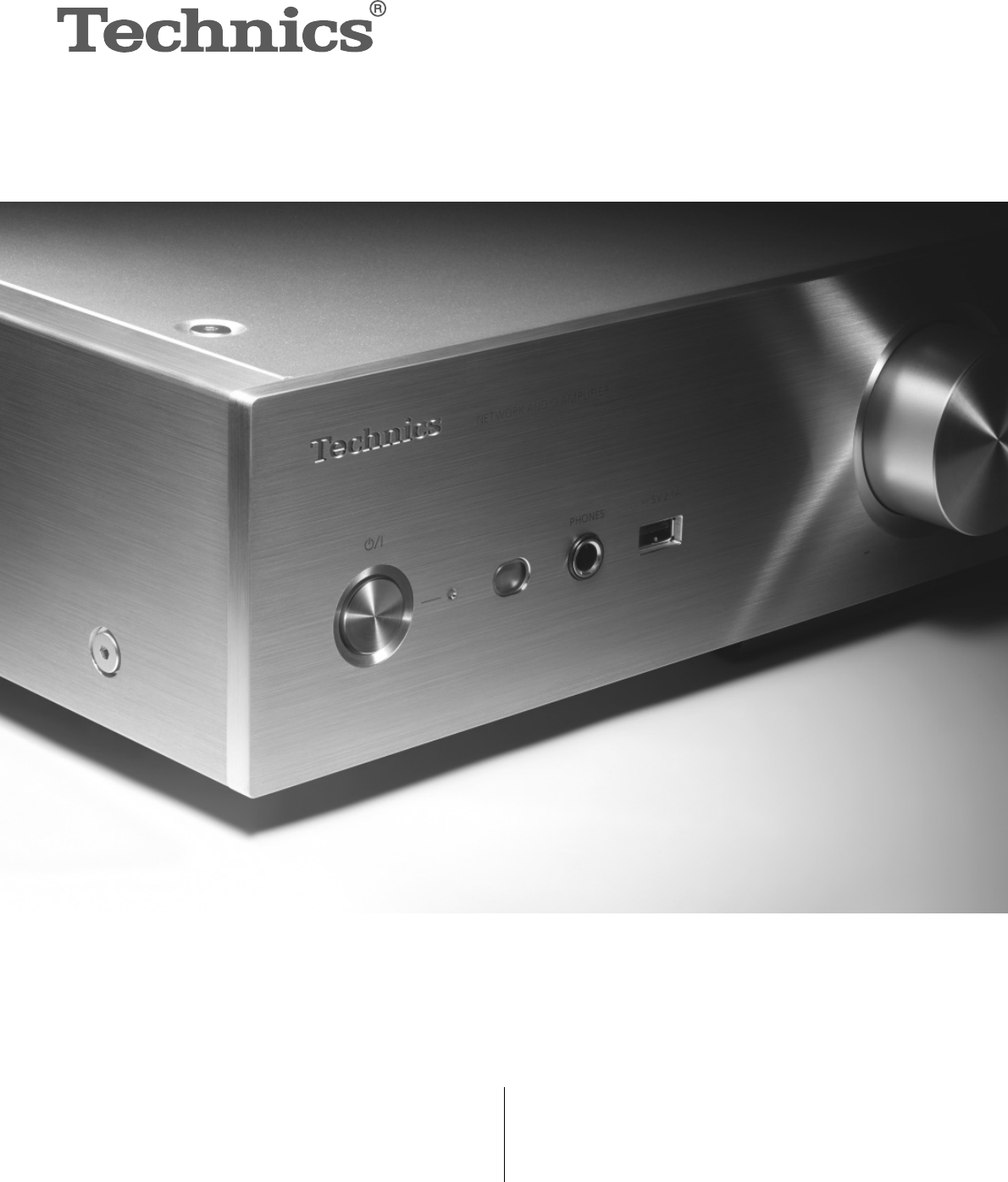
SU-G30
Network Audio Amplifier Owner’s Manual
Amplificateur lecteur réseau Manuel d’utilisation

03
(03)
Music is borderless and timeless, touching people’s
hearts across cultures and generations.
Each day the discovery of a truly emotive experience
from an unencountered sound awaits.
Let us take you on your journey to rediscover music.
Sans frontières, la musique est aussi intemporelle,
touchant le coeur des gens en traversant les cultures et
les générations.
Tous les jours, nous attendons la révélation d’une
expérience émotionnelle authentique à partir d’un son
venu de nulle part.
Permettez-nous de vous emmener en voyage pour
redécouvrir la musique.
04 (04)

05
(05)
Delivering the Ultimate Emotive Musical
Experience to All
At Technics we understand that the listening experience is not purely
about technology but the magical and emotional relationship between
people and music.
We want people to experience music as it was originally intended
and enable them to feel the emotional impact that enthuses and
delights them.
Through delivering this experience we want to support the
development and enjoyment of the world’s many musical cultures.
This is our philosophy.
With a combination of our love of music and the vast high-end audio
experience of the Technics team, we stand committed to building a
brand that provides the ultimate emotive musical experience by music
lovers, for music lovers.
Apportez à tous l’expérience musicale
empreinte d’émotions
Chez Technics, nous savons que l’expérience de l’écoute n’est pas
purement et simplement une question de technologie, mais de
relation magique entre les personnes et la musique.
Nous voulons que tout un chacun puisse ressentir la musique telle
qu’elle a été conçue à l’origine et lui permettre de ressentir le choc
émotionnel qu’il brûle de connaître.
En apportant ce vécu, nous cherchons à accompagner le
développement et le plaisir des nombreuses cultures musicales du
monde. Telle est notre philosophie.
Ici et maintenant, alliant l’amour de la musique et la grande
expérience musicale de l’équipe Technics, nous sommes pleinement
déterminés à construire une marque qui apporte le vécu musical
émotionnel aux fervents de la musique.
Director
Directeur
Michiko Ogawa

06
Thank you for purchasing this product.
Please read these instructions carefully before using this product, and save this manual for future use.
• About descriptions in this Owner’s Manual
- Pages to be referred to are indicated as “ ○○”.
- The illustrations shown may differ from your unit.
If you have any questions, visit:
U.S.A.: http://shop.panasonic.com/support
Canada: www.panasonic.ca/english/support
Register online at http://shop.panasonic.com/support (U.S. customers only)
High-Quality Audio Technologies
Employed including JENO Engine
and GaN-FET Driver
The JENO Engine transmits and processes audio
signals in full digital and with minimal jitter from
the input stage to the power stage. The GaN-
FET Driver performs high-speed switching with
minimal loss. The LAPC conducts speaker load
adaptive phase calibration to achieve ideal gain
and phase characteristics for any type of speaker.
Also, the low-distortion switching power supply
specifically designed for the SU-G30 which
stabilizes the output voltage realizes accurate
signal amplification Technics regards as ideal.
High-Quality Processing of All Types
of Signal Sources Ranging from
High-Res Audio Sources to Analog
Audio Sources
Supporting a diversity of input sources, such as
digital audio (DLNA, USB and Bluetooth®), iOS
devices and analogue audio (Line and Phono),
the SU-G30 digitally processes all types of signal
sources with the high-quality sound technology
developed by Technics.
Ideal Sound Quality and
Performance Realized by the
Integrated Simple Configuration.
The SU-G30 features a built-in network audio
circuit with thorough measures taken against
jitter and noise. It transmits digital audio data
through the shortest possible signal path from
the music sources all the way to the power stage
to pursue uncompromised sound quality with
extremely low signal degradation.
Features
(06)
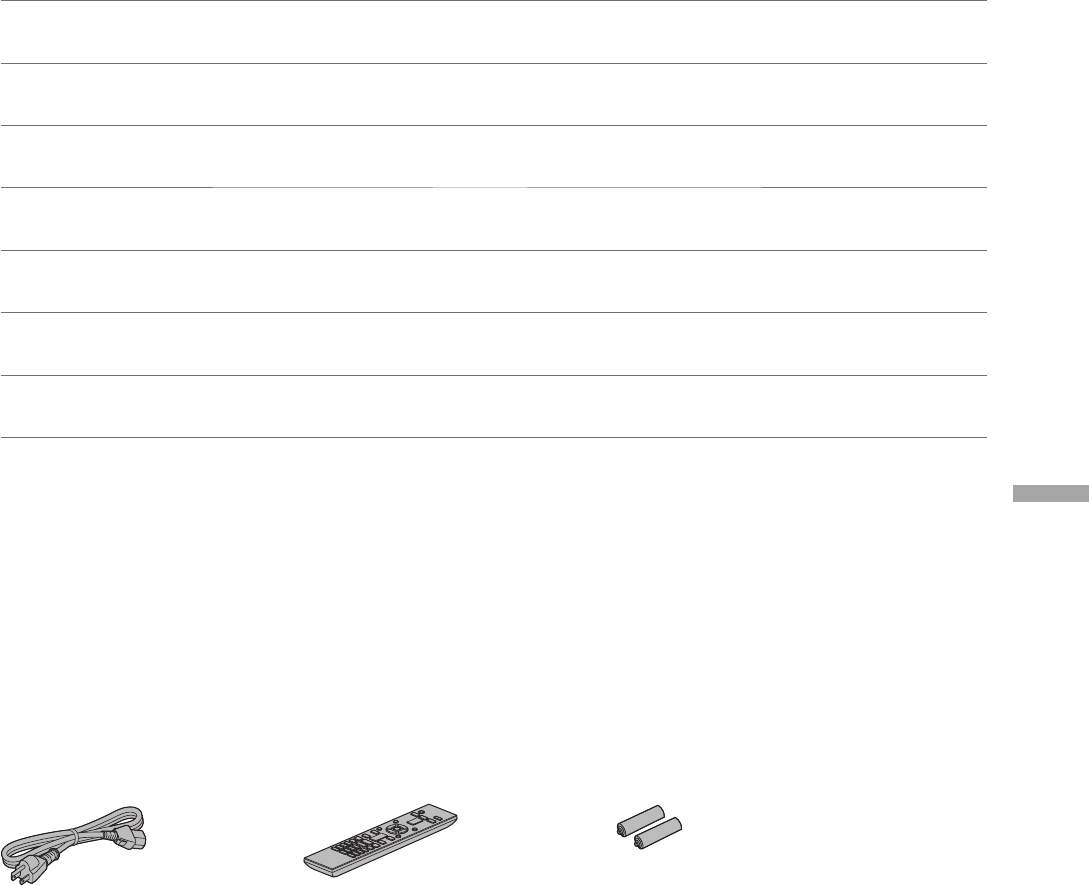
English
07
Table of contents
IMPORTANT SAFETY
INSTRUCTIONS 09 Please carefully read the “IMPORTANT SAFETY
INSTRUCTIONS” of this manual before use.
Installation 11 Installation
Control reference guide 12 Main unit, Remote control
Connections 16 Speaker connection, AC power supply cord
connection, Network settings
Operations 24 Playing back connected devices
Settings 36 Other settings, Using output correction function
(LAPC)
Troubleshooting 40 Before requesting service, read the
troubleshooting.
Others 45 Playable media, Specifications, etc.
Accessories
AC power supply cord (1)
K2CG3YY00191
Remote control (1)
N2QAYA000115
Batteries for remote
control (2)
(ONLY FOR CANADA)
The enclosed Canadian French label sheet corresponds to the English display on the unit.
• Product numbers provided in this Owner’s Manual are correct as of December 2015.
• These may be subject to change.
• Do not use AC power supply cord with other equipment.
(07)

08
Licenses
The Wi-Fi CERTIFIED™ Logo is a certification
mark of Wi-Fi Alliance®.
The Wi-Fi Protected Setup™ Identifier mark is
a certification mark of Wi-Fi Alliance®.
“Wi-Fi®” is a registered trademark of Wi-Fi
Alliance®.
“Wi-Fi Protected Setup™”, “WPA™”, and
“WPA2™” are trademarks of Wi-Fi Alliance®.
“Made for iPod”, “Made for iPhone”, and
“Made for iPad” mean that an electronic
accessory has been designed to connect
specifically to iPod, iPhone, or iPad,
respectively, and has been certified by the
developer to meet Apple performance
standards.
Apple is not responsible for the operation of
this device or its compliance with safety and
regulatory standards. Please note that the use
of this accessory with iPod, iPhone, or iPad
may affect wireless performance.
AirPlay, iPad, iPhone, iPod, iPod nano, and
iPod touch are trademarks of Apple Inc.,
registered in the U.S. and other countries.
iPad Air and iPad mini are trademarks of Apple
Inc.
Google Play and Android are trademarks of
Google Inc.
Windows is a trademark or a registered
trademark of Microsoft Corporation in the
United States and other countries.
Mac and OS X are trademarks of Apple Inc.,
registered in the U.S. and other countries.
The Bluetooth® word mark and logos are
registered trademarks owned by Bluetooth
SIG, Inc. and any use of such marks by
Panasonic Corporation is under license.
Other trademarks and trade names are those
of their respective owners.
aptX® software is copyright CSR plc or its
group companies. All rights reserved.
The aptX® mark and the aptX logo are
trademarks of CSR plc or one of its group
companies and may be registered in one or
more jurisdictions.
DLNA, the DLNA Logo and DLNA CERTIFIED
are trademarks, service marks, or certification
marks of the Digital Living Network Alliance.
MPEG Layer-3 audio coding technology
licensed from Fraunhofer IIS and Thomson.
Windows Media and the Windows logo
are trademarks or registered trademarks
of Microsoft Corporation in the United
States and/or other countries. This product
is protected by certain intellectual property
rights of Microsoft Corporation and third
parties. Use or distribution of such technology
outside of this product is prohibited without
a license from Microsoft or an authorized
Microsoft subsidiary and third parties.
FLAC Decoder
Copyright (C) 2000, 2001, 2002, 2003, 2004,
2005, 2006, 2007, 2008, 2009 Josh Coalson
Redistribution and use in source and binary
forms, with or without modification, are
permitted provided that the following
conditions are met:
- Redistributions of source code must retain
the above copyright notice, this list of
conditions and the following disclaimer.
- Redistributions in binary form must
reproduce the above copyright notice, this
list of conditions and the following disclaimer
in the documentation and/or other materials
provided with the distribution.
- Neither the name of the Xiph.org Foundation
nor the names of its contributors may be
used to endorse or promote products derived
from this software without specific prior
written permission.
THIS SOFTWARE IS PROVIDED BY THE
COPYRIGHT HOLDERS AND CONTRIBUTORS
“AS IS” AND ANY EXPRESS OR IMPLIED
WARRANTIES, INCLUDING, BUT NOT
LIMITED TO, THE IMPLIED WARRANTIES OF
MERCHANTABILITY AND FITNESS FOR A
PARTICULAR PURPOSE ARE DISCLAIMED.
IN NO EVENT SHALL THE FOUNDATION
OR CONTRIBUTORS BE LIABLE FOR ANY
DIRECT, INDIRECT, INCIDENTAL, SPECIAL,
EXEMPLARY, OR CONSEQUENTIAL DAMAGES
(INCLUDING, BUT NOT LIMITED TO,
PROCUREMENT OF SUBSTITUTE GOODS OR
SERVICES; LOSS OF USE, DATA, OR PROFITS;
OR BUSINESS INTERRUPTION) HOWEVER
CAUSED AND ON ANY THEORY OF LIABILITY,
WHETHER IN CONTRACT, STRICT LIABILITY,
OR TORT (INCLUDING NEGLIGENCE OR
OTHERWISE) ARISING IN ANY WAY OUT
OF THE USE OF THIS SOFTWARE, EVEN IF
ADVISED OF THE POSSIBILITY OF SUCH
DAMAGE.
(08)

English
09
IMPORTANT SAFETY INSTRUCTIONS
IMPORTANT SAFETY INSTRUCTIONS
Read these operating instructions carefully before
using the unit. Follow the safety instructions on the
unit and the applicable safety instructions listed below.
Keep these operating instructions handy for future
reference.
1 Read these instructions.
2 Keep these instructions.
3 Heed all warnings.
4 Follow all instructions.
5 Do not use this apparatus near water.
6 Clean only with dry cloth.
7 Do not block any ventilation openings. Install in
accordance with the manufacturer’s instructions.
8 Do not install near any heat sources such as
radiators, heat registers, stoves, or other apparatus
(including amplifiers) that produce heat.
9 Do not defeat the safety purpose of the polarized
or grounding-type plug. A polarized plug has two
blades with one wider than the other. A grounding-
type plug has two blades and a third grounding
prong. The wide blade or the third prong are
provided for your safety. If the provided plug does
not fit into your outlet, consult an electrician for
replacement of the obsolete outlet.
10 Protect the power cord from being walked on
or pinched particularly at plugs, convenience
receptacles, and the point where they exit from the
apparatus.
11 Only use attachments/accessories specified by the
manufacturer.
12 Use only with the cart, stand,
tripod, bracket, or table specified
by the manufacturer, or sold with
the apparatus. When a cart is used,
use caution when moving the cart/
apparatus combination to avoid injury
from tip-over.
13 Unplug this apparatus during lightning storms or
when unused for long periods of time.
14 Refer all servicing to qualified service personnel.
Servicing is required when the apparatus has been
damaged in any way, such as power-supply cord or
plug is damaged, liquid has been spilled or objects
have fallen into the apparatus, the apparatus has
been exposed to rain or moisture, does not operate
normally, or has been dropped.
Warning
Unit
• To reduce the risk of fire, electric shock or product
damage,
- Do not expose this unit to rain, moisture, dripping
or splashing.
- Do not place objects filled with liquids, such as
vases, on this unit.
- Use only the recommended accessories.
- Do not remove covers.
- Do not repair this unit by yourself. Refer servicing
to qualified service personnel.
- Do not let metal objects fall inside this unit.
- Do not place heavy items on this unit.
AC power supply cord
• The power plug is the disconnecting device.
Install this unit so that the power plug can be
unplugged from the socket outlet immediately.
• Ensure the earth pin on the power plug is securely
connected to prevent electrical shock.
- An apparatus with CLASS I construction shall
be connected to a power socket outlet with a
protective earthing connection.
Caution
Unit
• Do not place sources of naked flames, such as lighted
candles, on this unit.
• This unit may receive radio interference caused by
mobile telephones during use. If such interference
occurs, please increase separation between this unit
and the mobile telephone.
• Do not touch the top surface of this unit. This unit
becomes hot while it is on.
Placement
• Place this unit on an even surface.
• To reduce the risk of fire, electric shock or product
damage,
- Do not install or place this unit in a bookcase, built-
in cabinet or in another confined space. Ensure this
unit is well ventilated.
- Do not obstruct this unit’s ventilation openings
with newspapers, tablecloths, curtains, and similar
items.
- Do not expose this unit to direct sunlight, high
temperatures, high humidity, and excessive
vibration.
• Ensure that the placement location is sturdy enough
to accommodate the weight of this unit ( 47).
• Keep your speakers at least 10 mm (13/32”) away from
the system for proper ventilation.
• Do not lift or carry this unit by holding the knobs
or antenna. Doing so may cause this unit to fall,
resulting in personal injury or malfunction of this
unit.
Battery
• Danger of explosion if battery is incorrectly replaced.
Replace only with the type recommended by the
manufacturer.
• Mishandling of batteries can cause electrolyte
leakage and may cause a fire.
- Remove the battery if you do not intend to use the
remote control for a long period of time. Store in a
cool, dark place.
- Do not heat or expose to flame.
- Do not leave the battery(ies) in a car exposed to
direct sunlight for a long period of time with doors
and windows closed.
- Do not take apart or short circuit.
- Do not recharge alkaline or manganese batteries.
- Do not use batteries if the covering has been
peeled off.
- Do not mix old and new batteries or different types
at the same time.
• When disposing of the batteries, please contact your
local authorities or dealer and ask for the correct
method of disposal.
(09)
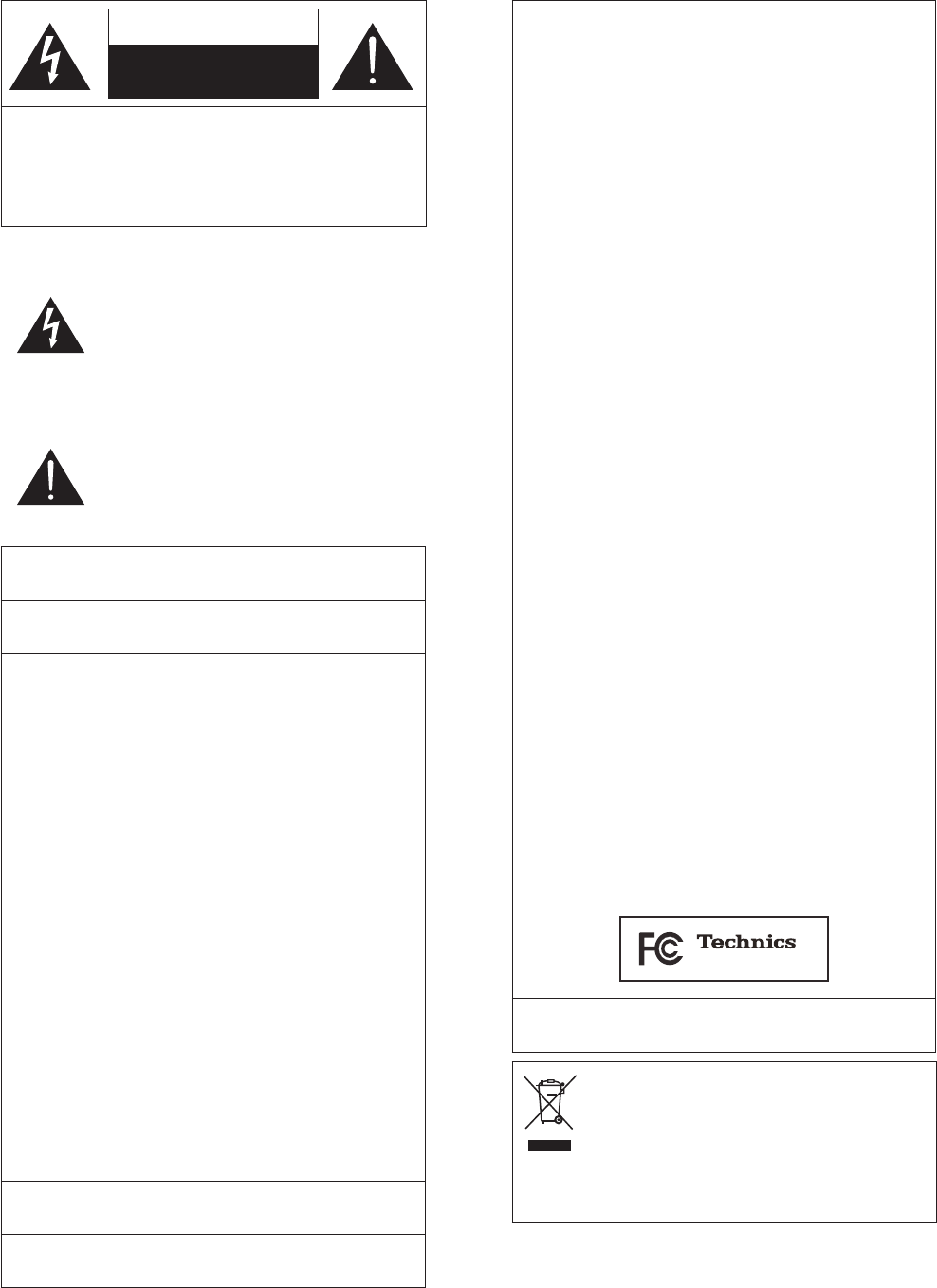
10
IMPORTANT SAFETY INSTRUCTIONS
CAUTION
RISK OF ELECTRIC SHOCK
DO NOT OPEN
CAUTION: TO REDUCE THE RISK OF ELECTRIC
SHOCK, DO NOT REMOVE SCREWS.
NO USER-SERVICEABLE PARTS INSIDE.
REFER SERVICING TO QUALIFIED
SERVICE PERSONNEL.
The lightning flash with arrowhead
symbol, within an equilateral triangle,
is intended to alert the user to the
presence of uninsulated “dangerous
voltage” within the product’s enclosure
that may be of sufficient magnitude
to constitute a risk of electric shock to
persons.
The exclamation point within an
equilateral triangle is intended to
alert the user to the presence of
important operating and maintenance
(servicing) instructions in the literature
accompanying the appliance.
Conforms to UL STD 60065.
Certified to CAN/CSA STD C22.2 No.60065.
Product Identification Marking is located on the rear
panel of the unit.
THE FOLLOWING APPLIES IN THE U.S.A. AND
CANADA.
This device complies with Part 15 of FCC Rules and
RSS-Gen of IC Rules.
Operation is subject to the following two conditions:
(1) This device may not cause interference, and
(2) this device must accept any interference, including
interference that may cause undesired operation of
this device.
FCC ID: ACJ-SU-G30
IC: 216A-SUG30
This transmitter must not be co-located or operated
in conjunction with any other antenna or transmitter.
This equipment complies with FCC/IC radiation
exposure limits set forth for an uncontrolled
environment and meets the FCC radio frequency
(RF) Exposure Guidelines in Supplement C to OET65
and RSS-102 of the IC radio frequency (RF) Exposure
rules. This equipment has very low levels of RF
energy that is deemed to comply without maximum
permissive exposure evaluation (MPE). But it is
desirable that it should be installed and operated
keeping the radiator at least 20 cm (7 7/8”) or more
away from person’s body (excluding extremities:
hands, wrists, feet and ankles).
This device is restricted to indoor use due to its
operation in the 5.15 to 5.25 GHz frequency range.
The WLAN feature of this product shall exclusively be
used inside buildings.
THE FOLLOWING APPLIES ONLY IN THE U.S.A.
FCC Note:
This equipment has been tested and found to comply
with the limits for a Class B digital device, pursuant to
Part 15 of the FCC Rules.
These limits are designed to provide reasonable
protection against harmful interference in a
residential installation. This equipment generates,
uses and can radiate radio frequency energy and,
if not installed and used in accordance with the
instructions, may cause harmful interference to radio
communications.
However, there is no guarantee that interference will
not occur in a particular installation. If this equipment
does cause harmful interference to radio or television
reception, which can be determined by turning the
equipment off and on, the user is encouraged to try
to correct the interference by one or more of the
following measures:
• Reorient or relocate the receiving antenna.
• Increase the separation between the equipment
and receiver.
• Connect the equipment into an outlet on a
circuit different from that to which the receiver is
connected.
• Consult the dealer or an experienced radio/TV
technician for help.
FCC Caution: To assure continued compliance,
follow the attached installation instructions and use
only shielded interface cables when connecting to
peripheral devices.
Any unauthorized changes or modifications to this
equipment would void the user’s authority to operate
this device.
Declaration of Conformity
Trade Name: Technics
Model No.: SU-G30
Responsible Party:
Panasonic Corporation of North America
Two Riverfront Plaza, Newark, NJ 07102-5490
Support Contact:
http://www.panasonic.com/contactinfo
SU-G30
THE FOLLOWING APPLIES ONLY IN CANADA.
CAN ICES-3(B)/NMB-3(B)
Information on Disposal in other
Countries outside the European Union
This symbol is only valid in the European
Union.
If you wish to discard this product, please
contact your local authorities or dealer and
ask for the correct method of disposal.
(10)

11
English
IMPORTANT SAFETY INSTRUCTIONS / Installation
Installation
• Turn off all equipment before connection and
read the appropriate operating instructions.
Unit care
• Pull out the AC power supply cord from the
outlet before maintenance. Clean this unit with
a soft cloth.
• When dirt is heavy, wring a wet cloth tightly to
wipe the dirt, and then wipe it with a soft cloth.
• Do not use solvents including benzine, thinner,
alcohol, kitchen detergent, a chemical wiper,
etc. This might cause the exterior case to be
deformed or the coating to come off.
Installation
(11)
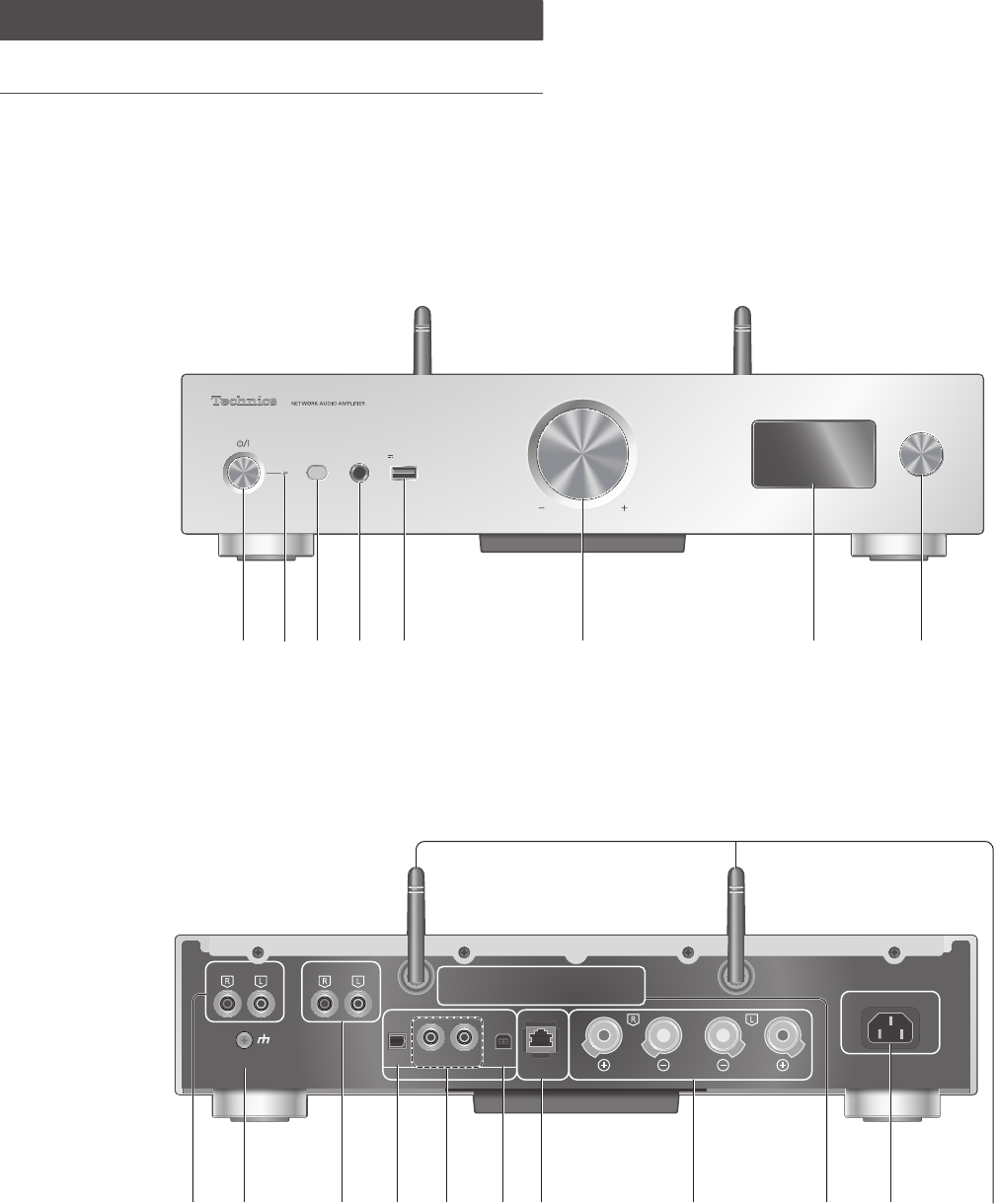
12
Control reference guide
Main unit
5V 2.1APHONES
VOLUME
INPUT SELECTOR
LAN
DIGITAL IN 10BASE-T /
100BASE-TX
SPEAKERS
(4∼16Ω)
AC IN ∼
OPT COAX1 COAX2 PC
PHONO
PHONO
EARTH
LINE IN
(12)

13
English
Control reference guide
01 Standby/on switch ( )
• Press to switch the unit from on to standby mode or vice versa. In
standby mode, the unit is still consuming a small amount of power.
02 Power indicator
• Blue: The unit is on.
• Red: The unit is in standby mode with the following status.
- Network standby function is available. ( 37)
- Charging an iPhone/iPad/iPod ( 29)
• Off: The unit is in standby mode with no function available.
03 Remote control signal sensor
• Distance: Within approx. 7 m (23 ft) directly in front
• Angle: Approx. 30° left and right
04 Headphones jack
• When a plug is connected, the speakers do not output sound.
• Excessive sound pressure from earphones and headphones can
cause hearing loss.
• Listening at full volume for long periods may damage the user’s
ears.
05 USB-A terminal
• Port for iPhone/iPad/iPod and USB devices ( 28, 29)
06 Volume knob
• -- dB (min), -99.0 dB to 0 dB (max)
• When this unit is muted, if you turn the knob, the muting will be
cancelled.
07 Display
• Input source, playback status, etc. are displayed. For details, visit:
www.technics.com/support/
08 Input selector knob
• Turn this knob clockwise or anticlockwise to switch the input
source.
09 Analog audio input terminals (PHONO) ( 34)
• MM cartridges are supported.
10 PHONO EARTH terminal ( 34)
• For connecting the ground wire of a record player.
11 Analog audio input terminals (LINE IN) ( 34)
12 Optical digital input terminal ( 32)
13 Coaxial digital input terminals ( 32)
14 USB-B terminal
• For connecting to a PC, etc. ( 33)
15 LAN terminal ( 18)
16 Speaker output terminals ( 16)
17 Product identification marking
• The model number is indicated.
18 AC IN terminal ( 17)
19 Wireless LAN antenna ( 19)
(13)
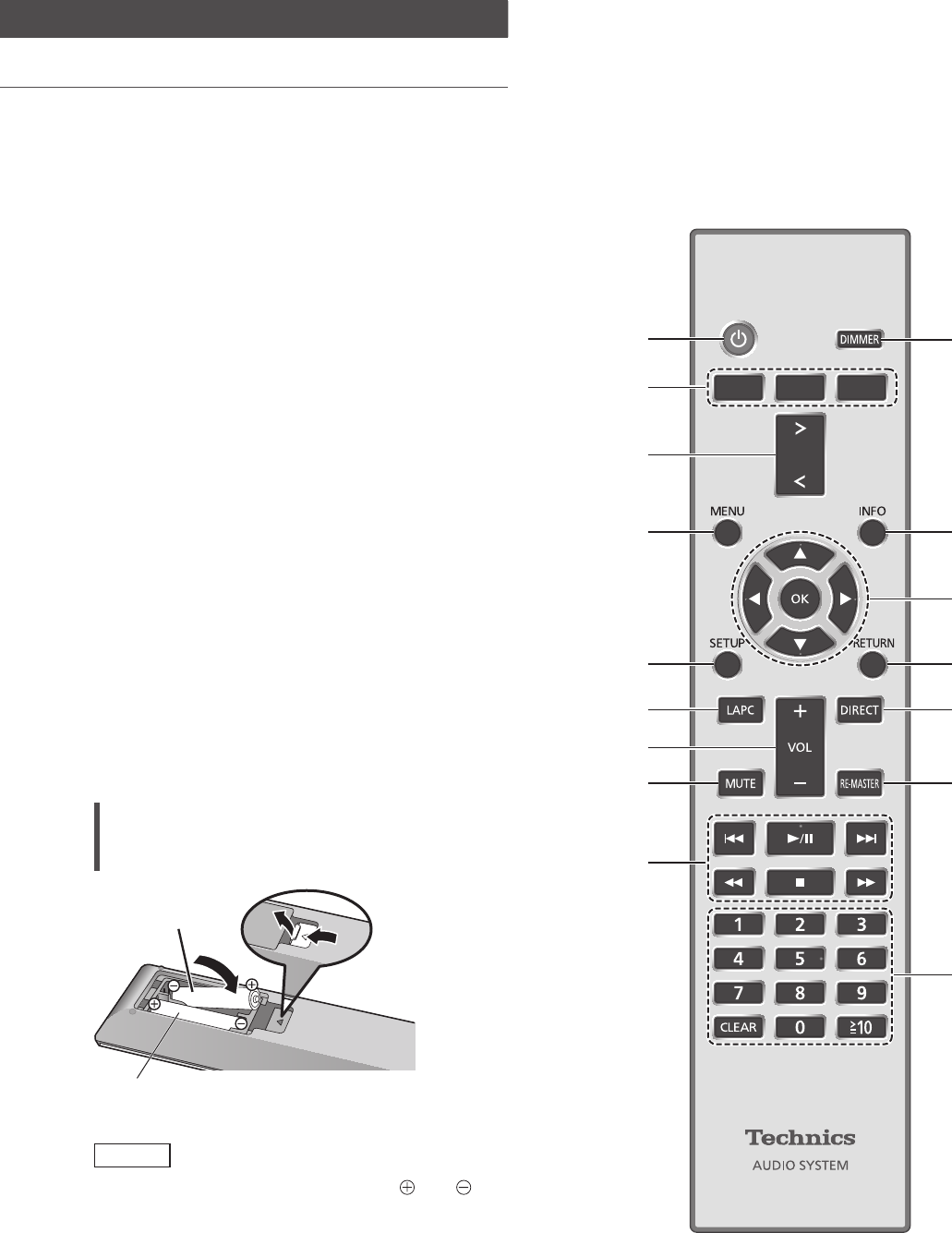
14
Control reference guide
Remote control
NET
DIGITAL
INPUT
ANALOG
Using the remote control
2
1
R03/LR03, AAA
(Alkaline or manganese batteries)
Note
• Insert the battery so the terminals ( and )
match those in the remote control.
• Point it at the remote control signal sensor on
this unit. ( 12)
• Keep the batteries out of reach of children to
prevent swallowing.
(14)

15
English
Control reference guide
Remote control code
When other equipment responds to the supplied
remote control, change the remote control code.
• The factory default is “Mode 1”.
1 Press [SETUP].
2 Press [ ], [ ] to select “Remote
Control” and then press [OK].
• The current remote control code of this unit
is displayed.
3 When “Set Mode 1/2” is displayed, set
the remote control code of the remote
control.
To set “Mode 1”:
Press and hold [OK] and [1] for at least 4
seconds.
To set “Mode 2”:
Press and hold [OK] and [2] for at least 4
seconds.
4 Point the remote control at this unit,
and press and hold [OK] for at least 4
seconds.
• When the remote control code is changed,
the new code will appear on the display for a
few seconds.
■ When “Remote 1” or “Remote 2” is
displayed
When “Remote 1” or “Remote 2” is displayed,
the remote control codes of this unit and remote
control are different. Perform step 3 above.
(15)
01 []: Standby/on switch
• Press to switch the unit from on to
standby mode or vice versa. In standby
mode, the unit is still consuming a small
amount of power.
02 [NET]/[DIGITAL]/[ANALOG]: Select the
device to be operated
( 24, 28, 29, 30, 31, 32, 33, 34)
03 [>INPUT<]: Switch the input source
04 [MENU]: Enter menu
( 24, 25, 27, 28, 30, 31)
05 [SETUP]: Enter setup menu ( 36)
06 [LAPC]: Measure the output signal of
the amplifier and correct its output
( 39)
07 [+VOL-]: Adjust the volume
• -- dB (min), -99.0 dB to 0 dB (max)
08 [MUTE]: Mute the sound
• Press [MUTE] again to cancel. “MUTE”
is also cancelled when you adjust the
volume or when you turn the unit to
standby.
09 Basic playback control buttons
10 [DIMMER]: Adjust the brightness of the
display, etc.
• When the display is turned off, it will
light up only when you operate this unit.
Before the display turns off again, “Display
Off” will be displayed for a few seconds.
• Press repeatedly to switch the brightness.
11 [INFO]: View content information
• Press this button to display the
track, artist, and album names, file
type, sampling frequency, and other
information. (The information varies
depending on the input source.)
12 [], [ ], [ ], [ ]/[OK]: Selection/OK
13 [RETURN]: Return to the previous
display
14 [DIRECT]: Turn on/off Direct mode
15 [RE-MASTER]: Turn on/off Re-master
16 Numeric buttons, etc.
• To select a 2-digit number
Example:
16: [ 10] > [1] > [6]
• To select a 4-digit number
Example:
1234: [ 10] > [ 10] > [ 10] > [1] > [2] > [3]
> [4]
• [CLEAR]: Clear the entered value.
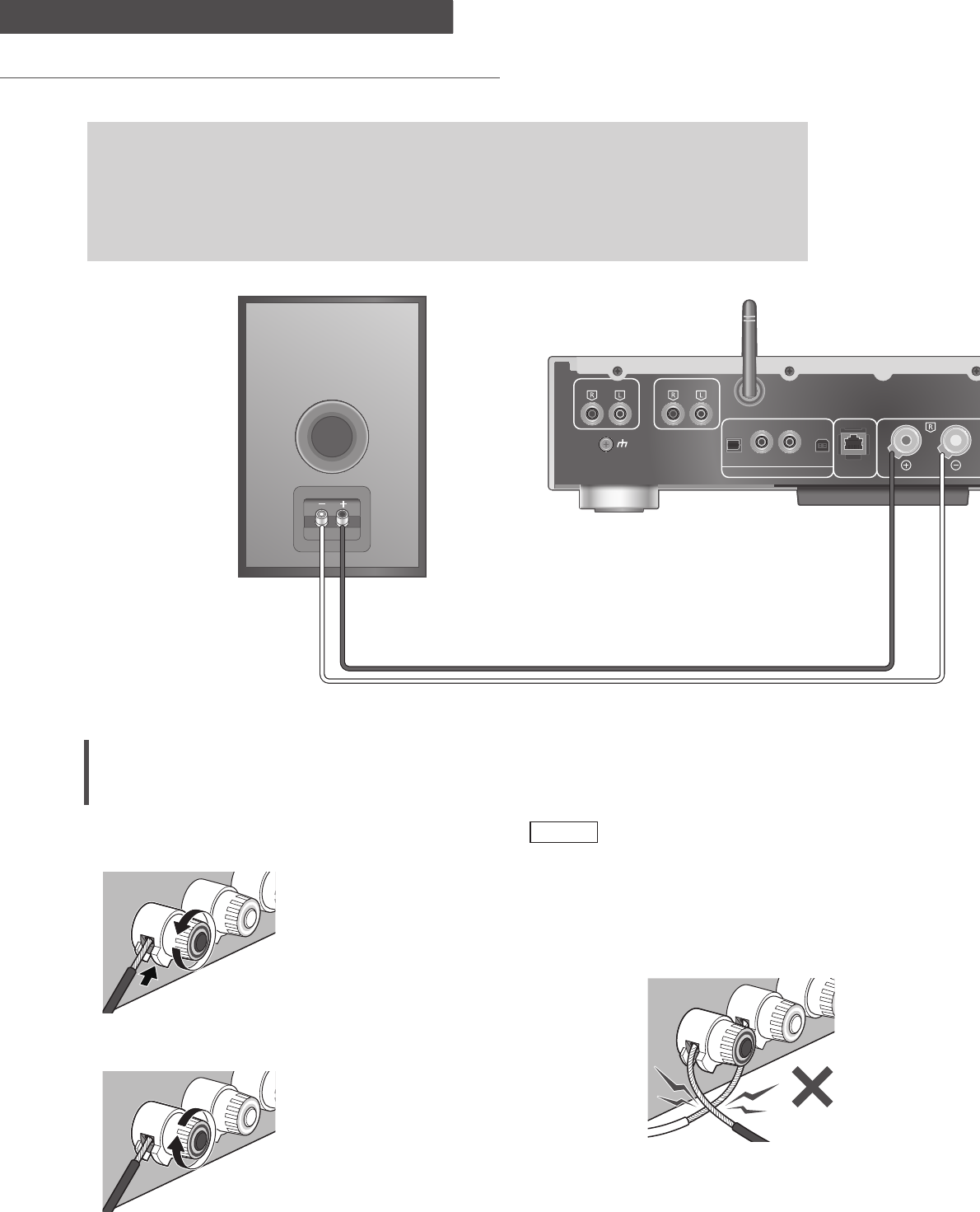
16
Connections
Speakers/AC power supply cord
LAN
DIGITAL IN 10BASE-T /
100BASE-TX
SPEA
(4∼
1
OPT COAX1 COAX2 PC
PHONO
PHONO
EARTH
LINE IN
LAN
DIGITAL IN 10BASE-T /
100BASE-TX
SPEA
(4∼
1
OPT COAX1 COAX2 PC
PHONO
PHONO
EARTH
LINE IN
• Use only the supplied AC power supply cord.
• Do not connect the AC power supply cord until all other connections are complete.
• Insert the plugs of the cables to be connected all the way in.
• Do not bend cables at sharp angles.
• To optimize the audio output, you can measure the amplifier output signal and correct its
output when it is connected to the speakers. ( 39)
(16)
Speaker cable (not supplied)
Speaker connection
1 Turn the knobs to loosen them, and
insert the core wires into the holes.
2 Tighten the knobs.
Note
• When the connections are completed, pull the
speaker cables lightly to check that they are
connected firmly.
• Be careful not to cross (short-circuit) or reverse
the polarity of the speaker wires as doing so
may damage the amplifier.
DO NOT
• Wire the polarity (+/-) of the terminals correctly.
Not doing so may adversely affect stereo
effects or cause malfunction.
• For details, refer to the operating instructions of
the speakers.
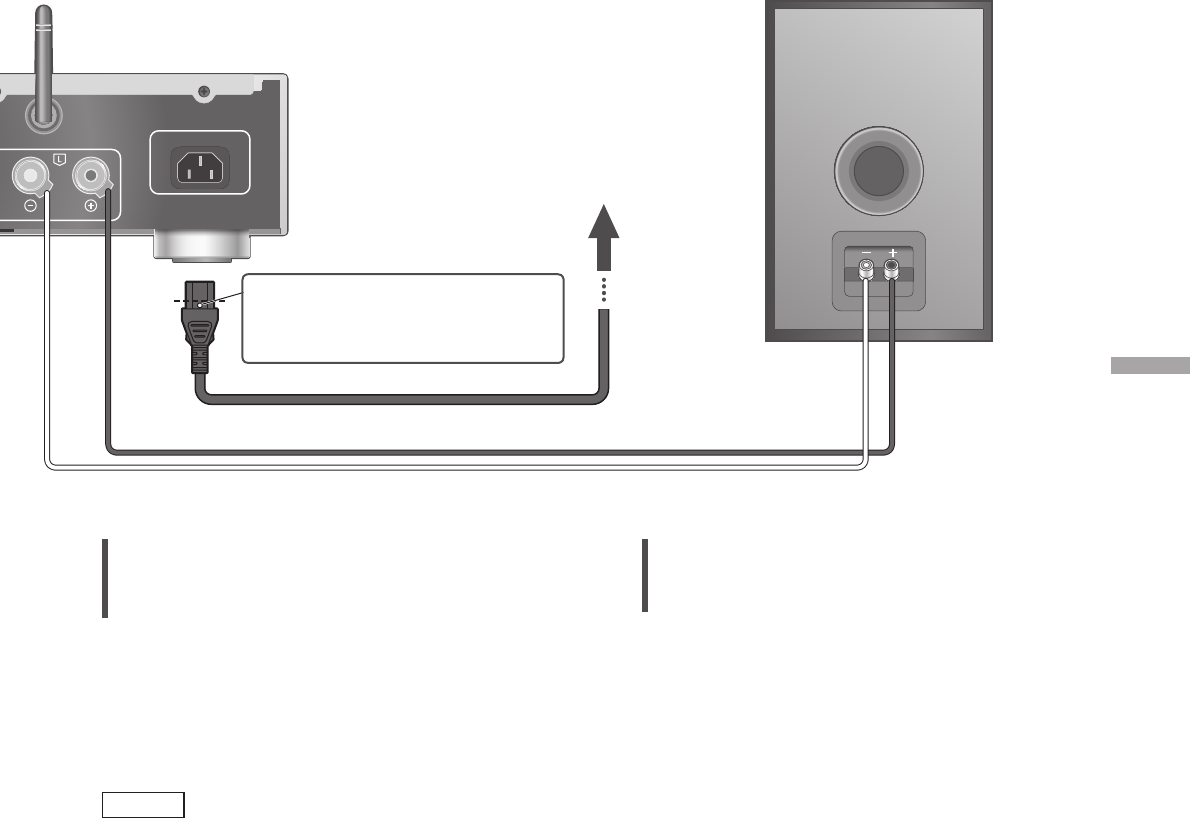
17
English
Connections
KERS
1
6Ω)
AC IN ∼
(17)
AC power supply cord connection
Connect only after all other connections are
completed.
• Wireless LAN (Wi-Fi®) setting may start when
this unit is turned on. If you stop the Wi-Fi
setting, select “Off” in “Wi-Fi Setup” screen.
Select “On” to keep the Wi-Fi setting. ( 19)
Note
• This unit consumes a small amount of AC power
( 47) even when the unit is in standby mode.
Remove the plug from the main electrical outlet
if you will not be using the unit for an extended
period of time. Place the unit so the plug can be
easily removed.
Speaker cable (not supplied)
AC power supply cord (supplied)
To a household
AC outlet
Insert the AC power supply cord
up to a point just before the
round hole.
Output correction function (LAPC)
You can make the optimum adjustment
according to your own speakers.
• When you select “Off” in “Wi-Fi Setup”, you
can set LAPC function ( 39).
• When you select “On” in “Wi-Fi Setup”, set the
wireless LAN connection first, and you can set
LAPC function ( 39).
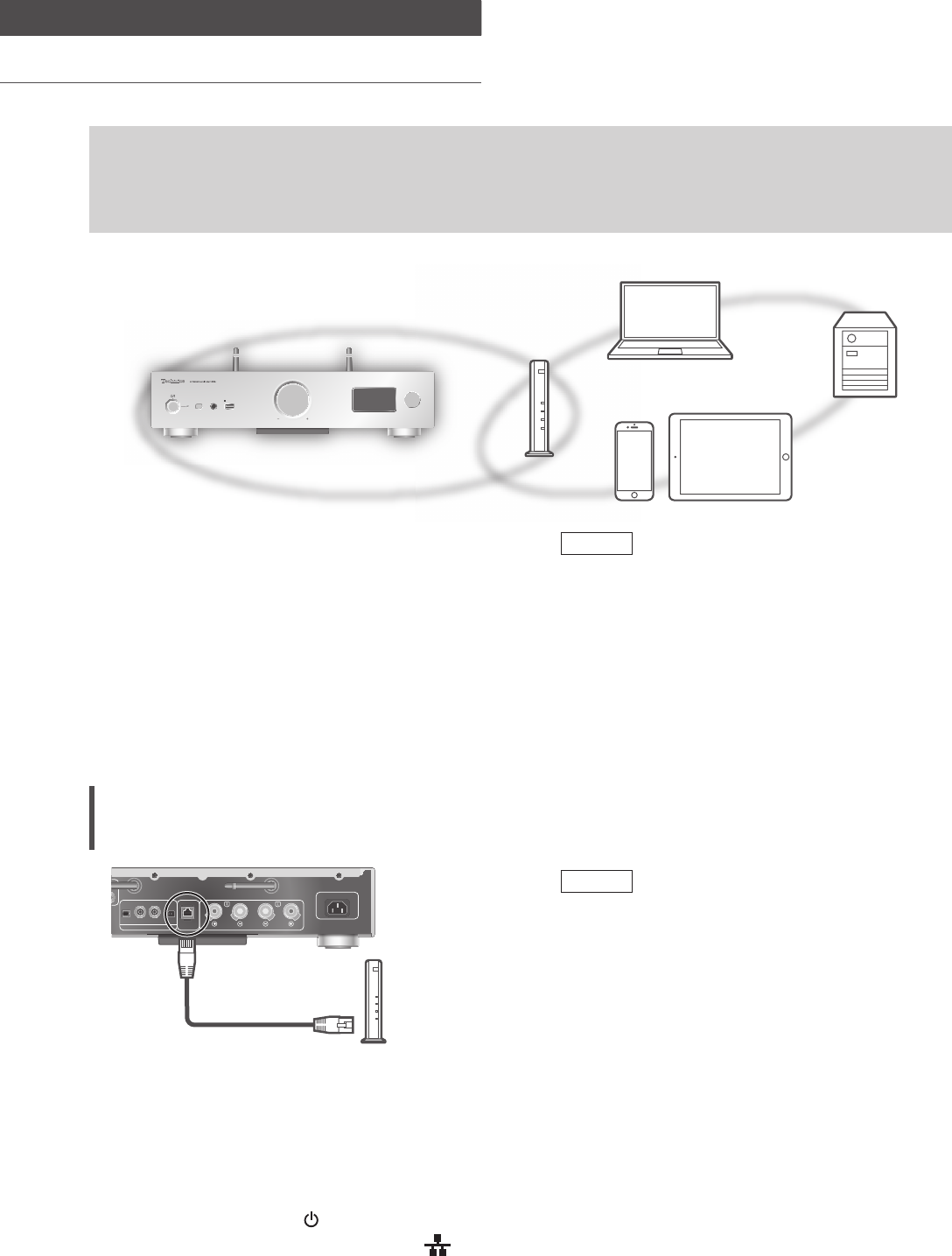
18
Connections
Network settings
Note
• If you try to change the network settings
immediately after turning on this unit, it may
take some time until the network setup screen
is displayed.
You can stream music from an iOS device (iPhone/iPad/iPod), an Android™ device or a PC (Mac/
Windows) to this unit by using the AirPlay or DLNA feature. ( 24, 26)
To use these features, this unit must join the same network as the AirPlay compatible device or the DLNA
compatible device.
This system can be connected to a router using a
LAN cable or built-in Wi-Fi®.
For a stable connection to the network, a wired
LAN connection is recommended.
Wired LAN connection
LAN
DIGITAL IN 10BASE-T /
100BASE-TX
SPEAKERS
(4∼16Ω)
AC IN ∼
OPT COAX1 COAX2 PC
Broadband
router, etc.
LAN cable
(not supplied)
1 Disconnect the AC power supply cord.
2 Connect this unit to a broadband
router, etc. using a LAN cable.
3 Connect the AC power supply cord to
this unit, and press [ ]. ( 17)
• When the connection is established, “ ” is
displayed.
Note
• While the AC power supply cord is
disconnected, the LAN cable must be
connected or disconnected.
• Use category 7 or above straight LAN cables
(STP) when connecting to peripheral devices.
• Inserting any cable other than a LAN cable in
the LAN port can damage the unit.
• If the LAN cable is disconnected, the network-
related settings return to default. Make the
settings again.
• When a LAN cable is connected, the Wi-Fi
function may be disabled.
(18)
5V 2.1APHONES
VOLUME
INPUT SELECTOR
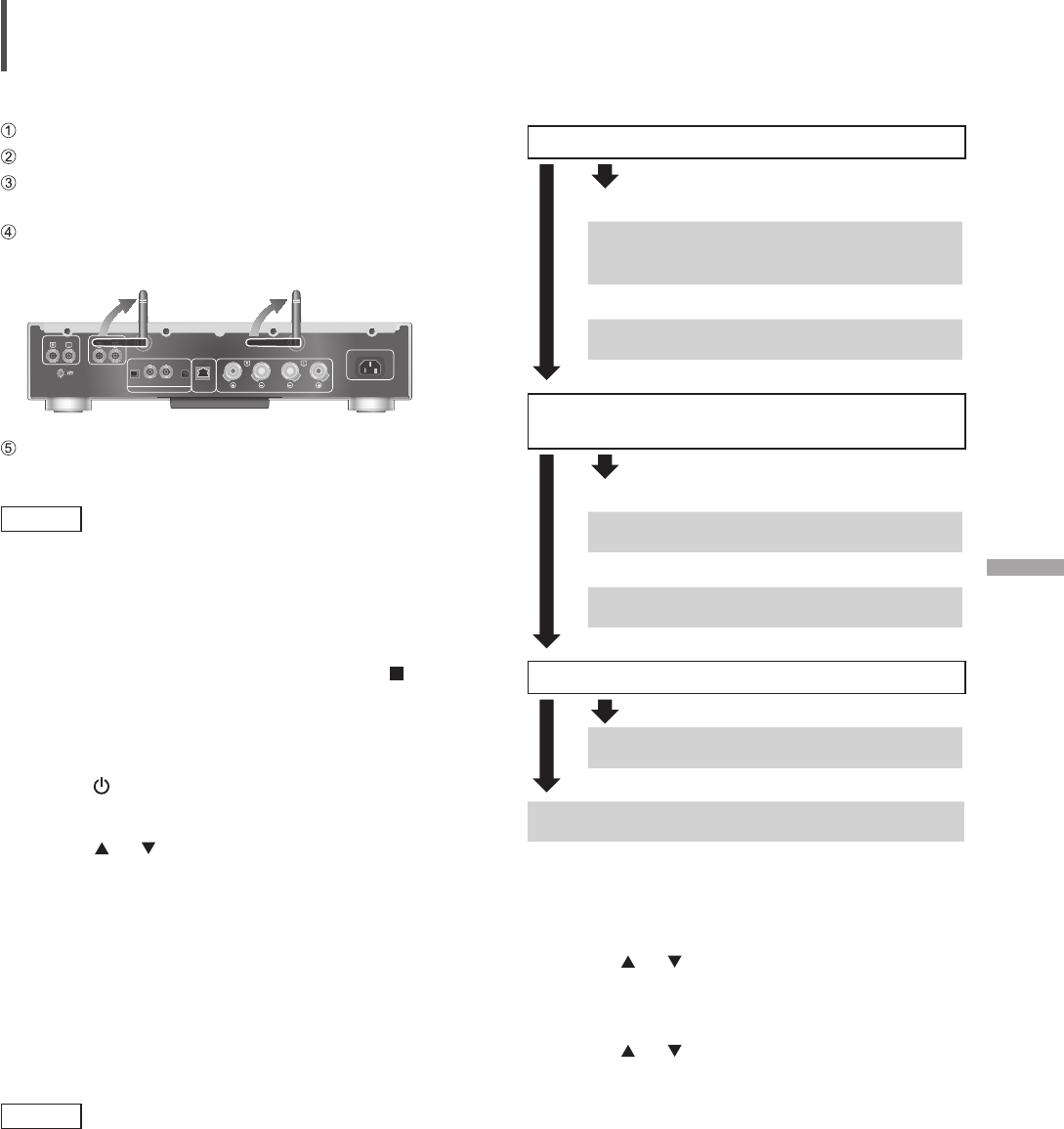
19
English
Connections
Wireless LAN connection
■ Preparation
Disconnect the AC power supply cord.
Disconnect the LAN cable.
Place this unit as close to the wireless router as
possible.
Point up the antenna on the rear of this unit as
shown in the figure.
LAN
DIGITAL IN 10BASE-T /
100BASE-TX
SPEAKERS
(4∼16Ω)
AC IN ∼
OPT COAX1 COAX2 PC
PHONO
PHONO
EARTH
LINE IN
LINE IN
Connect the AC power supply cord to this unit.
( 17)
Note
• Do not perform the following:
- Applying too much force to the antenna
- Carrying this unit by holding the antenna
• The setting will be cancelled after the set time
limit. In that case, try the setting again.
• To cancel this setting in the middle, press [ ] or
turn the unit to standby mode.
■ Settings for the first time
1 Press [ ] to turn this unit on.
• “Wi-Fi Setup” is displayed.
2 Press [ ], [ ] to select “On” and then
press [OK].
• “WAC Mode for iOS” automatically starts.
3 (For “WAC Mode for iOS”)
Proceed to step 2 of “Using the WAC
(Wireless Accessory Configuration)”
( 20).
(For other network setting method)
Choose a network setting method.
Note
• When this unit is switched to standby mode and
turned on before the Wi-Fi setting is complete,
“Wi-Fi Setup” is displayed. Perform the Wi-Fi
setting or select “Off”.
■ Choose a network setting method
Are you using an iPod touch/iPhone/iPad?
Yes
(iOS version 7.0 or later)
Using the WAC (Wireless Accessory
Configuration) ( 20)
(iOS version 5.0 or later)
Using iPhone/iPad/iPod ( 21)
No
Does your wireless network router support
WPS (Wi-Fi Protected Setup™)?
Yes
(WPS button)
Using the WPS button ( 20)
(WPS PIN code)
Using the WPS PIN code ( 21)
No
Are you using an Android device?
Yes
Using “Technics Music App” ( 22)
No
Using an internet browser ( 22)
■ Settings using [SETUP] menu
1 Press [SETUP].
2 Press [ ], [ ] repeatedly to select
“Network” and then press [OK].
• When “Wi-Fi” screen is displayed, press [OK].
3 Press [ ], [ ] to select “On” and then
press [OK]. (The wireless LAN function
is enabled.)
4 Choose a network setting method.
(19)
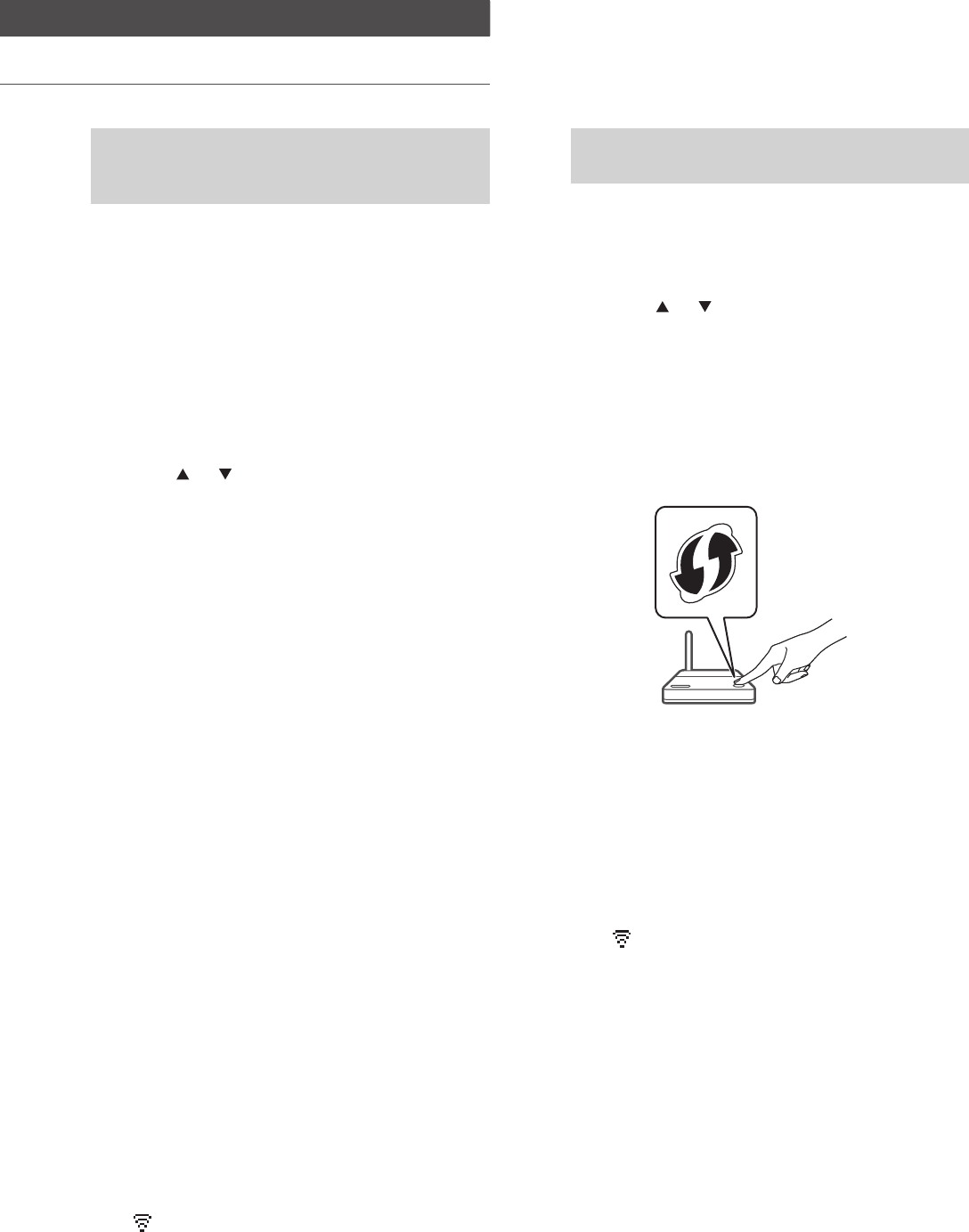
20
Connections
Network settings (Continued)
Using the WAC (Wireless Accessory
Configuration)
“WAC Mode for iOS”
You can send its Wi-Fi configuration to this
system using an iPhone/iPad/iPod touch.
• Supported device:
iPhone/iPad/iPod touch (iOS version 7.0 or
later), or Mac (OS X 10.9 or later, with AirPort
Utility 6.3.1. or later)
• The following explanations are based on an
iPhone.
• Make sure your iPhone is connected to your
home wireless network beforehand.
1 Press [ ], [ ] on the remote control to
select “WAC Mode for iOS” and then
press [OK].
• “Setting” is displayed.
2 Go to Wi-Fi settings on your iPhone.
3 Select “Technics SU-G30 ******”
under the “SET UP NEW AIRPLAY
SPEAKER...” on your iPhone.
• “******” stands for a character that is unique
to each set.
4 The “AirPlay Setup” screen appears on
your iPhone.
• This system will be displayed as “Technics
SU-G30 ******”. To change the name, enter
a new name to replace the existing one. You
can also do the renaming after the network
connection is set up. ( 23)
• You can set a password for this system under
“SPEAKER PASSWORD”. (You will need this
password if you make network settings by
internet browser next time.)
5 Select “Next” to apply the settings.
• “Linking” is displayed.
• When the connection is established,
“Success” is displayed.
- “Fail” may be displayed if the connection
was not complete. Try this method
again from [SETUP] menu. If “Fail” is still
displayed, try other methods ( 19).
6 Press [OK] on the remote control to
exit the setting.
• “ ” is displayed.
Using the WPS button
“WPS Push”
If your wireless router supports WPS, you can set
up a connection by pressing the WPS button.
• A compatible wireless router may have the WPS
identifier mark.
1 Press [ ], [ ] on the remote control
to select “WPS Push” and then press
[OK].
• “WPS” is displayed. Complete step 2 within 2
minutes.
2 After “WPS” is displayed, press the
WPS button on the wireless router.
Example:
• “Linking” is displayed.
• When the connection is established,
“Success” is displayed.
- “Fail” may be displayed if the connection
was not complete. Try this method
again from [SETUP] menu. If “Fail” is still
displayed, try other methods ( 19).
3 Press [OK] on the remote control to
exit the setting.
• “ ” is displayed.
(20)
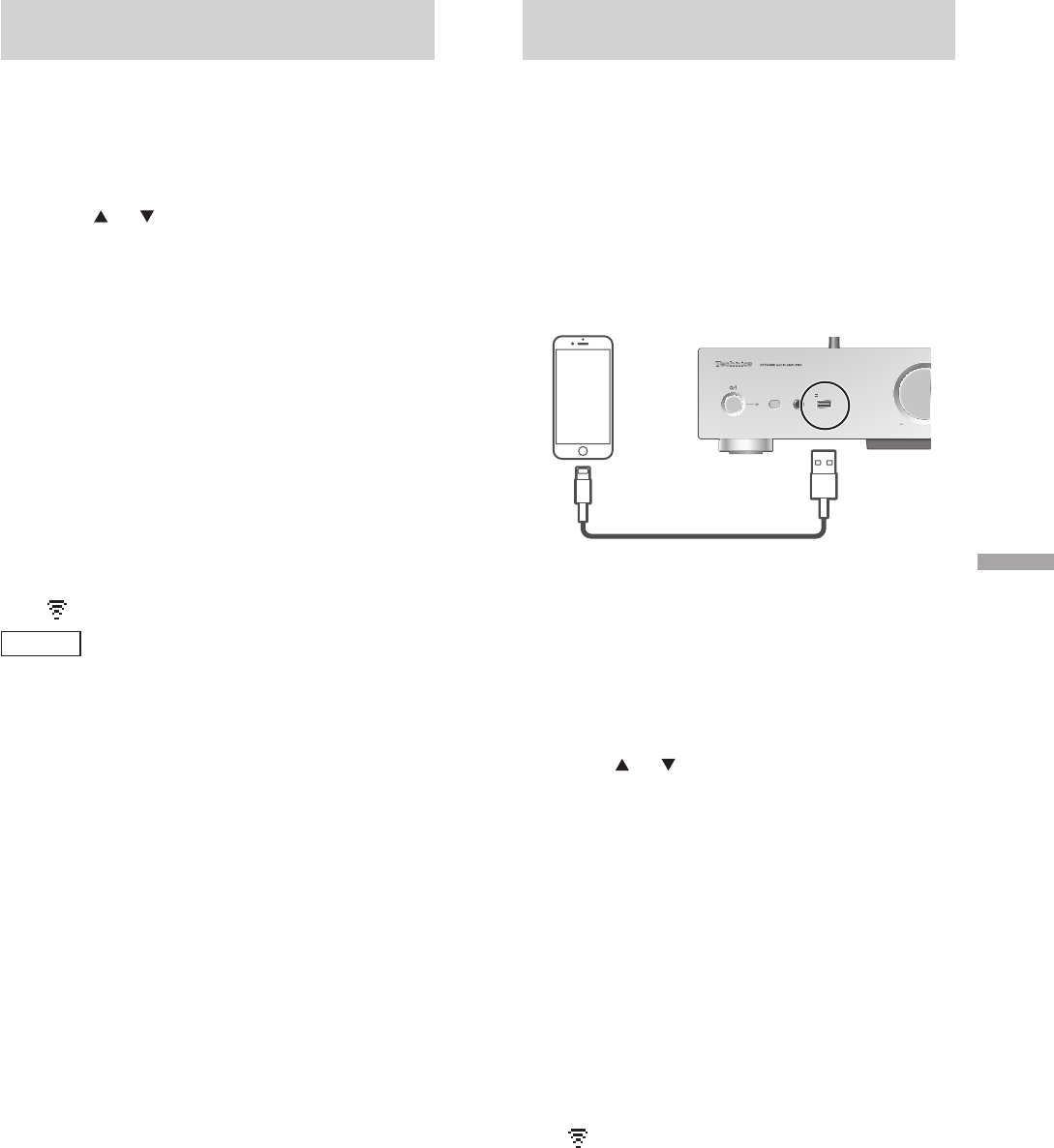
21
English
Connections
Using iPhone/iPad/iPod
“With iPod”
With this method you will share the wireless
network settings of your iPod/iPhone/iPad with
this system.
• Supported device:
iPhone/iPad/iPod touch (iOS version 5.0 or
later)
• The following explanations are based on an
iPhone.
• Make sure your iPhone is connected to your
home wireless network beforehand.
5V 2.1APHONES
VOLU
M
USB cable
(supplied with iPhone/iPad/iPod)
1 Connect the iPhone to this unit with
the USB cable.
• Use the USB cable supplied with iPhone/
iPad/iPod.
• Unlock your iPhone before connecting.
2 Press [ ], [ ] on the remote control
to select “With iPod” and then press
[OK].
• “Connecting Wi-Fi” is displayed.
3 Allow the iPhone to share the wireless
network settings.
• When the connection is established,
“Success” is displayed.
- “Fail” may be displayed if the connection
was not complete. Try this method
again from [SETUP] menu. If “Fail” is still
displayed, try other methods ( 19).
4 Press [OK] on the remote control to
exit the setting.
• “ ” is displayed.
Using the WPS PIN code
“WPS PIN”
If your wireless router supports WPS, you can set
up a connection by entering the WPS PIN code.
• For details on how to enter the PIN code, refer
to the operating instructions of the wireless
router.
1 Press [ ], [ ] on the remote control to
select “WPS PIN” and then press [OK].
• The PIN code is displayed. Complete step 2
within 2 minutes.
2 Enter the PIN code into the wireless
router from PC, etc.
• “Linking” is displayed.
• When the connection is established,
“Success” is displayed.
- “Fail” may be displayed if the connection
was not complete. Try this method
again from [SETUP] menu. If “Fail” is still
displayed, try other methods ( 19).
3 Press [OK] on the remote control to
exit the setting.
• “ ” is displayed.
Note
• Depending on a router, other connected
devices may temporarily lose their connection.
• For details, refer to the operating instructions of
the wireless router.
(21)

22
Connections
Network settings (Continued)
Using an internet browser
“Setup from Browser”
You can access this unit’s network settings from
the internet browser on iOS device (iOS version
6.1.6 or earlier), Android device, PC, etc.
• The following explanations are based on an
Android device.
1 Press [ ], [ ] on the remote control to
select “Setup from Browser” and then
press [OK].
• “Setting” is displayed.
2 Go to Wi-Fi settings on your
compatible device and select “00
Setup ******” to connect to this
system.
• “******” stands for a character that is unique
to each set.
3 Start the internet browser and type
“http://192.168.1.12/” into the URL
address field and display the page.
• Examples of internet browsers
- iOS device/Mac: Safari
- Android device: Google Chrome™
- PC: Windows Internet Explorer
4 Select “Search wireless network”.
5 Select your home wireless network
name (Network name (SSID)) and type
the password for this network.
6 Select “JOIN” to apply the settings.
• “Linking” is displayed.
• When the connection is established,
“Success” is displayed.
- “Fail” may be displayed if the connection
was not complete. Try this method
again from [SETUP] menu. If “Fail” is still
displayed, try other methods ( 19).
• Depending on the device, the connection
complete screen may not be displayed.
7 Make sure to connect your compatible
device back to your home wireless
network.
8 Press [OK] on the remote control to
exit the setting.
•
“ ” is displayed.
Note
•
Enable JavaScript and Cookies in your browser
settings.
Using “Technics Music App”
“Setup from Browser”
If you install the dedicated app “Technics
Music App” (free of charge) on your Android
device, you can set up a connection using the
application.
• If you’re using an Android device, download the
app at Google Play™.
• Check the password for your home wireless
network.
• Make sure your Android device is connected to
your home wireless network beforehand.
1 Press [ ], [ ] on the remote control to
select “Setup from Browser” and then
press [OK].
• “Setting” is displayed.
2 Start “Technics Music App” on the
Android device.
3 Select “ ” and go to Wi-Fi settings.
4 Enter the password for your home
wireless network.
5 Select “Next” to apply the settings.
• “Linking” is displayed.
• When the connection is established,
“Success” is displayed.
- “Fail” may be displayed if the connection
was not complete. Try this method
again from [SETUP] menu. If “Fail” is still
displayed, try other methods ( 19).
• Depending on the device, the connection
complete screen may not be displayed.
6 Make sure to connect your compatible
device back to your home wireless
network.
7 Press [OK] on the remote control to
exit the setting.
• “ ” is displayed.
(22)

23
English
Connections
This unit’s name on the network
“Friendly Name”
You can change this unit’s name on the network
(e.g. “Room 1” or “Living Room” etc.).
1 Press [SETUP].
2 Press [ ], [ ] repeatedly to select
“Network” and then press [OK].
3 Press [ ], [ ] repeatedly to select
“Friendly Name” and then press [OK].
• The current name of this unit is displayed.
Press [OK] to edit.
4 Press [ ], [ ], [ ], [ ] to input the
friendly name.
• Only ASCII characters can be used.
• “A” can be added when you press the
[] at the time of the last letter of the
Friendly Name is selected.
• Press [CLEAR] to delete a letter.
• Press [ 10] to insert a letter “A”.
• Default name is “Technics SU-G30 ******”.
“******” stands for a digit that is unique to
each set.
5 Press [OK] to apply the settings.
6 Press [RETURN] repeatedly to exit the
settings.
To make network-related settings
You can set specific IP address, subnet mask,
default gateway, primary DNS, etc. (If your
network requires specific settings, disable DHCP.)
• Do not play back music while changing these
settings.
1 Press [SETUP].
2 Press [ ], [ ] repeatedly to select
“Network” and then press [OK].
3 Select and input the details.
4 Press [OK] to apply the settings.
5 Press [RETURN] repeatedly to exit the
settings.
6 Press [ ] to switch the unit to standby.
• Wait until “Please Wait” disappears.
7 Perform the network setting. ( 18)
(23)
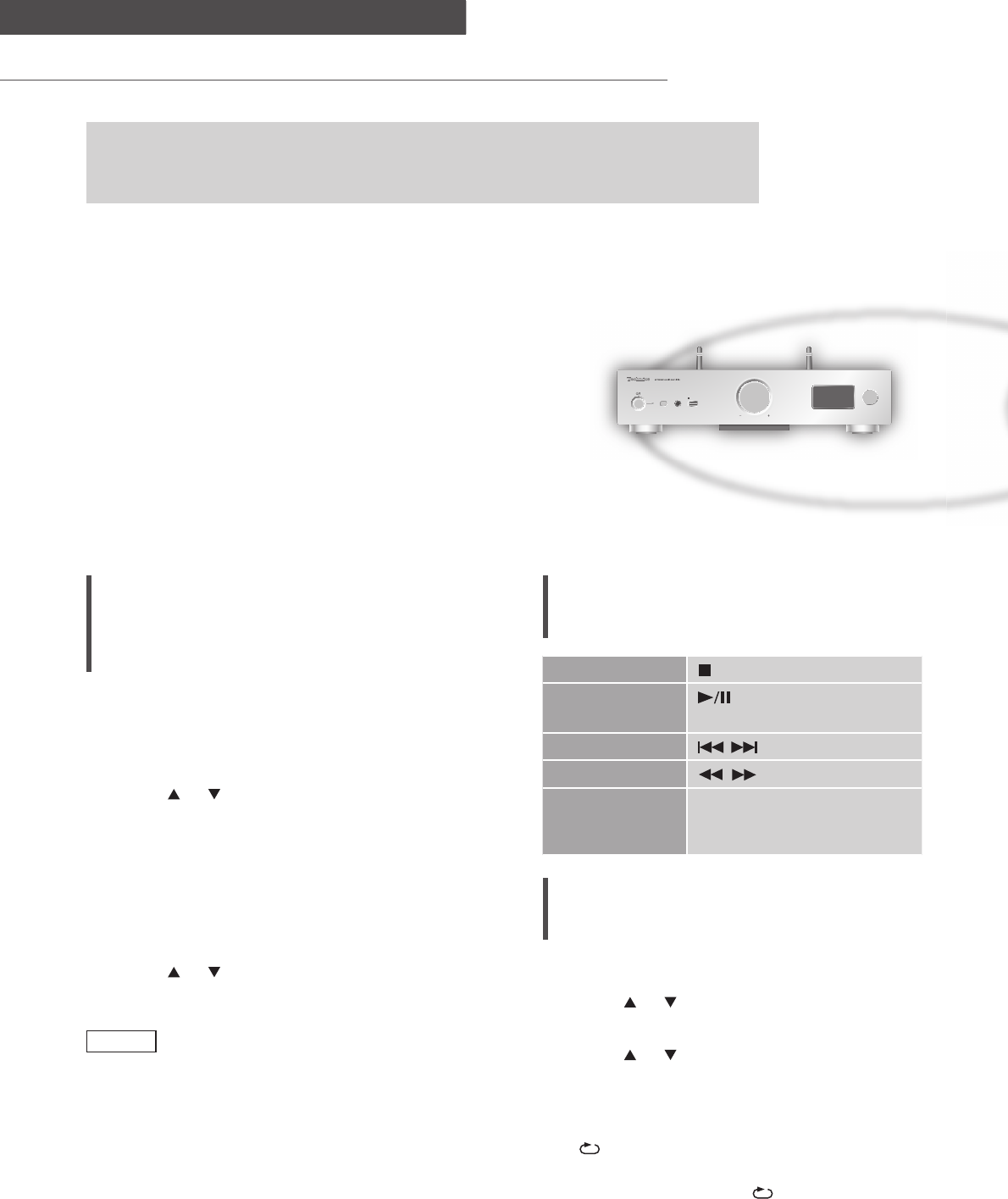
24
Operations
Playing back music files on the DLNA server
5V 2.1APHONES
VOLUME
INPUT SELECTOR
(24)
You can share music files stored in the DLNA Certified media server (PC, Network
Attached Storage, etc.) connected to your home network, and enjoy the contents
with this unit.
■ Preparation
• Complete the network settings. ( 18)
• Connect the device to be used to the
same network as this unit.
• To use Windows Media® Player
- Add the contents and folder to the
libraries of the Windows Media® Player
11 or 12, or a smartphone, etc.
- Playlist of Windows Media® Player can
play back only the contents that are
stored in the libraries.
- To use Windows Media® Player for
streaming, you need to configure it in
advance.
Playing back content stored on the
DLNA server by controlling it from
this unit
1 Press [NET] to select “DMP”.
• The server selection screen will be displayed.
• You can also select the input source by
turning the input selector knob on the unit.
2 Press [ ], [ ] to select a DLNA server
on the network, and then press [OK].
• The folder/content selection screen will be
displayed. Repeat this step to make further
selections.
• Folders/content may be displayed in
different order from the order on the server,
depending on its specifications.
3 Press [ ], [ ] to select an item and
then press [OK].
Note
• The connected server and its contents may
not be displayed properly depending on its
condition. (e.g. soon after adding the contents
to the server, etc.)
Please try again later. For details, refer to the
operating instructions of the device.
Operations during playback
Stop
Pause
• Press again to restart play.
Skip
Search
Viewing
available
information [INFO]
Repeat playback
“Repeat”
1 Press [MENU].
2 Press [ ], [ ] repeatedly to select
“Repeat” and then press [OK].
3 Press [ ], [ ] to select an item and
then press [OK].
1-Track:
Only plays the selected track.
(“1 ” is displayed.)
All:
All tracks are repeated. (“ ” is displayed.)
• Setting is available even when the input source
is switched to “USB” ( 28).
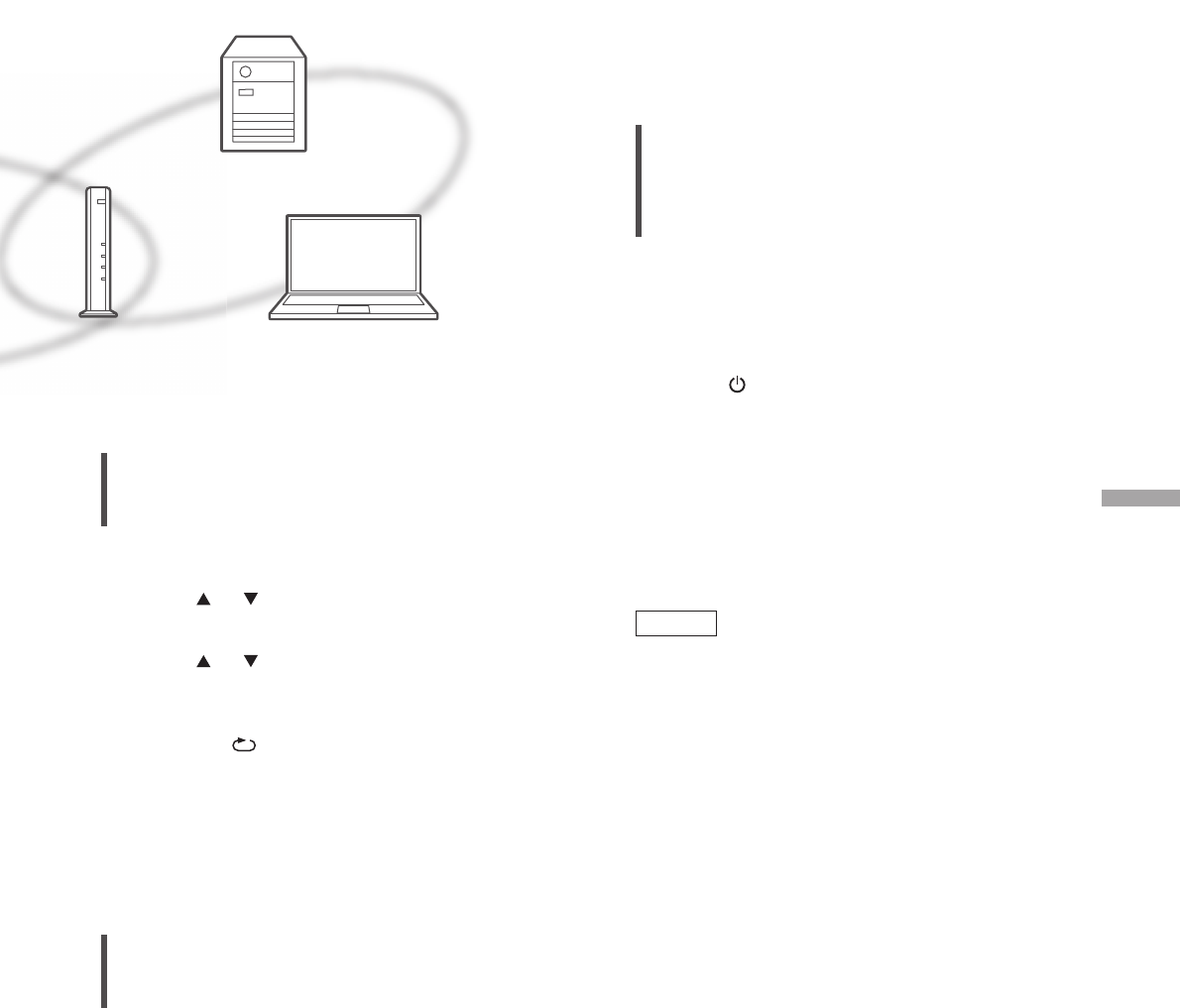
25
English
Operations
(25)
Playing back content stored on the
DLNA server by controlling it from a
DMC
By controlling a DMC (Digital Media Controller)
compatible device, you can play back music
stored on the DLNA server on this unit (DMR-
Digital Media Renderer).
1 Press [ ] to turn this unit on.
2 Operate the DMC compatible device
and connect to this unit.
• The device name of this unit will be displayed
as “Technics SU-G30 ******”*1, 2.
• For details on how to use DMC compatible
devices, refer to the operating instructions of
the devices or the software.
Note
• When you operate DMC, playback of other
audio sources will stop and DLNA output will
have priority.
• Depending on the contents and the connected
equipment, operations or playback may not be
possible.
• This unit does not guarantee connection with
all DMC applications. Use the dedicated app
“Technics Music App”.
* 1: “******” stands for a digit that is unique to
each set.
* 2: The device name can be changed from “This
unit’s name on the network”. ( 23)
Random repeat playback
“Random”
1 Press [MENU].
2 Press [ ], [ ] repeatedly to select
“Random” and then press [OK].
3 Press [ ], [ ] to select “On” and then
press [OK].
• All tracks in the folder are repeated randomly.
(“RND” and “ ” are displayed.)
• During random playback, you cannot skip to the
previous track.
• During random playback, tracks may be played
more than once.
• Setting is available even when the input source
is switched to “USB” ( 28).
Operations using the dedicated app
“Technics Music App”
If you install the dedicated app “Technics
Music App” (free of charge) on your tablet/
smartphone, you can control this unit using a
wide variety of functions.
For details, visit:
www.technics.com/support/
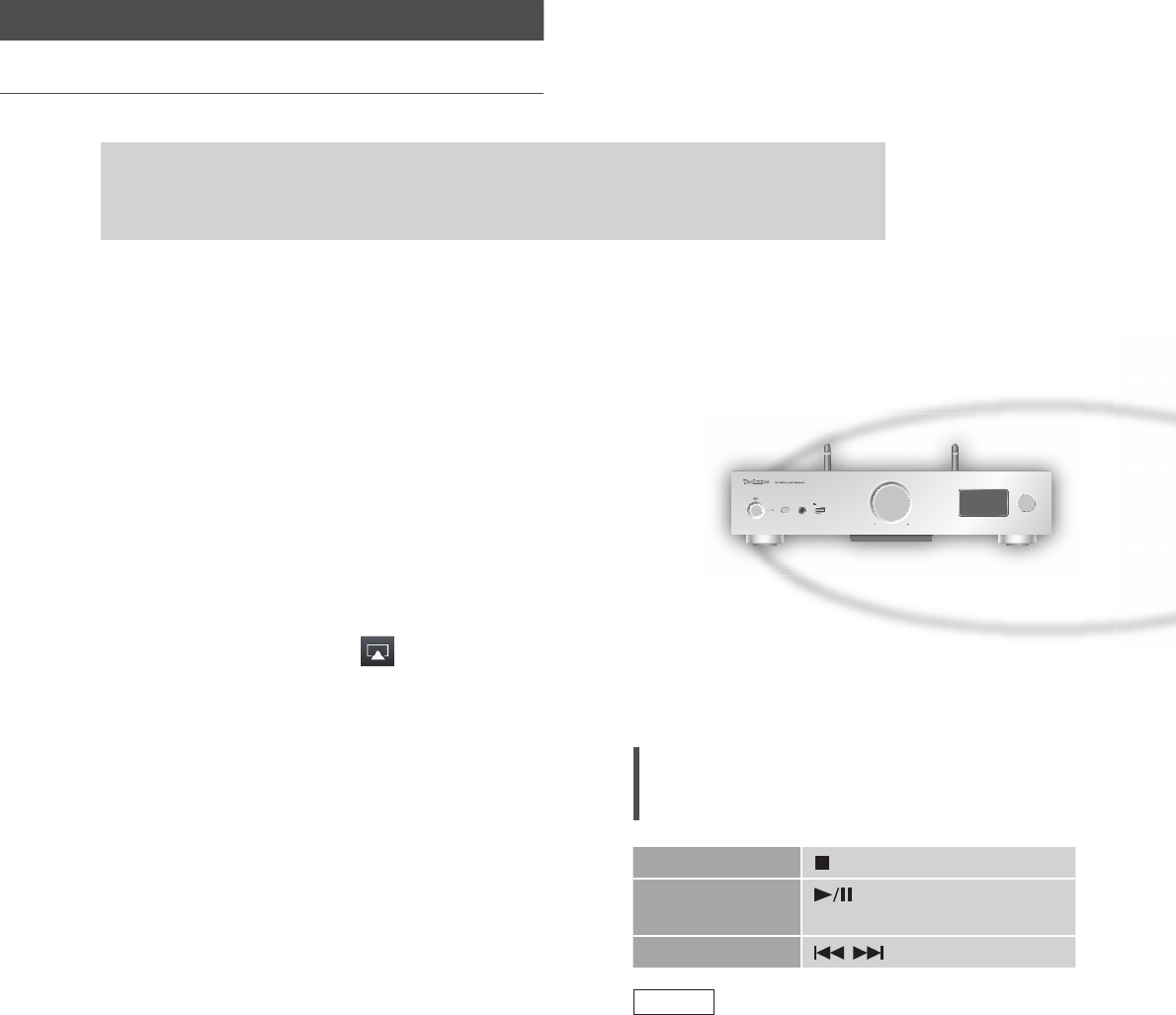
26
Operations
Using AirPlay
5V 2.1APHONES
VOLUME
INPUT SELECTOR
You can play back music stored on iOS device, etc. using AirPlay.
• AirPlay works with iPhone, iPad, and iPod touch with iOS 4.3.3 or later, Mac with
OS X Mountain Lion or later, and PC with iTunes 10.2.2 or later.
■ Preparation
• Complete the network settings. ( 18)
• Connect the iOS device or PC to the same
network as this unit.
1 (iOS device)
Start the “Music” (or iPod) app.
(PC)
Start “iTunes”.
2 Select “Technics SU-G30 ******”*1, 2
from the AirPlay icon .
3 Start play.
• Check the volume settings before starting the
playback.
• When AirPlay is used for the first time, the
volume may be output at the maximum setting.
• The playback will start with a slight delay.
* 1: “******” stands for a digit that is unique to
each set.
* 2: The device name can be changed from “This
unit’s name on the network”. ( 23)
Operations during playback
Stop
Pause
• Press again to restart play.
Skip
Note
• Playback of other audio sources will stop and
AirPlay output will have priority.
• Volume changes on the iOS device or iTunes will
apply to this unit. (Refer to the iTunes Help for
the required settings in iTunes.)
• With some iOS and iTunes versions, it may not
be possible to restart the AirPlay playback if
the selector is changed or the unit is turned
to standby mode, during the AirPlay playback.
In this case, select a different device from the
AirPlay icon of the Music app or iTunes and
then re-select this unit as the output speakers.
• AirPlay will not work when playing back videos
on iTunes.
(26)
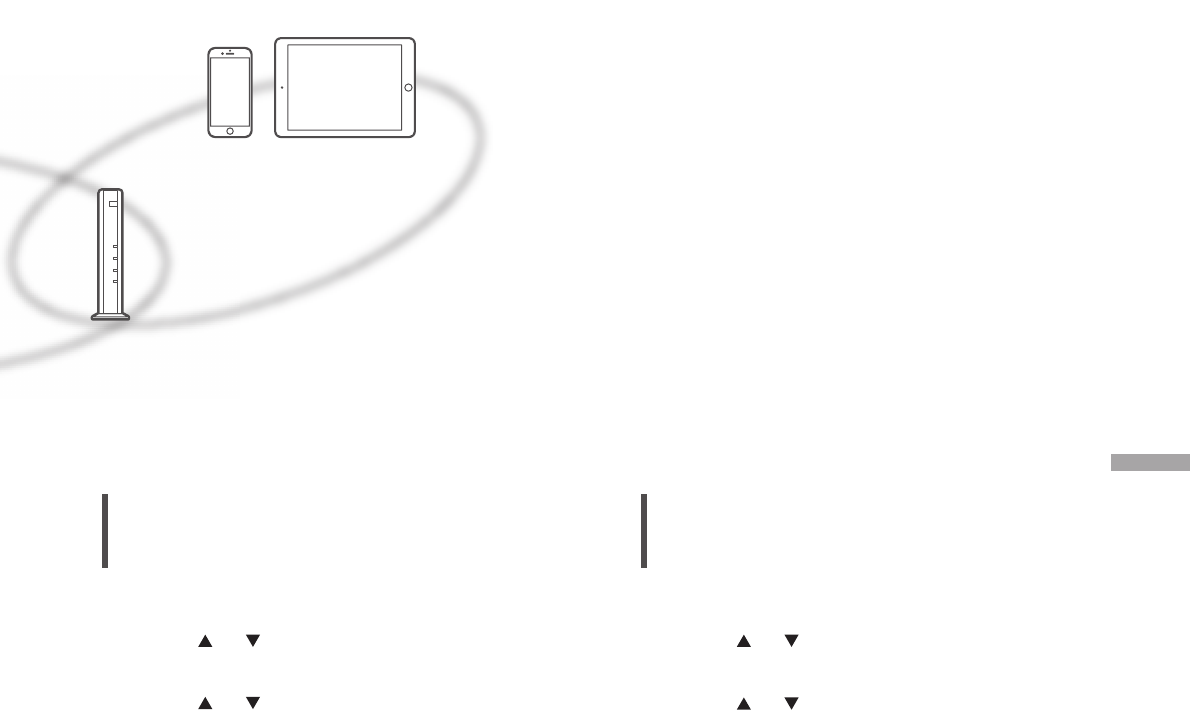
27
English
Operations
Repeat playback
“Repeat”
1 Press [MENU].
2 Press [ ], [ ] repeatedly to select
“Repeat” and then press [OK].
3 Press [ ], [ ] to set, and press [OK].
• Refer to the connected device to verify the
selected setting.
• You can also set on the connected iOS device/
PC.
Random repeat playback
“Shuffle”
1 Press [MENU].
2 Press [ ], [ ] repeatedly to select
“Shuffle” and then press [OK].
3 Press [ ], [ ] to set, and press [OK].
• Refer to the connected device to verify the
selected setting.
• You can also set on the connected iOS device/
PC.
(27)
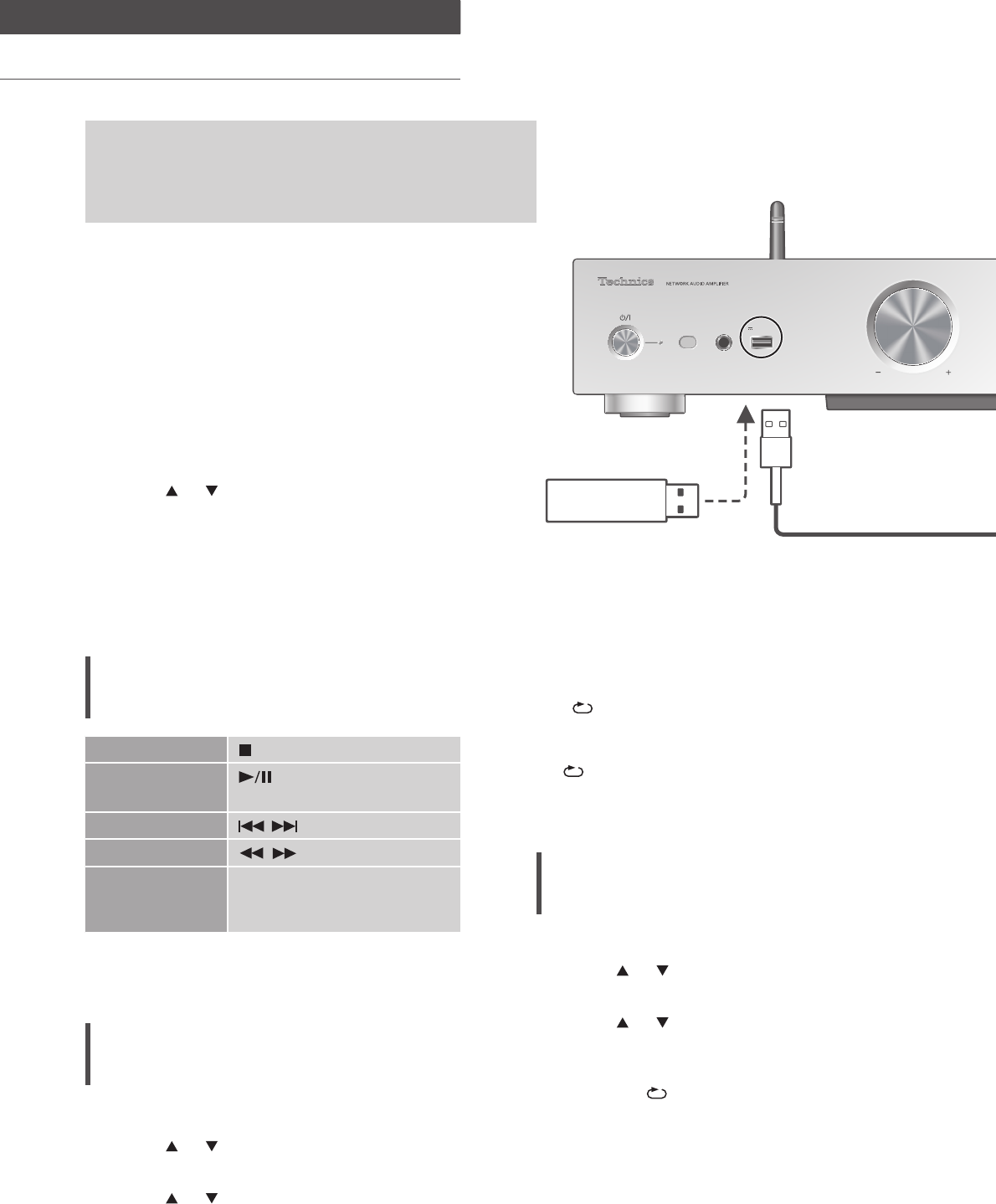
28
Operations
Using USB device
5V 2.1APHONES
VOLUME
(28)
1 Connect a USB device to the unit.
2 Press [DIGITAL] repeatedly to select
“USB”.
• The folder/content selection screen will be
displayed.
• You can also select the input source by
turning the input selector knob on the unit.
3 Press [ ], [ ] to select an item and
then press [OK].
• Repeat this step to make further selections.
• Press [RETURN] to return to the previous
folder.
Operations during playback
Stop
Pause
• Press again to restart play.
Skip
Search
Viewing
available
information [INFO]
• This operation may not be available for some
formats.
Repeat playback
“Repeat”
1 Press [MENU].
2 Press [ ], [ ] repeatedly to select
“Repeat” and then press [OK].
3 Press [ ], [ ] to select an item and
then press [OK].
1-Track:
Only plays the selected track.
(“1 ” is displayed.)
All:
All tracks in the folder are repeated.
(“ ” is displayed.)
• Setting is available even when the input source
is switched to “DMP” ( 24).
Random repeat playback
“Random”
1 Press [MENU].
2 Press [ ], [ ] repeatedly to select
“Random” and then press [OK].
3 Press [ ], [ ] to select “On” and then
press [OK].
• All tracks in the folder are repeated randomly.
(“RND” and “ ” are displayed.)
• During random playback, you cannot skip to the
previous track.
• During random playback, tracks may be played
more than once.
• Setting is available even when the input source
is switched to “DMP” ( 25).
Connect a USB device to the unit, and you can play
back music stored on the USB device.
• Refer to “USB” ( 45) for information about the USB
device this unit can play back.
USB device
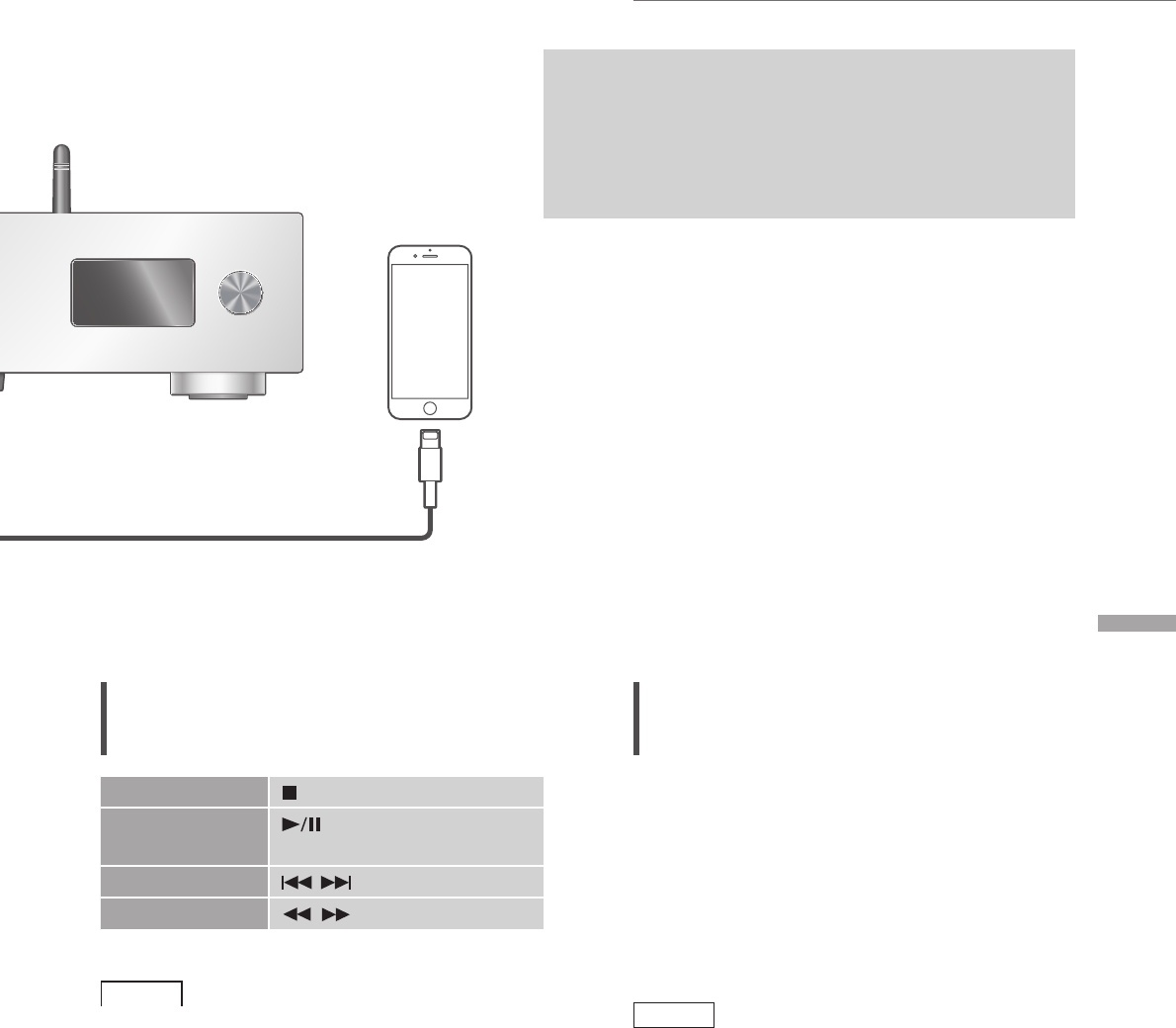
29
English
Using iPhone/iPad/iPod
Operations
INPUT SELECTOR
(29)
1 Connect an iPhone/iPad/iPod to the
unit.
2 Press [DIGITAL] repeatedly to select
“USB”.
• The display will automatically change to
“iPod_Port” when a compatible iPhone/iPad/
iPod is connected to the USB-A terminal.
• You can also select the input source by
turning the input selector knob on the unit.
3 Start playback on the iPhone/iPad/
iPod.
Operations during playback
Stop
Pause
• Press again to restart play.
Skip
Search
• For “Repeat” and “Shuffle”. ( 27)
Note
• Compatibility depends on the software version.
Update your iPhone/iPad/iPod to the latest
software before using it with this unit.
• Operation results may vary depending on the
iPhone/iPad/iPod models or the iOS version.
Charging an iPhone/iPad/iPod
During unit on, charging starts when an iPhone/
iPad/iPod is connected to this unit.
• To continue charging from the USB cable
connection during standby mode, make sure
the iPhone/iPad/iPod has started charging
before turning the unit to standby mode.
• Check the iPhone/iPad/iPod to see if the
battery is fully charged. Once fully charged,
remove the iPhone/iPad/iPod.
Note
• When this unit is in standby mode, “iPod
Charging” is displayed and the power indicator
lights red.
• Charging stops when the battery is fully
charged. The battery will deplete naturally.
• When charging an iPhone/iPad/iPod whose
battery is depleted, do not turn this unit to
standby mode until the iPhone/iPad/iPod
becomes operational.
Connect an iPhone/iPad/iPod to the unit using USB
cable*, and you can play back music stored on iPhone/
iPad/iPod or charge iPhone/iPad/iPod.
• Refer to “iPhone/iPad/iPod” ( 45) for information
about the iOS device this unit can play back.
* : Use the USB cable supplied with iPhone/iPad/iPod.
USB cable
(supplied with iPhone/iPad/iPod)
iPhone/iPad/iPod
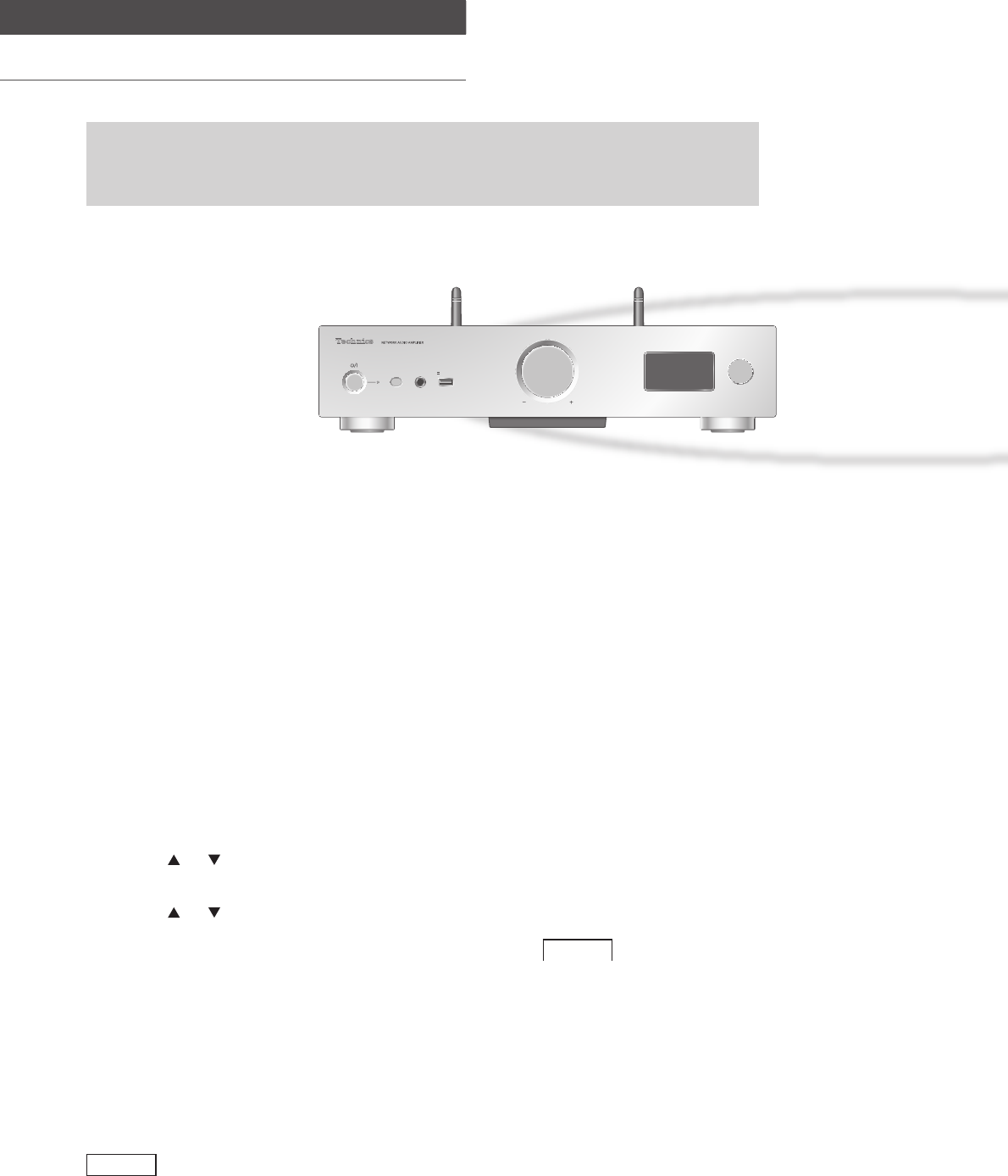
30
Operations
Using Bluetooth®
5V 2.1APHONES
VOLUME
INPUT SELECTOR
(30)
You can listen to the sound from the Bluetooth® audio device from this unit
wirelessly.
• Refer to the operating instructions of the Bluetooth® device for details.
■ Pairing a Bluetooth® device
• Turn on the Bluetooth® feature of the device
and place the device near this unit.
• If a Bluetooth® device is already connected,
disconnect it. ( 31)
1 Press [DIGITAL] repeatedly to select
“Bluetooth”.
• You can also select the input source by
turning the input selector knob on the unit.
2 Press [MENU].
3 Press [ ], [ ] repeatedly to select
“Pairing” and then press [OK].
4 Press [ ], [ ] to select “Yes” and then
press [OK].
• “Pairing” is displayed, and this unit waits for
registering.
5 Select “SU-G30” from the Bluetooth®
device’s menu.
• The name of the connected device is
indicated on the display.
• MAC address may be displayed before “SU-
G30” appears. (e.g. 6C:5A:B5:B3:1D:0F)
Note
• If prompted for the passkey, input “0000”.
• You can register up to 8 devices with this unit.
If a 9th device is paired, the device that has not
been used the longest will be replaced.
■ Listening to music stored on a Bluetooth®
device
1 Press [DIGITAL] repeatedly to select
“Bluetooth”.
• “Ready” is indicated on the display.
• You can also select the input source by
turning the input selector knob on the unit.
2 Select “SU-G30” from the Bluetooth®
device’s menu.
• The name of the connected device is
indicated on the display.
3 Start playback on the Bluetooth®
device.
Note
• This unit can only be connected to one device
at a time.
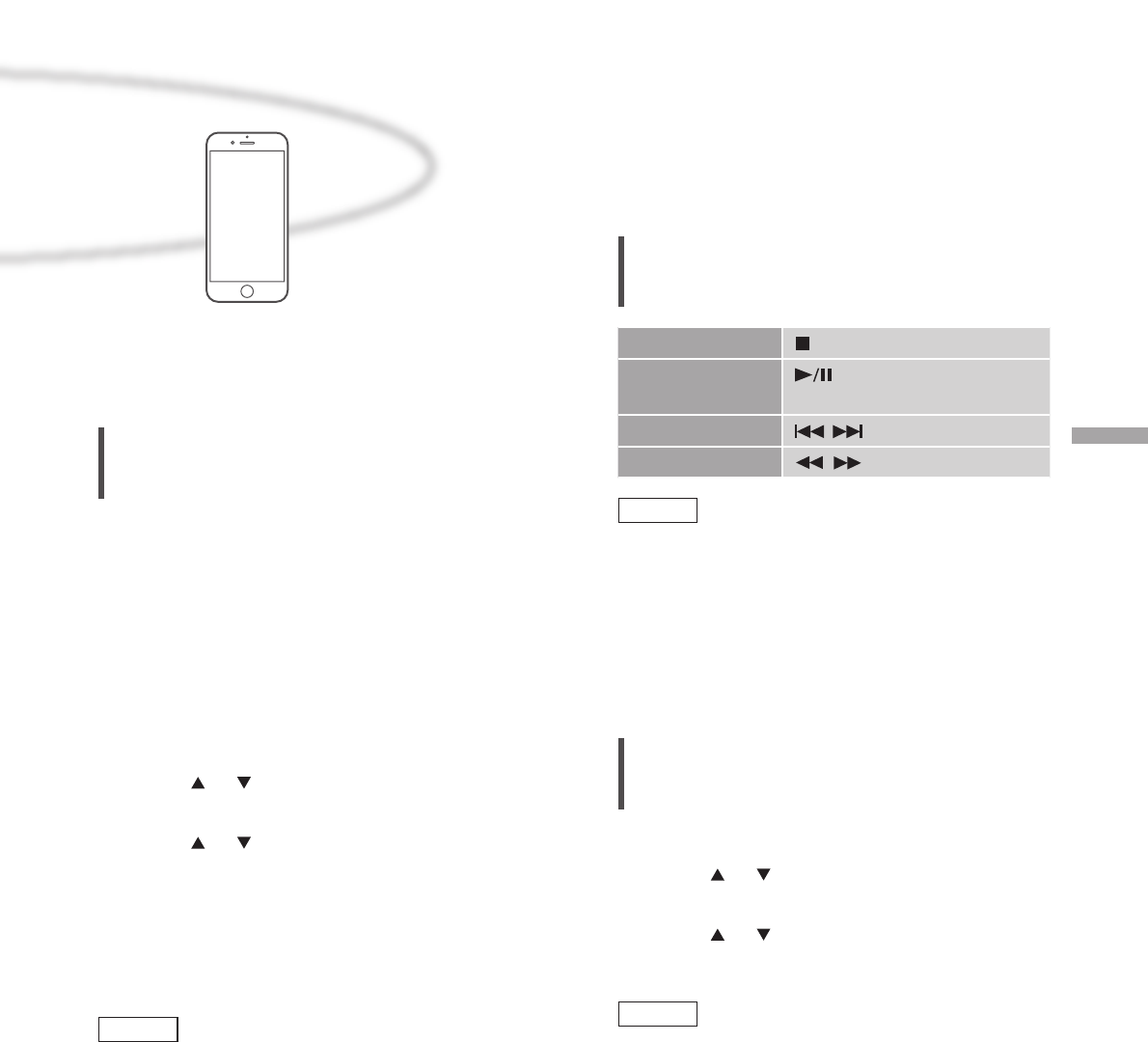
31
English
Operations
Operations during playback
Stop
Pause
• Press again to restart play.
Skip
Search
Note
• To use this unit’s remote control with a
Bluetooth® device, the Bluetooth® device must
support AVRCP (Audio Video Remote Control
Profile). Depending on the status of the device,
some controls may not work.
• When enjoying video contents with this
function, the video audio output may not be
synchronized.
Disconnecting a Bluetooth® device
1 Press [MENU].
2 Press [ ], [ ] repeatedly to select
“Disconnect?” and then press [OK].
3 Press [ ], [ ] to select “Yes” and then
press [OK].
Note
• The Bluetooth® device will be disconnected if a
different audio source is selected.
Bluetooth® transmission mode
You can change the transmission mode to
prioritize transmission quality or sound quality.
1 Press [DIGITAL] repeatedly to select
“Bluetooth”.
• You can also select the input source by
turning the input selector knob on the unit.
• If a Bluetooth® device is already connected,
disconnect it.
2 Press [MENU].
3 Press [ ], [ ] repeatedly to select
“Link Mode” and then press [OK].
4 Press [ ], [ ] to select the mode and
then press [OK].
Mode1:
Emphasis on connectivity
Mode2:
Emphasis on sound quality (default)
Note
• Select “Mode1” if the sound is interrupted.
(31)
Bluetooth® device
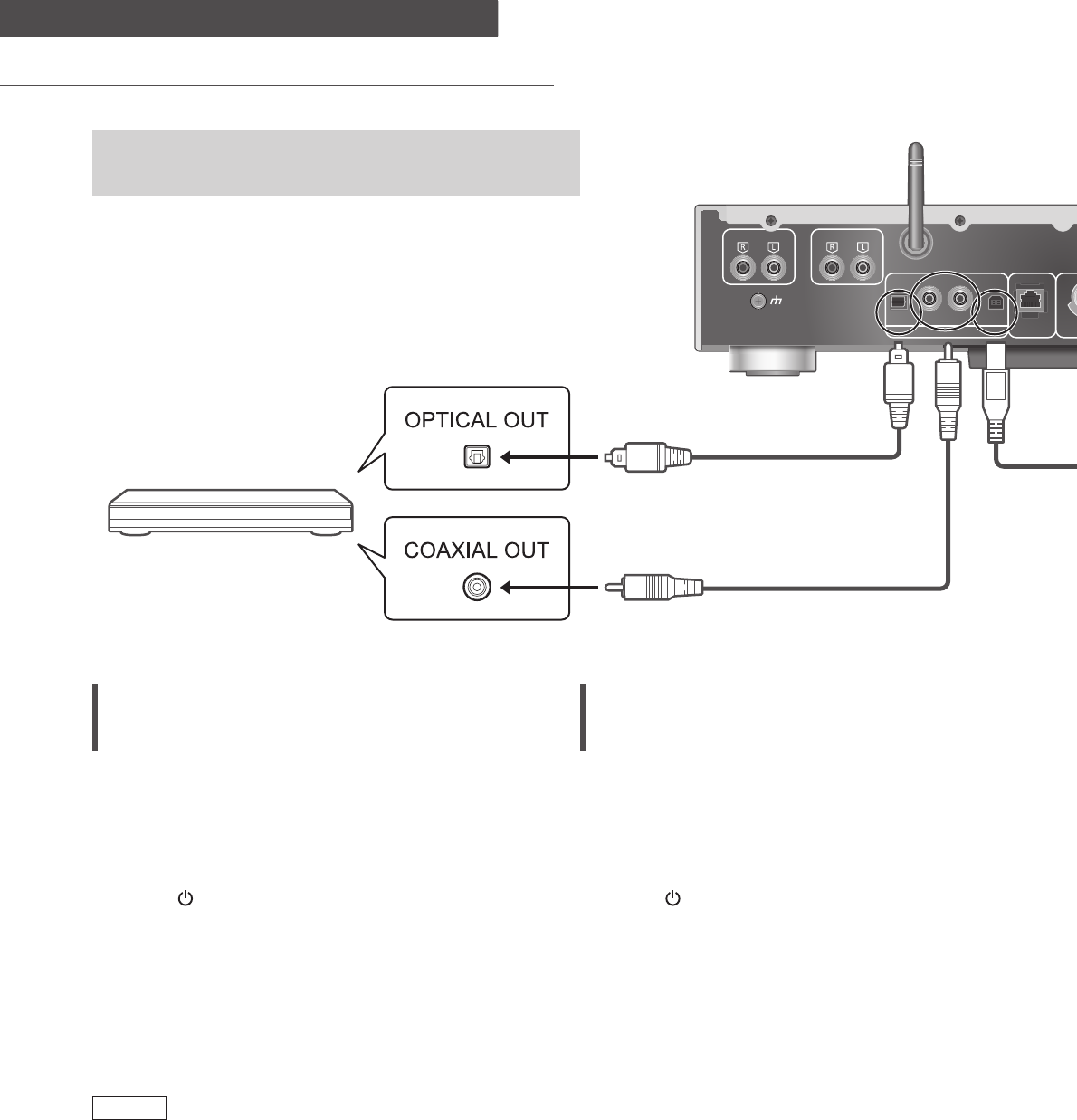
32
Operations
Using digital audio output device
LAN
DIGITAL IN
10BASE-T /
100BASE-TX
OPT COAX1 COAX2 PC
PHONO
PHONO
EARTH
LINE IN
(32)
You can input digital audio signals to this unit and play
back music.
Optical digital audio cable
(not supplied)
CD player, etc.
Coaxial digital cable
(not supplied)
Using coaxial digital cable
1 Disconnect the AC power supply cord.
2 Connect this unit and a CD player etc.
3 Connect the AC power supply cord to
this unit. ( 17)
4 Press [ ] to turn this unit on.
5 Press [DIGITAL] repeatedly to select
“COAX1” or “COAX2”.
• You can also select the input source by
turning the input selector knob on the unit.
6 Start playback on the connected
device.
Note
• The digital audio input terminals of this unit can
only detect linear PCM signals. For details, refer
to the operating instructions of the device.
- Sampling frequency:
Coaxial digital input
32/44.1/48/88.2/96/176.4/192 kHz
Optical digital input
32/44.1/48/88.2/96 kHz
- Number of quantization bits:
16/24 bit
Using optical digital audio cable
1 Disconnect the AC power supply cord.
2 Connect this unit and a CD player etc.
3 Connect the AC power supply cord to
this unit. ( 17)
4 Press [ ] to turn this unit on.
5 Press [DIGITAL] repeatedly to select
“OPT”.
• You can also select the input source by
turning the input selector knob on the unit.
6 Start playback on the connected
device.
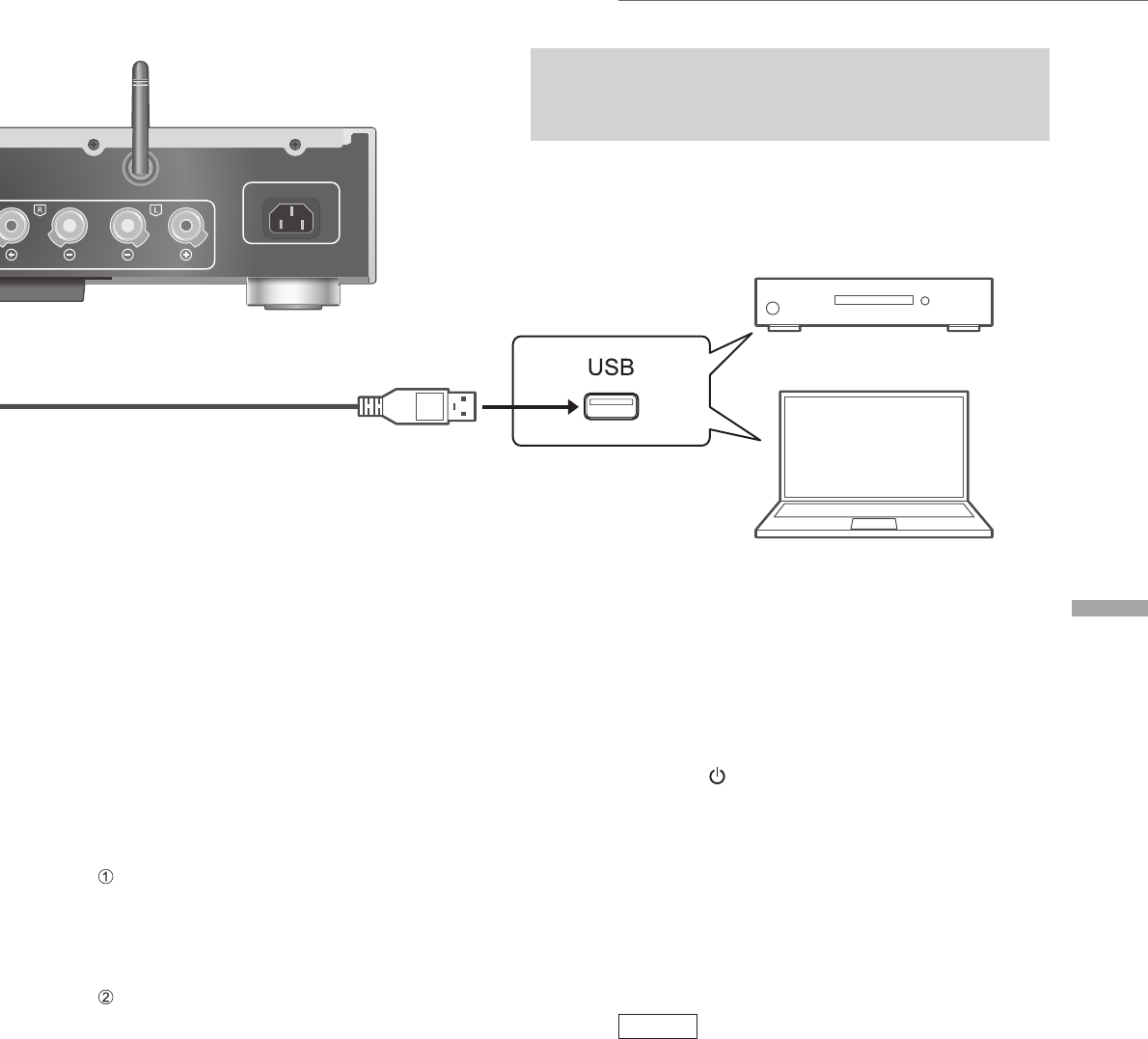
33
English
Operations
Using PC, etc.
SPEAKERS
(4∼16Ω)
AC IN ∼
■ Preparation
Connecting to a PC
• Before connecting to a PC, follow the steps
below.
• Refer to the following for the recommend OS
versions for your PC (as of December 2015):
- Windows 7, Windows 8, Windows 8.1,
Windows 10
- OS X 10.7, 10.8, 10.9, 10.10, 10.11
Download and install the dedicated driver to
the PC. (Only for Windows OS)
• Download and install the driver from the
website below.
www.technics.com/support/
Download and install the dedicated app
“Technics Audio Player” (free of charge) on
your PC.
• Download and install the app from the
website below.
www.technics.com/support/
1 Disconnect the AC power supply cord.
2 Connect this unit and a PC, etc.
3 Connect the AC power supply cord to
this unit. ( 17)
4 Press [ ] to turn this unit on.
5 Press [DIGITAL] repeatedly to select
“PC”.
• You can also select the input source by
turning the input selector knob on the unit.
6 Start playback using the dedicated
app “Technics Audio Player” on the
connected PC.
Note
• About supported format, refer to “File format”
( 49)
(33)
You can connect the USB-B terminal and a PC, etc.
with a USB cable and play back music on the PC, etc.
with this unit.
PC, etc.
USB 2.0 cable
(not supplied)
ST-G30

34
Operations
Using analog audio output device
DIGITAL IN
1
1
0
OPT COAX1 COAX2 PC
PHONO
PHONO
EARTH
LINE IN
PHONO
EARTH
(34)
Using analog digital audio cable
1 Disconnect the AC power supply cord.
2 Connect this unit and a record player,
etc.
3 Connect the AC power supply cord to
this unit. ( 17)
4 Press [ ] to turn this unit on.
5 Press [ANALOG] repeatedly to select
“LINE” or “PHONO”.
• You can also select the input source by
turning the input selector knob on the unit.
6 Start playback on the connected
device.
You can input analog audio signals to this unit and play
back music.
Audio cable
(not supplied)
Ground wire*2
(not supplied)
e.g.,
Record player*1
* 1: When connecting to a record player with a
built-in PHONO equalizer, connect its cable to
the analog audio input terminals (LINE IN).
* 2: When connecting a record player with a
ground wire, connect the ground wire to the
PHONO EARTH terminal of this unit.
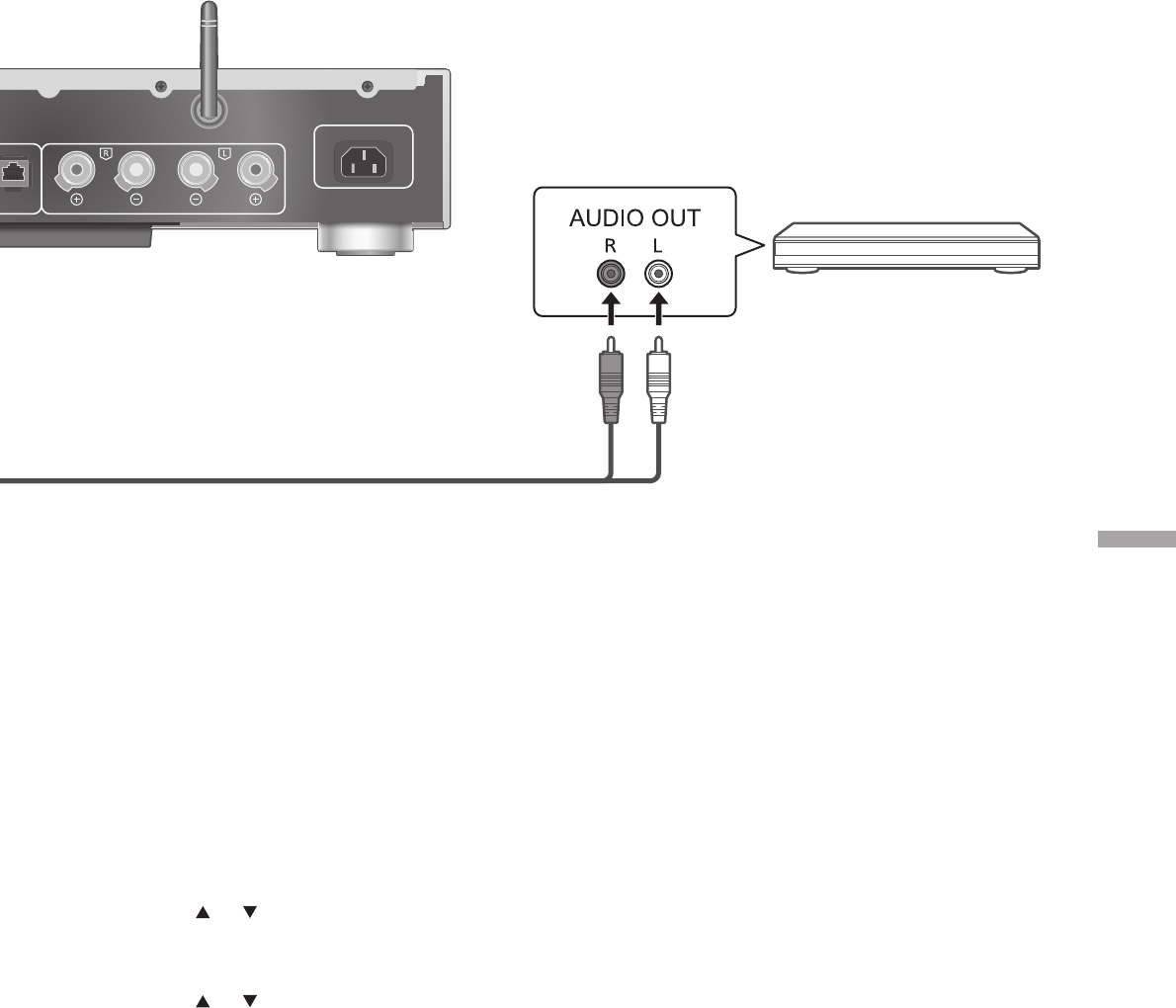
35
English
Operations
LAN
0BASE-T /
0
0BASE-TX
SPEAKERS
(4∼16Ω)
AC IN ∼
(35)
Audio cable
(not supplied)
Blu-ray Disc player, etc.
■ Minimizing audio distortion
If audio distortion occurs when using the analog
audio input terminals (LINE IN), setting the
attenuator to “On” may be improved.
• The factory default is “Off”.
1 Press [SETUP].
2 Press [ ], [ ] repeatedly to select
“Attenuator(LINE)” and then press
[OK].
3 Press [ ], [ ] to select “On” and then
press [OK].
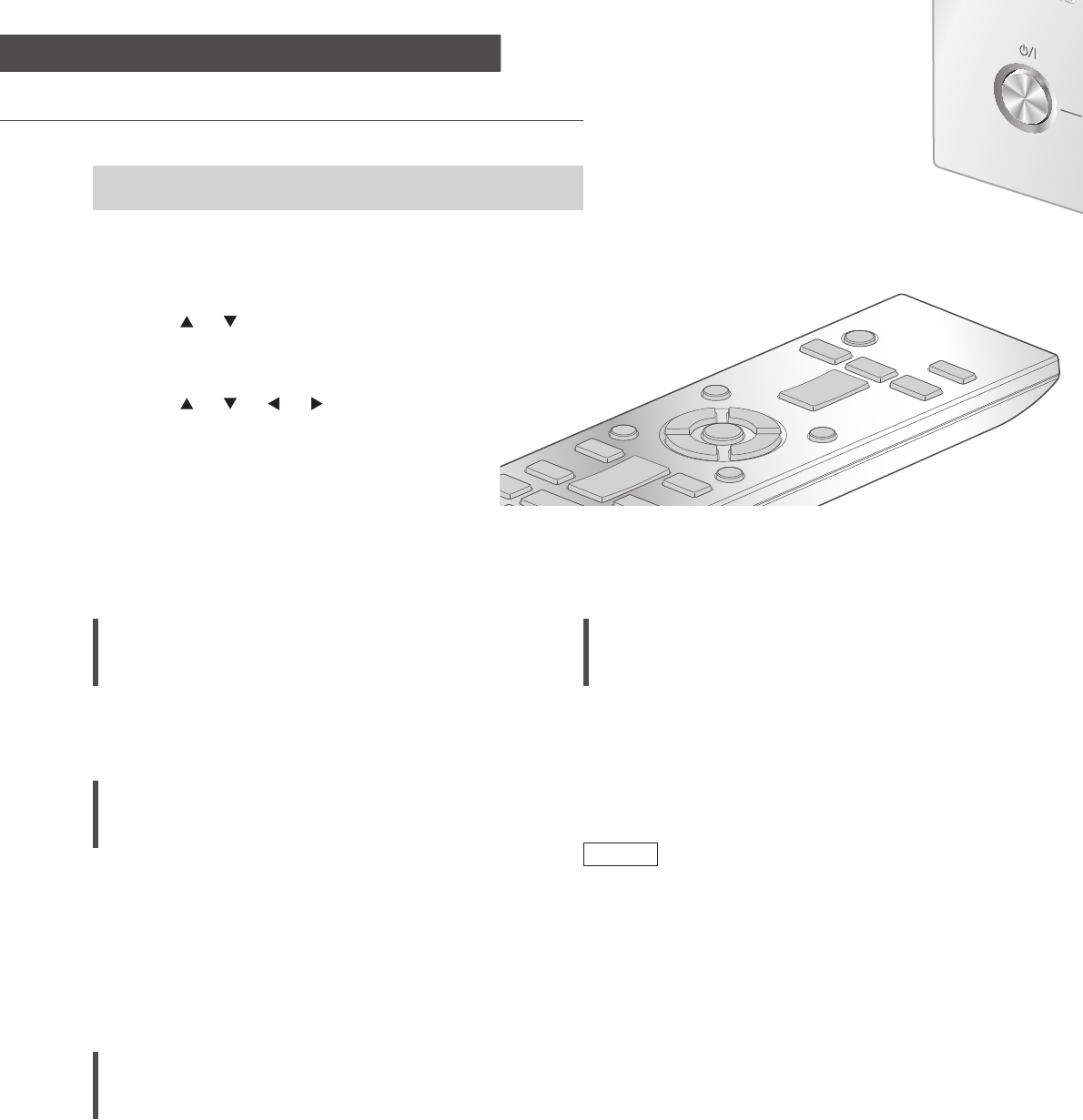
36
Settings
Sound adjustment, Other settings
1 Press [SETUP].
2 Press [ ], [ ] repeatedly to
select the menu and then
press [OK].
3 Press [ ], [ ], [ ], [ ] to set,
and press [OK].
Language setting
“Language”
Select “English” or “Français” for the display.
• The factory default is “English”.
Adjusting Bass/Middle/Treble
“Tone Control”
You can adjust the tone of this unit. Each tonal
range (Bass/Middle/Treble) can be adjusted.
• To enable this function, select “On
(adjustment)”.
• Each level can be adjusted between “- 10” and
“+ 10”.
• “TONE” is displayed after setting.
Sleep timer
“SLEEP”
The sleep timer can turn the unit to standby
mode after a set time. (30 minutes/60
minutes/90 minutes/120 minutes/Off)
Auto off function
“AUTO OFF”
This unit is designed to conserve its power
consumption and save energy. The unit has been
left unused for about 20 minutes and will enter
standby mode within a minute. Press any button
to cancel it.
• The factory default is “Off”.
Note
• The auto off function works unless you turn it
off, even if you turn this unit to standby mode
and on.
The sound effects and other settings can be set up.
(36)
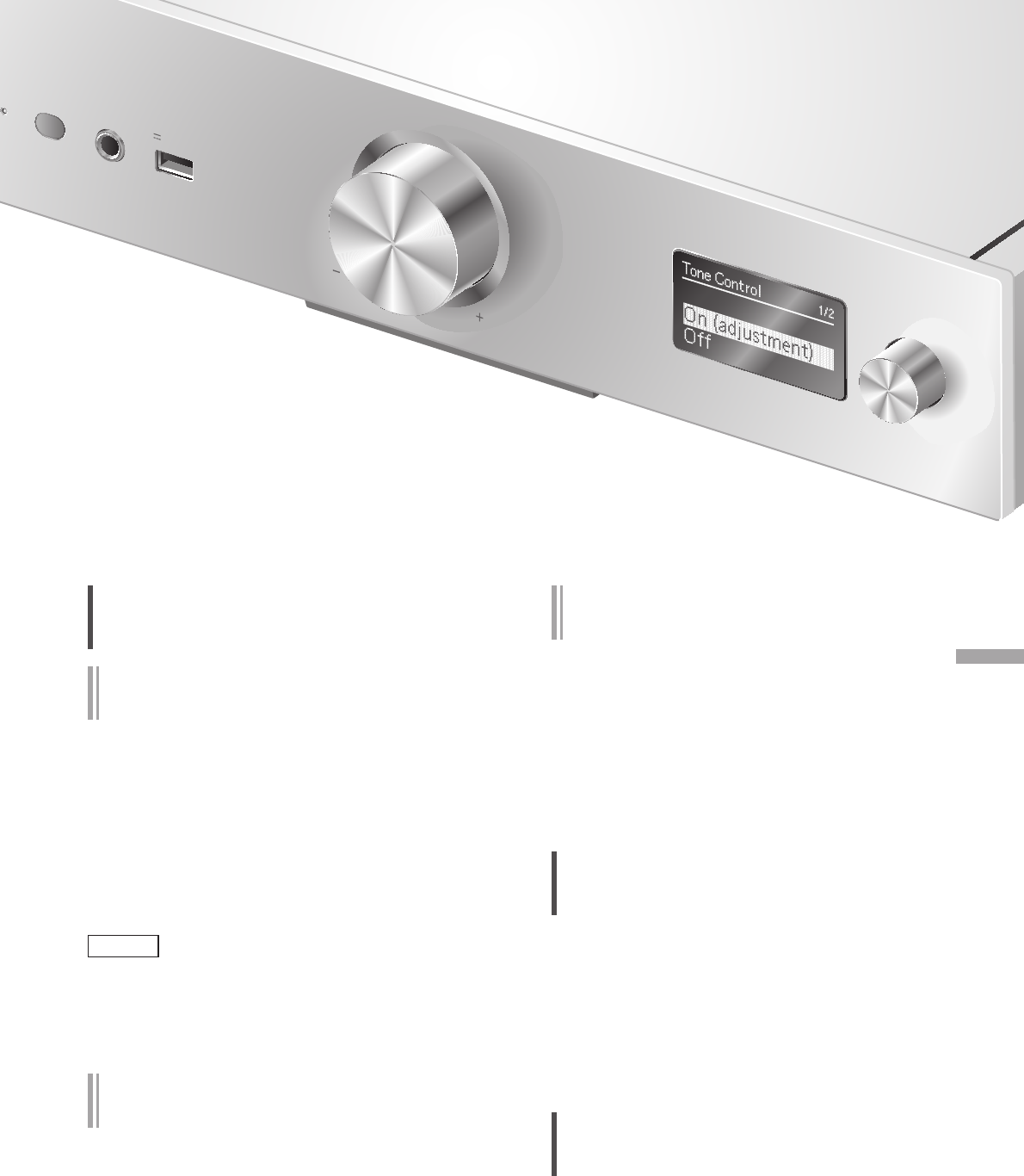
INPUT SELECTOR
VOLUME
5V 2.1A
PHONES
37
English
Settings
Network settings
“Network”
Network standby
“Network Standby”
This unit can turn on automatically from standby
mode when this unit is selected as the network
device’s output speakers.
• The factory default is “Auto”.
Auto:
Enables the network standby function when
the network connection is available.
On:
Always enables the network standby function.
Note
• If this function is set to “On” or “Auto”, the
standby power consumption will increase.
• Power indicator lights red when the network
standby function is available.
Wireless LAN setting
“Wi-Fi”
The wireless LAN function can be enabled or
disabled.
• The factory default is “Off”.
Wi-Fi signal strength
“Signal Level”
To check the Wi-Fi signal strength where this
system is located.
• It is recommended to have a signal strength
of “3”. Change the position or angle of your
wireless router or this system if the indicator is
“2” or “1” and see if the connection improves.
• If “0” is displayed, this system cannot establish
a link with the wireless router.
Changing the character encoding
“E Asian Character”
You can change the character encoding of track
names, artist names and other information when
they are not displayed as they should be.
Type 1(⽇本):
Priority is given to Japanese. (default)
Type 2(简体字):
Priority is given to Chinese (Simplified).
Checking the firmware version
“F/W Version”
The version of the installed firmware is displayed.
(37)
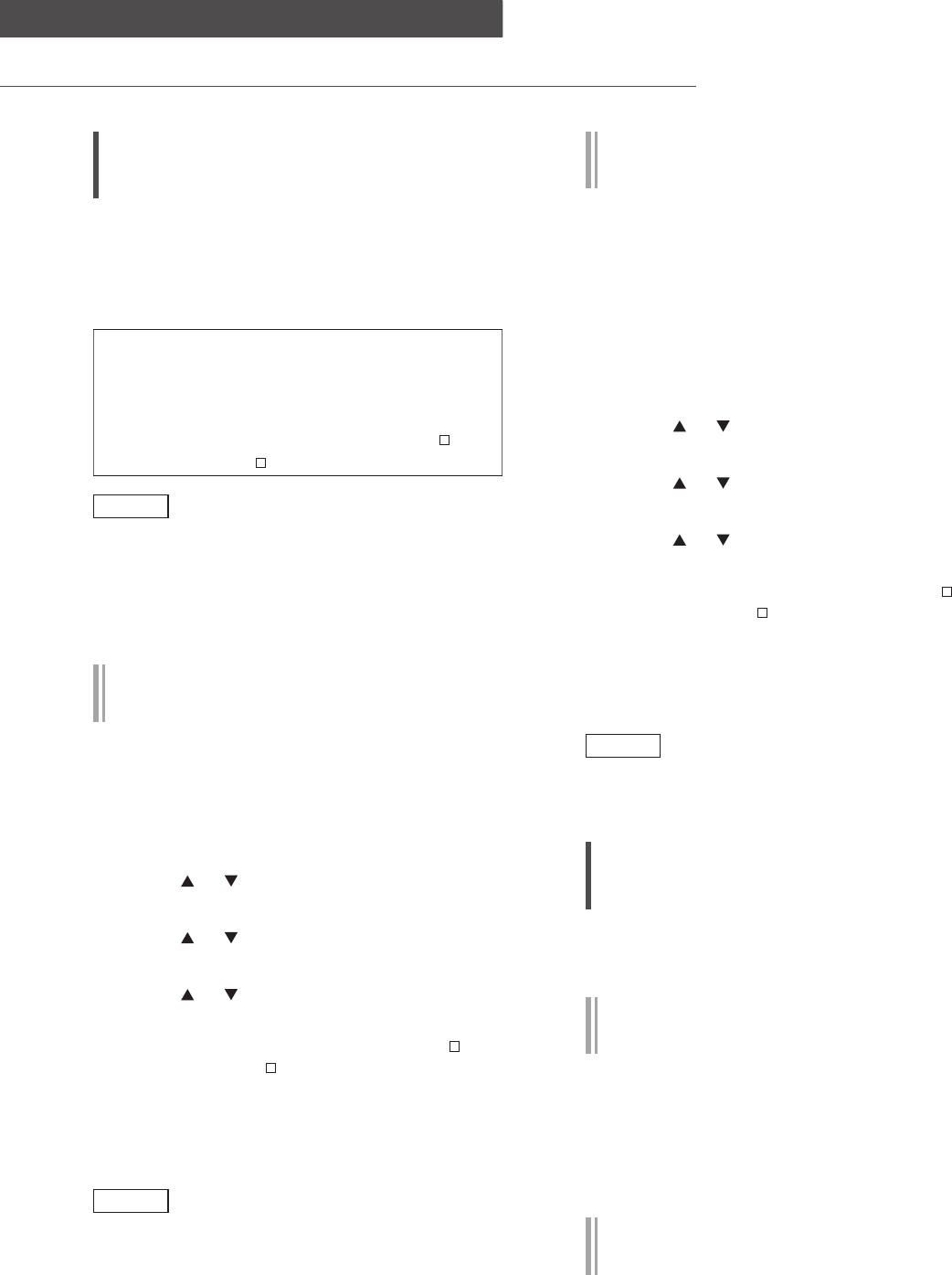
38
Settings
Sound adjustment, Other settings (Continued)
Firmware updates
“F/W Update”
Occasionally, Panasonic may release updated
firmware for this unit that may add or improve
the way a feature operates. These updates are
available free of charge.
Downloading takes approx. 10 minutes.
Do not disconnect the AC power supply
cord or turn this unit to standby while
updating.
• The progress is displayed as “Updating %”
while updating. ( stands for a number.)
Note
• During the update process, no other operations
can be performed.
• If there are no updates, “Firmware is Up To
Date” is displayed.
• Updating the firmware may reset the settings.
Update via Internet
■ Preparation
• Connect this unit to the network. ( 18)
- Make sure that the network is connected to
the Internet.
1 Press [SETUP].
2 Press [ ], [ ] repeatedly to select
“F/W Update” and then press [OK].
3 Press [ ], [ ] to select “Internet” and
then press [OK].
4 Press [ ], [ ] to select “Yes” and then
press [OK].
• The progress is displayed as “Updating %”
while updating. ( stands for a number.)
• When the update has finished successfully,
“Success” is displayed.
5 Disconnect the AC power supply cord
and reconnect it after 3 minutes.
Note
• Downloading may take longer or may not
work properly depending on the connection
environment.
Update via USB flash memory
■ Preparation
• Download the latest firmware on the USB flash
memory. For details, refer to the following
website.
www.technics.com/support/firmware/
1 Connect the USB flash memory with
new firmware.
2 Press [SETUP].
3 Press [ ], [ ] repeatedly to select
“F/W Update” and then press [OK].
4 Press [ ], [ ] to select “USB” and then
press [OK].
5 Press [ ], [ ] to select “Yes” and then
press [OK].
• The progress is displayed as “Updating %”
while updating. ( stands for a number.)
• When the update has finished successfully,
“Success” is displayed.
6 Disconnect the AC power supply cord
and reconnect it after 3 minutes.
Note
• Downloading may take longer depending on
the USB flash memory.
Sound adjustment
The following sound effects can be added to the
audio output.
Listening to more natural-sounding audio
(Re-master)
Re-mastering expands the playback band and
achieves a higher bit depth to reproduce natural
and expansive sound close to original music.
• The factory default is “Off”.
Press [RE-MASTER] to select “On”/“Off”.
Direct mode
When this mode is set to on, the audio signal
is output directly without performing various
processing circuits.
• The factory default is “Off”.
Press [DIRECT] to select “On”/“Off”.
(38)

39
English
Settings
Using output correction function (LAPC)
(39)
Measuring the output signal of the
amplifier and correcting its output
(LAPC)
■ Preparation
• Disconnect the headphones.
Test tone emitted during measurement
To ensure the measurement accuracy, the
speakers output a test tone at regular intervals.
(For approximately 2 minutes)
It is not possible to change the volume of the
audio being output while the measurement is in
progress.
1 Press [ ] to turn this unit on.
2 Press and hold [LAPC] until “LAPC
Measuring” is displayed.
This unit will start measuring the output signal
of the amplifier. Check that a test tone is
output from both the left and right speakers.
When the measurement is complete, amplifier
output correction will be automatically turned
on.
• If you press [LAPC] while the measurement is
in progress, it will be cancelled.
• If you connect headphones during amplifier
signal measurement or amplifier output
correction, it will be cancelled.
■ Turning on/off the output correction
function
Press [LAPC] to select “On”/“Off”.
• “On”/“Off” is displayed.
Note
• Depending on the type of the connected
speakers, the effect of the output correction
function may be minimal.
• The corrected output remains in effect until you
measure the output signal again. When you use
other speakers, redo the measurement.
You can make the optimum adjustment according to
your own speakers.

40
Troubleshooting
(40)
Heat buildup of this unit
This unit becomes warm when the volume is
high. This is not a malfunction.
Do you have the latest firmware
installed?
Panasonic is constantly improving the unit’s
firmware to ensure that our customers are
enjoying the latest technology. ( 38)
To return all settings to the factory
defaults
When the following situations occur, reset the
memory:
• There is no response when buttons are pressed.
• You want to clear and reset the memory
contents.
1 Press [SETUP].
2 Press [ ], [ ] repeatedly to select
“Initialization” and then press [OK].
3 Press [ ], [ ] to select “Yes” and then
press [OK].
• All the settings are set back to the factory
defaults. It is necessary to set the memory
items again.
4 Press [ ], [ ] to select “Yes” and then
press [OK] again.
General
The unit does not work.
Operations are not done properly.
• One of the unit’s safety devices may have been
activated.
Press [ ] on the unit to switch the unit to
standby.
• If the unit does not switch to standby, press
[] on the unit for at least 5 seconds. The
unit is forcibly switched to standby.
Alternatively, disconnect the AC power
supply cord, wait for at least 3 minutes,
then reconnect it.
Press [ ] on the unit to switch on. If the
unit still cannot be operated, consult the
dealer.
A “humming” sound can be heard during
playback.
• An AC power supply cord or fluorescent light
is near the cables. Keep other appliances and
cords away from the cables of this unit.
• A strong magnetic field near a TV or other
device may adversely affect the audio quality.
Keep this unit away from such devices.
• The speakers may output noise when a device
nearby is emitting powerful radio waves, such
as when a mobile phone is on a call.
No sound.
• Check the volume of this unit.
• Check connections to speakers and other
equipment.
After checking the connections, measure the
output signal of the amplifier. ( 39)
• Check to see if the correct input source is
selected.
• Insert the plugs of the cables to be connected
all the way in.
• Playback of multi-channel content is not
supported.
• The digital audio input terminals of this unit can
only detect linear PCM signals. For details, refer
to the operating instructions of the device.
Playback does not start.
• Depending on your environment or connected
devices, it may take some time.
• Check to see if the format of the file is
supported. About supported format, refer to
“File format”. ( 49)
Before requesting service, make the following checks. If you are uncertain about some of the check
points, or if the solutions indicated in the following guide does not resolve the issue, then consult your
dealer for instructions.

41
English
Troubleshooting
The unit turns to standby mode
automatically.
• Is the auto off function turned on? ( 36)
• This unit incorporates a protection circuit
to prevent damage caused by heat buildup.
When you use this unit at a high volume
level for a long period of time, it may turn
off automatically. Wait for this unit to cool
down before turning on this unit again. (For
approximately 3 minutes)
The sound is interrupted.
• Depending on your environment, the audio
may be interrupted during playback. Check the
operating instructions of the connected device
and the connection to the device.
The settings are reset to the factory defaults.
• Updating the firmware may reset the settings.
USB
The USB drive or its contents cannot be read.
• The USB drive format or its contents is/are not
compatible with the unit. ( 45)
No response when [ ] is pressed.
• Disconnect the USB device and then reconnect
it. Alternatively, turn the unit to standby and on
again.
Slow operation of the USB flash drive.
• Large file size or high memory USB flash drive
takes longer time to read.
• It may take some time if there are a lot of files
or folders on it.
iPhone/iPad/iPod
Cannot operate.
• Select “USB” as the input source. ( 29)
• Check that the iPhone/iPad/iPod is connected
properly. ( 29)
• The battery of the iPhone/iPad/iPod is
depleted. Charge the iPhone/iPad/iPod, and
then operate again. ( 29)
• Connect the iPhone/iPad/iPod again or try to
restart the iPhone/iPad/iPod.
iPhone/iPad/iPod does not charge.
• Only when unit is ON will charging begin from
USB cable connection.
• Make sure the unit is turned on when you start
charging.
- When charging an iPhone/iPad/iPod whose
battery is depleted, do not turn this unit to
standby mode until the iPhone/iPad/iPod
becomes operational.
Bluetooth®
Pairing cannot be completed.
• Check the Bluetooth® device condition.
The device cannot be connected.
• The pairing of the device was unsuccessful
or the registration has been replaced. Try re-
pairing the device. ( 30)
• This unit might be connected to a different
device. Disconnect the other device and try re-
pairing the device.
The device is connected, but audio cannot be
heard through this unit.
• For some built-in Bluetooth® devices, you have
to set the audio output to “SU-G30” manually.
Read the operating instructions for the device
for details.
The sound is interrupted.
• The device is out of the 10 m (33 ft)
communication range. Bring the Bluetooth®
device closer to this system.
• Remove any obstacle between this system and
the device.
• Other devices that use the 2.4 GHz frequency
band (wireless router, microwaves, cordless
phones, etc.) are interfering. Bring the
Bluetooth® device closer to this system and
distance it from the other devices.
• Select “Mode1” for stable communication.
( 31)
(41)

42
Troubleshooting
(42)
PC
The PC does not recognize this unit.
• Check your operating environment. ( 33)
• Restart the PC, turn this unit to standby and on,
and then reconnect the USB cable.
• Use another USB port of the connected PC.
• Install the dedicated driver if using a PC with
Windows.
Cannot find music files stored on the PC.
• When you play back music files over a network,
those that are not registered to its network
server are not displayed. For details, refer to the
operating instructions for your server.
Network
Cannot connect to the network.
• Confirm the network connection and settings.
( 18)
• If the network is set to be invisible, make the
network visible while you set up the network
for this unit or make a wired LAN connection.
• This system’s Wi-Fi security supports WPA2™.
Your wireless router must therefore be
WPA2™ compatible. For details on the security
supported by your router and how to change
the settings, please refer to the operating
instructions or contact your internet service
provider.
• Make sure that the multicast function on the
wireless router is enabled.
• Depending on the router, WPS button may not
work. Try other methods. ( 18)
• The wireless LAN environment or radio
interference in your area may cause connection
problem. In this case, try another connection
method. If the problem persists, make a wired
LAN connection. ( 18)
• While the AC power supply cord is
disconnected, the LAN cable must be
connected or disconnected.
Cannot select this system as the output
speakers.
• Make sure that the devices are connected to
the same network as this system.
• Reconnect the devices to the network.
• Turn the wireless router off and then on.
• Turn this unit to standby and on, and then
select this system as the output speakers again.
Playback does not start.
The sound is interrupted.
• Try to place the speakers further away from this
unit.
• If using the 2.4 GHz band on the wireless
router, simultaneous use with other 2.4 GHz
devices, such as microwaves, cordless
telephones, etc., may result in connection
interruptions. Increase the distance between
this unit and these devices.
- If your wireless router supports 5 GHz band,
try using the 5 GHz band.
To change to the 5 GHz band, redo the
network settings using an internet browser
( 22). On the step 5, make sure to select
your network name (SSID) for the 5 GHz
band.
• Do not place this system inside a metal cabinet,
for it might block the Wi-Fi signal.
• If the playback stops, check the playback status
on the device.
• Place this system closer to the wireless router.
• Check the Wi-Fi signal strength using “Signal
Level” and adjust location of this unit and the
wireless router. ( 37)
• If several wireless devices are simultaneously
using the same wireless network as this unit, try
turning off the other devices or reducing their
wireless network usage.
• Reconnect the devices to the network.
• Turn the wireless router off and then on.
• With some iOS and iTunes versions, it may not
be possible to restart the AirPlay playback if
the selector is changed or this unit is in standby
mode, during the AirPlay playback. In this case,
select a different device from the AirPlay icon of
the Music App or iTunes and then re-select this
system as the output speakers. ( 26)
• If the above solutions do not solve the problem,
make a wired LAN connection for all connected
DLNA compatible devices which have LAN
terminal (this unit, Network Attached Storage,
DLNA server, etc.).
The DLNA server and its contents are not
displayed.
• The connected DLNA server and its contents
may not be displayed properly depending on its
condition (e.g. soon after adding the contents
to the server, etc.). Try again later. For details,
refer to the operating instructions of the DLNA
server.

43
English
Troubleshooting
Remote control
The remote control does not work properly.
• The batteries are depleted or inserted
incorrectly. ( 14)
• To avoid interference, please do not put any
objects in front of signal sensor. ( 12)
• Change the remote control code if other
products react to this remote control. ( 15)
Messages
• The selected file cannot be played back.
• Select the playable file.
- About supported format, refer to “File
format” ( 49)
AUTO OFF
• The unit has been left unused for about 20
minutes and will shut down within a minute.
Press any button to cancel it.
Checking Device
• The unit is checking the connected iPhone/
iPad/iPod or a USB device. After this display has
disappeared, start operating.
Download Fail
• The firmware download has failed. Press any
button to exit. Please try again later.
• The server cannot be found. Press any button to
exit. Make sure that the network is connected
to the internet.
Empty
• The selected folder is empty. Move tracks into
the folder and retry the operation.
• The server is not found on the network. Check
to see if the server is connected to the same
network as this unit, and retry the connection
to this unit. ( 18)
Error
• Incorrect operation is performed. Read the
instructions and try again.
Fail
• Network connection is not complete. Try the
setting again. ( 18)
Firmware update is available
• The firmware (free of charge) for this unit is
available.
Press [OK].
Press [ ], [ ] to select “Yes” and then press
[OK].
• The progress is displayed as “Updating %”
while updating. ( stands for a number.)
• Do not disconnect the AC power supply
cord or turn this unit to standby while
updating. ( 38)
• When the update has finished successfully,
“Success” is displayed.
Disconnect the AC power supply cord and
reconnect it after 3 minutes.
“F ” (“ ” stands for a number.)
• There is a problem with this unit.
- Is the volume extremely high?
If so, lower the volume.
- Is this unit placed in an extremely hot place?
If so, move this unit to a cooler place and wait
a few moments and then try to turn it on
again.
If the problem persists, write down the
displayed number, disconnect the AC power
supply cord and consult your dealer.
Load Fail
• The firmware on the USB flash memory cannot
be found.
• Download the latest firmware on the USB flash
memory and try again. ( 38)
No Device
• No USB device is connected.
• Connect the USB device to be played. ( 28)
No Network Available
• This unit is not connected to the network.
• Check the network connection. ( 18)
Not Measured
• Measuring the output signal has not been done
yet.
• Measure the output signal. ( 39)
Not Valid
• The function you have tried to use is not
available with the current settings. Check the
steps and settings.
(43)

44
Troubleshooting
(44)
Please Wait
• This is displayed, for example, when this unit
is turned to standby/on. (For up to approx.
1 minute and 30 seconds)
“Remote ” (“ ” stands for a number.)
• The remote control and this unit are using
different codes.
Change the code on the remote control. ( 15)
Remote Mode
• Basic playback control buttons on the remote
control are not available. (While playing back
music stored on the DLNA server with this unit
(DMR), etc.)
• Use the connected device for basic playback
control.
Searching
• The unit is checking the DLNA server on the
network.
Signal Overflow
• The audio from the analog audio input terminal
in use is distorted. Select “Attenuator(LINE)”,
and change the setting for the analog audio
input terminal in use to “On”. ( 34)
Unlocked
• “PC”, “COAX1”, “COAX2” or “OPT” is selected,
but no device is connected. Check the
connection with the device. ( 32, 33)
• Audio signals, such as sampling frequency
components, are not input correctly.
- About supported format, refer to “File
format” ( 49)
USB Over Current Error
• The iPhone/iPad/iPod or USB device is drawing
too much power. Disconnect the iPhone/iPad/
iPod or USB device and turn the unit to standby
and on again.
Wi-Fi Setup
• Select “On” and press [OK] to enter the
network setting. ( 19)
- To exit the network setting, select “Off” and
press [OK].
Hub Device Not Supported/Not Supported/
Device Not Recognized/
USB Device Not Supported
• You have connected an iPhone/iPad/iPod or
USB device that is not supported.
- If the iPhone/iPad/iPod is compatible, turn it
on and connect it correctly.
• The format of the file on the iPhone/iPad/iPod
or USB device is not supported.
- About supported format, refer to “File
format” ( 49)

45
English
Troubleshooting / Others
USB
• This unit does not guarantee connection with
all USB devices.
• FAT16 and FAT32 file systems are supported.
• This unit supports USB 2.0 high speed.
• USB devices may not be recognized by this unit
when connected using the following:
- a USB hub
- a USB extension cable
• It is not possible to use USB card reader/writers.
• This unit cannot record music to a USB device.
• Not all files on the USB device may be read if
there are some files not supported.
• About supported format, refer to “File format”
( 49)
iPhone/iPad/iPod
• Please be aware that Panasonic accepts no
responsibility for the loss of data and/or
information.
• Compatible iPhone/iPad/iPod (as of June 2015)
iPhone 6 Plus / iPhone 6 / iPhone 5s /
iPhone 5c / iPhone 5 / iPhone 4s /
iPad Air 2 / iPad Air /
iPad (3rd and 4th generation) / iPad 2 /
iPad mini 3 / iPad mini 2 / iPad mini /
iPod touch (5th generation) /
iPod nano (7th generation)
Note
• Do not connect the following models to the
port:
- iPod classic, iPod [4th (color display), and
5th (video) generation], iPod nano (1st
generation)
Unexpected behavior may occur.
(45)
Others
Playable media

46
Others
About Bluetooth®
(46)
Panasonic bears no responsibility for data
and/or information that is compromised
during a wireless transmission.
Frequency band used
• This system uses the 2.4 GHz frequency band.
Certification of this device
• This system conforms to frequency restrictions
and has received certification based on
frequency laws. Thus, a wireless permit is not
necessary.
• The actions below are punishable by law in
some countries:
- Taking apart or modifying the system.
- Removing specification indications.
Restrictions of use
• Wireless transmission and/or usage with all
Bluetooth® equipped devices is not guaranteed.
• All devices must conform to standards set by
Bluetooth SIG, Inc.
• Depending on the specifications and settings
of a device, it can fail to connect or some
operations can be different.
• This system supports Bluetooth® security
features. But depending on the operating
environment and/or settings, this security is
possibly not sufficient. Transmit data wirelessly
to this system with caution.
• This system cannot transmit data to a
Bluetooth® device.
Range of use
• Use this device at a maximum range of 10 m
(33 ft). The range can decrease depending on
the environment, obstacles or interference.
Interference from other devices
• This system may not function properly and
troubles such as noise and sound jumps may
arise due to radio wave interference if this
system is located too close to other Bluetooth®
devices or the devices that use the 2.4 GHz
band.
• This system may not function properly if radio
waves from a nearby broadcasting station, etc.
is too strong.
Intended usage
• This system is for normal, general use only.
• Do not use this system near an equipment or
in an environment that is sensitive to radio
frequency interference (example: airports,
hospitals, laboratories, etc.).

47
English
Others
■ GENERAL
Power supply AC 120 V, 60 Hz
Power
consumption 96 W
Power
consumption in
standby mode
(Network Standby
Off)*
Approx. 0.3 W
Power
consumption in
standby mode
(Network Standby
On)*
Approx. 2.9 W
Dimensions
(W×H×D)
430 mm (16 15/16”) ×
98 mm (3 7/8”) ×
424 mm (16 23/32”)
Mass Approx. 11.5 kg (25.4 lbs)
Operating
temperature range
0 °C to +40 °C
(+32 °F to +104 °F)
Operating humidity
range
35 % to 80 % RH
(no condensation)
* : At the time of iPod/iPhone/iPad non-charging.
■ AMPLIFIER SECTION
FTC output power
50 W + 50 W
(1 kHz, T.H.D. 0.5 %, 8 ,
20 kHz LPF)
100 W + 100 W
(1 kHz, T.H.D. 0.5 %, 4 ,
20 kHz LPF)
Load impedance 4 - 16
Frequency
response
PHONO (MM)
20 Hz to 20 kHz
(RIAA DEVIATION ±1 dB,
8 )
LINE 5 Hz to 80 kHz
(-3 dB, 8 )
DIGITAL 5 Hz to 90 kHz
(-3 dB, 8 )
Input sensitivity/
Input impedance
LINE 200 mV / 22 k
PHONO (MM) 2.5 mV / 47 k
■ Bluetooth® SECTION
Bluetooth® system
specification Bluetooth® Ver. 3.0
Wireless
equipment
classification Class 2 (2.5 mW)
Supported profiles A2DP, AVRCP
Supported codec aptX® Low Latency,
AAC, SBC
Frequency band 2.4 GHz band FH-SS
Operating distance Approx. 10 m (33 ft) Line
of sight*
* : Prospective communication distance
Measurement environment:
Temperature 25 °C (77 °F)/
Height 1.0 m (3.3 ft)
Measure in “Mode1”
(47)
Specifications

48
Others
Specifications (Continued)
(48)
■ TERMINALS SECTION
Headphones Jack Stereo, 6.3 mm (1/4”)
USB FRONT USB
Type A Connector
Support Memory
Capacity 2 TB (max)
Maximum
number of
folders (albums) 800
Maximum
number of files
(songs) 8000
File system FAT16, FAT32
USB port power DC OUT 5 V 2.1 A (max)
PC REAR USB
Type B Connector
Ethernet interface LAN
(100BASE-TX/10BASE-T)
Analog input
Line input Pin jack
PHONO (MM) Pin jack
Digital input
Optical digital
input Optical terminal
Coaxial digital
input ×2 Pin jack
Format support LPCM
■ FORMAT SECTION
USB-A
USB Standard USB 2.0 high-speed
USB Mass Storage class
USB-B
USB Standard
USB 2.0 high-speed
USB Audio Class 2.0,
Asynchronous mode
DSD control mode ASIO Native mode,
DoP mode
■ Wi-Fi SECTION
WLAN Standard IEEE802.11a / b / g / n
Frequency Band
2.4 GHz (1 - 11 ch) /
5 GHz (36, 38, 40, 44,
46, 48, 149, 151, 153,
157, 159, 161, 165 ch)
Security WPA2™,
Mixed mode WPA2™/WPA™
Encryption Type TKIP / AES
Authentication
type
PSK
WEP (64 bit/128 bit)
WPS version Version 2.0
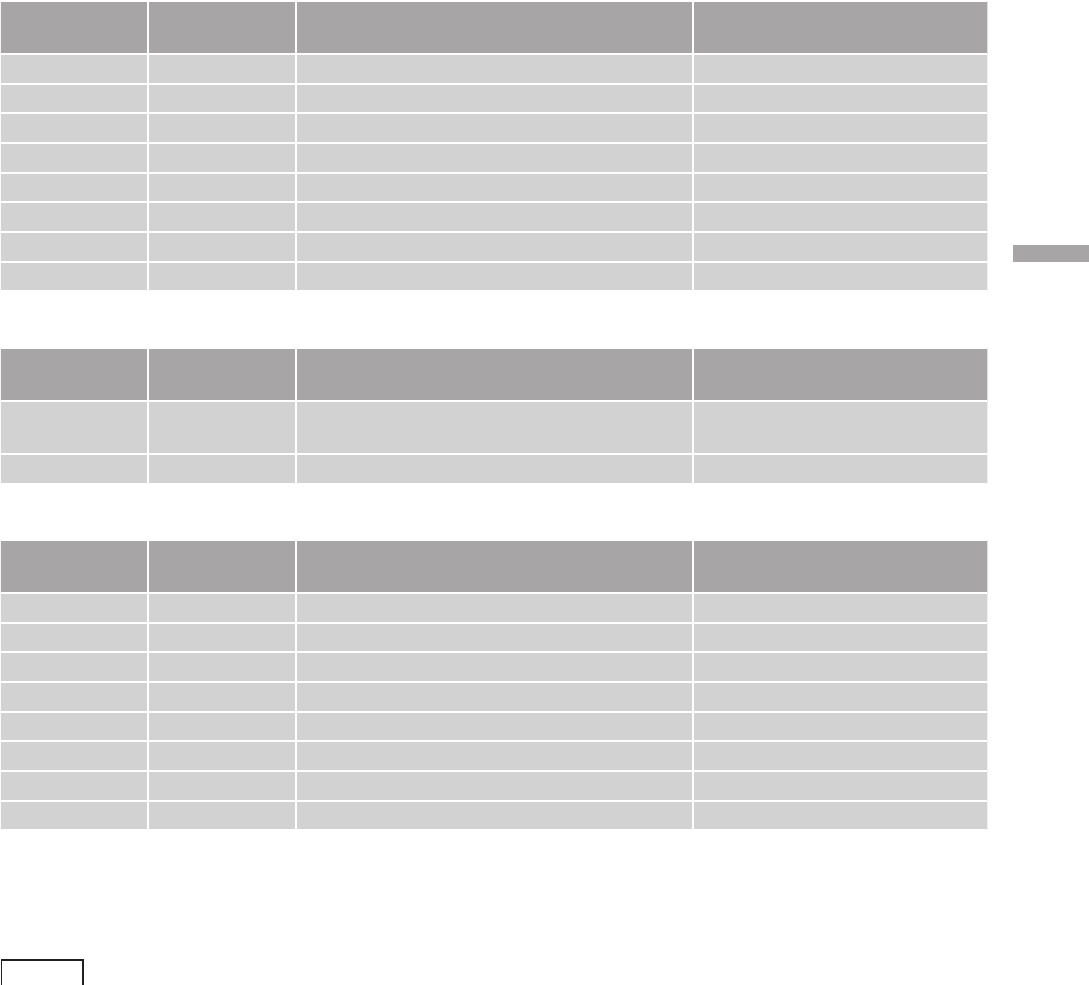
49
English
Others
■ File format
This unit supports the following file formats.
• This unit does not support the playback of copy-protected music files.
• Playback of all files in formats supported by this unit is not guaranteed.
• Playback of a file in a format not supported by this unit may cause choppy audio or noise. In such cases,
check to see if this unit supports the file format.
• This unit does not support VBR (Variable Bit Rate) playback.
• Some of the connected devices (servers) may be capable of converting files in formats not supported by
this unit and output them. For details, refer to the operating instructions for your server.
• File information (sampling frequency, etc.) shown by this unit and playback software may differ from each
other.
USB-A
File format Extension Sampling frequency Bit rate / Number of
quantization bits
MP3 .mp3 32/44.1/48 kHz 16 to 320 kbps
AAC .m4a/.aac 32/44.1/48/88.2/96 kHz 16 to 320 kbps
WMA .wma 32/44.1/48 kHz 16 to 320 kbps
WAV .wav 32/44.1/48/88.2/96/176.4/192 kHz 16/24 bit
FLAC .flac 32/44.1/48/88.2/96/176.4/192 kHz 16/24 bit
AIFF .aiff 32/44.1/48/88.2/96/176.4/192 kHz 16/24 bit
ALAC .m4a 32/44.1/48/88.2/96/176.4/192 kHz 16/24 bit
DSD .dff/.dsf 2.8224 MHz/5.6448 MHz
PC (USB-B)*1
File format Extension Sampling frequency Bit rate / Number of
quantization bits
LPCM 32/44.1/48/88.2/96/176.4/192/352.8/
384 kHz 16/24/32 bit
DSD .dff/.dsf 2.8224 MHz/5.6448 MHz/11.2896 MHz
LAN (DLNA)*2
File format Extension Sampling frequency Bit rate / Number of
quantization bits
MP3 .mp3 32/44.1/48 kHz 16 to 320 kbps
AAC .m4a/.aac 32/44.1/48/88.2/96 kHz 16 to 320 kbps
WMA .wma 32/44.1/48 kHz 16 to 320 kbps
WAV .wav 32/44.1/48/88.2/96/176.4/192 kHz 16/24 bit
FLAC .flac 32/44.1/48/88.2/96/176.4/192 kHz 16/24 bit
AIFF .aiff 32/44.1/48/88.2/96/176.4/192 kHz 16/24 bit
ALAC .m4a 32/44.1/48/88.2/96/176.4/192 kHz 16/24 bit
DSD .dff/.dsf 2.8224 MHz/5.6448 MHz
* 1: If you download and install the dedicated app, you can play back files in wide-ranging formats. ( 33)
For details, refer to the operating instructions of the app.
* 2: Whether or not each music file can be played back over your network is determined by the network server even if the
format of the file is listed above. For example, if you are using Windows Media Player 11, not all music files on the PC
are playable. You can play back only those added to the library of Windows Media Player 11.
Note
• Specifications are subject to change without notice.
• Mass and dimensions are approximate.
(49)

50
Others
Limited Warranty (ONLY FOR U.S.A.)
(50)
Technics Products – Limited Warranty
Limited Warranty Coverage
(For USA Only)
If your product does not work properly because of a defect
in materials or workmanship, Panasonic Corporation of North
America (referred to as “the warrantor”) will, for the length
of the period indicated on the chart below, which starts with
the date of original purchase (“warranty period”), at its option
either (a) repair your product with new or refurbished parts,
(b) replace it with a new or a refurbished equivalent value
product, or (c) refund your purchase price. The decision to
repair, replace or refund will be made by the warrantor.
Product or Part Name Parts Labor
Technics Network Audio Amplifier
3 (three)
years 3 (three)
years
Technics Music Server
Technics CD Stereo System
Technics Turntable System
During the “Labor” warranty period there will be no charge
for labor. During the “Parts” warranty period, there will be
no charge for parts. This Limited Warranty excludes both
parts and labor for non-rechargeable batteries, antennas,
and cosmetic parts (cabinet). This warranty only applies to
products purchased and serviced in the United States. This
warranty is extended only to the original purchaser of a new
product which was not sold “as is”.
Mail-In Service--Online Repair Request
Online Repair Request
To submit a new repair request and for quick repair status visit
our Web Site at
http://shop.panasonic.com/support
When shipping the unit, carefully pack, include all supplied
accessories listed in the Owner’s Manual, and send it prepaid,
adequately insured and packed well in a carton box. When
shipping Lithium Ion batteries please visit our Web Site at
http://shop.panasonic.com/support as Panasonic is committed
to providing the most up to date information. Include a
letter detailing the complaint, a return address and provide
a daytime phone number where you can be reached. A valid
registered receipt is required under the Limited Warranty.
IF REPAIR IS NEEDED DURING THE WARRANTY PERIOD,
THE PURCHASER WILL BE REQUIRED TO FURNISH A
SALES RECEIPT/PROOF OF PURCHASE INDICATING
DATE OF PURCHASE, AMOUNT PAID AND PLACE OF
PURCHASE. CUSTOMER WILL BE CHARGED FOR THE
REPAIR OF ANY UNIT RECEIVED WITHOUT SUCH PROOF
OF PURCHASE.
Limited Warranty Limits and Exclusions
This warranty ONLY COVERS failures due to defects in
materials or workmanship, and DOES NOT COVER normal
wear and tear or cosmetic damage. The warranty ALSO DOES
NOT COVER damages which occurred in shipment, or failures
which are caused by products not supplied by the warrantor,
or failures which result from accidents, misuse, abuse, neglect,
mishandling, misapplication, alteration, faulty installation,
set-up adjustments, misadjustment of consumer controls,
improper maintenance, power line surge, lightning damage,
modification, introduction of sand, humidity or liquids,
commercial use such as hotel, office, restaurant, or other
business or rental use of the product, or service by anyone
other than a Factory Service Center or other Authorized
Servicer, or damage that is attributable to acts of God.
THERE ARE NO EXPRESS WARRANTIES EXCEPT AS
LISTED UNDER “LIMITED WARRANTY COVERAGE”.
THE WARRANTOR IS NOT LIABLE FOR INCIDENTAL OR
CONSEQUENTIAL DAMAGES RESULTING FROM THE USE
OF THIS PRODUCT, OR ARISING OUT OF ANY BREACH OF
THIS WARRANTY.
(As examples, this excludes damages for lost time, travel to
and from the servicer, loss of or damage to media or images,
data or other memory or recorded content. The items listed
are not exclusive, but for illustration only.)
ALL EXPRESS AND IMPLIED WARRANTIES, INCLUDING
THE WARRANTY OF MERCHANTABILITY, ARE LIMITED
TO THE PERIOD OF THE LIMITED WARRANTY.
Some states do not allow the exclusion or limitation of
incidental or consequential damages, or limitations on how
long an implied warranty lasts, so the exclusions may not
apply to you.
This warranty gives you specific legal rights and you may also
have other rights which vary from state to state. If a problem
with this product develops during or after the warranty
period, you may contact your dealer or Service Center. If the
problem is not handled to your satisfaction, then write to:
Consumer Affairs Department
Panasonic Corporation of North America
661 Independence Pkwy
Chesapeake, VA 23320
PARTS AND SERVICE, WHICH ARE NOT COVERED BY THIS
LIMITED WARRANTY, ARE YOUR RESPONSIBILITY.
for all your Technics gear
Go to
http://shop.panasonic.com/support
Get everything you need to get the most out of
your Technics products
Accessories & Parts for your Camera, Phone, A/V
products, TV, Computers & Networking, Personal
Care, Home Appliances, Headphones, Batteries,
Backup Chargers & more…
Customer Services Directory
For Product Information, Operating Assistance,
Parts, Owner’s Manuals, Dealer and Service info
go to http://shop.panasonic.com/support
For the hearing or speech impaired TTY: 1- 877-833-8855
As of December 2015
The model number and serial number of this product can
be found on either the back or the bottom of the unit.
Please note them in the space provided below and keep for
future reference.
MODEL NUMBER SU-G30
SERIAL NUMBER
User memo:
DATE OF PURCHASE
DEALER NAME
DEALER ADDRESS
TELEPHONE NUMBER

51
English
Others
Panasonic Canada Inc.
5770 Ambler Drive, Mississauga, Ontario L4W 2T3
TECHNICS PRODUCT – LIMITED WARRANTY
Panasonic Canada Inc. warrants this product to be free from defects in material and workmanship under normal use and
for a period as stated below from the date of original purchase agrees to, at its option either (a) repair your product with
new or refurbished parts, (b) replace it with a new or a refurbished equivalent value product, or (c) refund your purchase
price. The decision to repair, replace or refund will be made by Panasonic Canada Inc.
Technics Network Audio
Amplifier 3 (three) years parts and labour
Technics Music Server 3 (three) years parts and labour
Technics CD Stereo System 3 (three) years parts and labour
Technics Turntable System 3 (three) years parts and labour
This warranty is given only to the original purchaser, or the person for whom it was purchased as a gift, of a Technics
brand product mentioned above sold by an authorized Panasonic dealer in Canada and purchased and used in Canada,
which product was not sold “as is”, and which product was delivered to you in new condition in the original packaging.
IN ORDER TO BE ELIGIBLE TO RECEIVE WARRANTY SERVICE HEREUNDER, A PURCHASE RECEIPT OR OTHER
PROOF OF DATE OF ORIGINAL PURCHASE, SHOWING AMOUNT PAID AND PLACE OF PURCHASE IS REQUIRED
LIMITATIONS AND EXCLUSIONS
This warranty ONLY COVERS failures due to defects in materials or workmanship, and DOES NOT COVER normal
wear and tear or cosmetic damage. The warranty ALSO DOES NOT COVER damages which occurred in shipment, or
failures which are caused by products not supplied by Panasonic Canada Inc., or failures which result from accidents,
misuse, abuse, neglect, mishandling, misapplication, alteration, faulty installation, set-up adjustments, misadjustment
of consumer controls, improper maintenance, power line surge, lightning damage, modification, introduction of sand,
humidity or liquids, commercial use such as hotel, office, restaurant, or other business or rental use of the product, or
service by anyone other than an Authorized Servicer, or damage that is attributable to acts of God.
Dry cell batteries are also excluded from coverage under this warranty.
THIS EXPRESS, LIMITED WARRANTY IS IN LIEU OF ALL OTHER WARRANTIES, EXPRESS OR IMPLIED, INCLUDING
ANY IMPLIED WARRANTIES OF MERCHANTABILITY AND FITNESS FOR A PARTICULAR PURPOSE. IN NO EVENT WILL
PANASONIC CANADA INC. BE LIABLE FOR ANY SPECIAL, INDIRECT OR CONSEQUENTIAL DAMAGES RESULTING
FROM THE USE OF THIS PRODUCT OR ARISING OUT OF ANY BREACH OF ANY EXPRESS OR IMPLIED WARRANTY. (As
examples, this warranty excludes damages for lost time, travel to and from the Authorized Servicer, loss of or damage to
media or images, data or other memory or recorded content. This list of items is not exhaustive, but for illustration only.)
In certain instances, some jurisdictions do not allow the exclusion or limitation of incidental or consequential damages,
or the exclusion of implied warranties, so the above limitations and exclusions may not be applicable. This warranty gives
you specific legal rights and you may have other rights which vary depending on your province or territory.
WARRANTY SERVICE
For product operation, repairs and information assistance, please visit our Support page on:
www.panasonic.ca/english/support
IF YOU SHIP THE PRODUCT TO A SERVICENTRE
Carefully pack and send prepaid, adequately insured and preferably in the original carton.
Include details of the defect claimed, and proof of date of original purchase.
(51)
Limited Warranty (ONLY FOR CANADA)

06
Nous vous remercions d’avoir arrêté votre choix sur cet appareil.
Il est recommandé de lire attentivement ce manuel avant d’utiliser l’appareil et de le conserver pour
consultation ultérieure.
• À propos des illustrations dans le présent manuel
- Les pages à consulter sont indiquées par “ ○○”.
- Les illustrations peuvent être différentes de l’apparence réelle de l’appareil.
Pour toute assistance supplémentaire, visiter :
États-Unis : http://shop.panasonic.com/support
Canada : www.panasonic.ca/french/support
Inscrivez-vous en ligne sur le site :
http://shop.panasonic.com/support (clients situés aux États-Unis uniquement)
Technologies de haute qualité audio
incluant le moteur JENO et le pilote
GaN-FET
JENO Engine transmet et traite les signaux audio
totalement en numérique et avec une instabilité
minimale, depuis l’étage d’entrée jusqu’à l’étage
de puissance. Le pilote GaN-FET effectue les
commutations très rapidement et avec une
perte minime. Le LAPC dirige l’étalonnage de la
phase adaptative de la charge du haut-parleur
afin d’obtenir un gain et des spécifications de
phase idéaux pour tout type de haut-parleur. Par
ailleurs, l’alimentation dotée d’une commutation
à distorsion réduite, spécialement conçue pour
le SU-G30 et qui stabilise la tension de sortie,
permet d’amplifier le signal avec une précision
que Technics considère comme idéale.
Traitement haute qualité de tous
les types de sources de signal, qu’il
s’agisse de sources audio haute
résolution ou analogiques
Compatible avec diverses sources d’entrée
telles que l’audio numérique (DLNA, USB
et Bluetooth®), les appareils iOS et l’audio
analogique (Line et Phono), le SU-G30 traite
numériquement tous les types de sources de
signal grâce à une technologie du son de haute
qualité développée par Technics.
Une qualité et une performance
sonores idéales obtenues grâce à
une configuration intégrée simple.
Le SU-G30 comprend un circuit audio réseau
intégré. Des mesures poussées ont été prises
contre l’instabilité et le bruit. Il transmet les
données audio numériques en empruntant le
chemin de signal le plus court possible, depuis
les sources sonores jusqu’à l’étage de puissance
afin d’obtenir une qualité sonore idéale, tout en
minimisant la dégradation du signal.
Caractéristiques
(52)
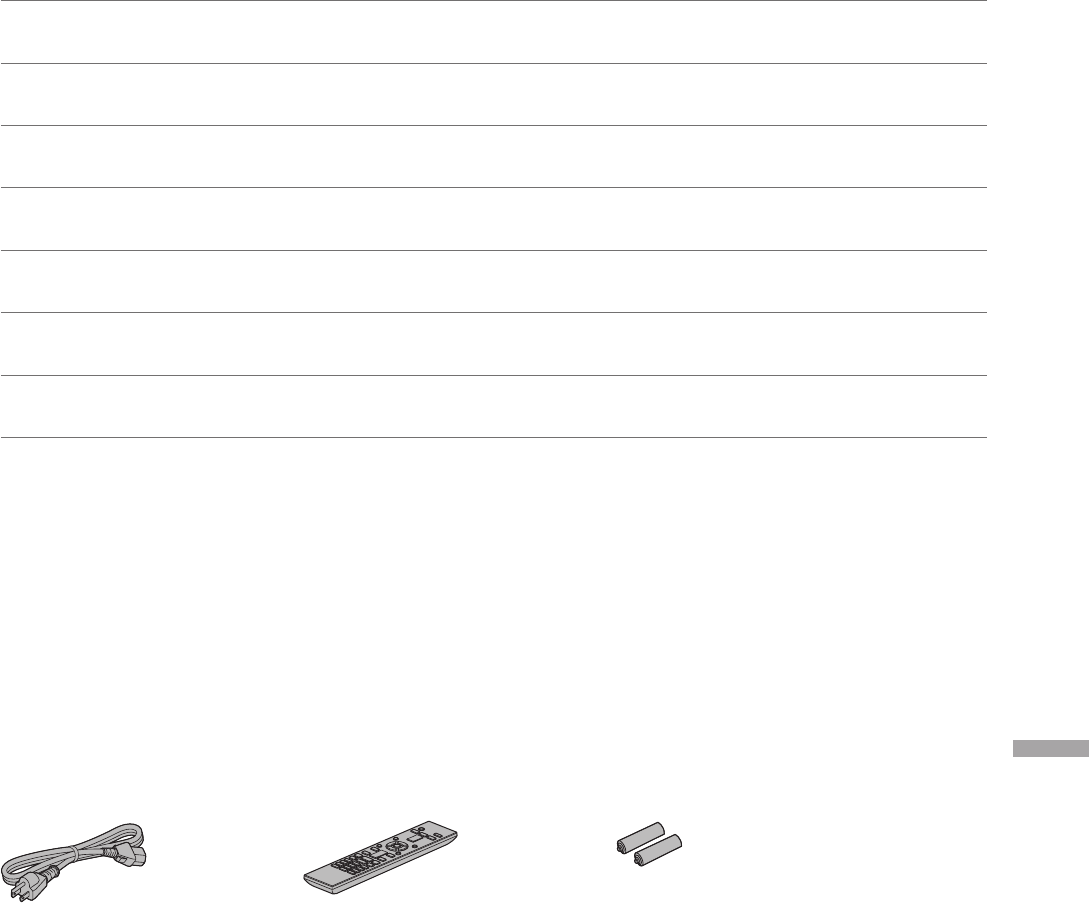
Français
07
Table des matières
IMPORTANTES MISES EN GARDE
09 Veuillez lire attentivement les “IMPORTANTES
MISES EN GARDE” de ce manuel avant utilisation.
Installation 11 Installation
Guide de référence 12 Unité principale, Télécommande
Connexions 16 Connexion des enceintes, Connexion du cordon
d’alimentation secteur, Configuration réseau
Fonctionnement 24 Lecture d’appareils connectés
Paramètres 36 Autres paramètres, Utilisation de la fonction de
correction de sortie (LAPC)
Guide de dépannage 40 Avant de faire appel à l’assistance, lisez la section
Dépannage.
Autres 45 Supports lisibles, Spécifications, etc.
Accessoires
Cordon d’alimentation (1)
K2CG3YY00191
Télécommande (1)
N2QAYA000115
Piles pour la télécommande (2)
(SEULEMENT POUR LE CANADA)
La feuille d’autocollants en français ci-incluse correspond aux noms des touches, prises et voyants sur
l’appareil.
• Les numéros de produit fournis dans ce manuel de l’utilisateur sont exacts en décembre 2015.
• Ces numéros peuvent être modifiés sans préavis.
• Ne pas utiliser le cordon d’alimentation avec aucun autre appareil.
(53)

08
Licenses
Le logo Wi-Fi CERTIFIED™ est une marque de
certification de Wi-Fi Alliance®.
Le symbole Wi-Fi Protected Setup™ est une
marque de certification de Wi-Fi Alliance®.
“Wi-Fi®” est une marque déposée de Wi-Fi Alliance®.
“Wi-Fi Protected Setup™”, “WPA™”, et “WPA2™” sont
des marques commerciales de Wi-Fi Alliance
®
.
Les mentions “Conçu pour iPod”, “Conçu pour
iPhone” et “Conçu pour iPad” signifient qu’un
accessoire électronique a été spécialement conçu
pour y connecter un iPod, un iPhone, ou un iPad,
respectivement, et que son concepteur atteste
qu’il répond aux normes de performance d’Apple.
Apple ne saura être tenue responsable du
fonctionnement de cet appareil ni de sa
conformité aux normes de sécurité et de
réglementation en vigueur.
Veuillez noter que l’utilisation de cet accessoire
avec un iPod, un iPhone ou un iPad peut nuire
à la performance sans fil.
AirPlay, iPad, iPhone, iPod, iPod nano et iPod
touch sont des marques déposées par Apple
Inc., enregistrées aux États-Unis et dans
d’autres régions.
iPad Air et iPad mini sont des marques de
commerce de Apple Inc.
Google Play et Android sont des marques de
Google Inc.
Windows est une marque commerciale ou une
marque déposée de Microsoft Corporation aux
États-Unis et dans d’autres pays.
Mac et OS X sont des marques de commerce de Apple
Inc., déposées aux États-Unis et dans les autres pays.
La marque et les logos Bluetooth® sont des
marques déposées appartenant à Bluetooth
SIG, Inc. et toute utilisation de telles marques
par Panasonic Corporation est sous licence.
Les autres marques de commerce et
dénominations commerciales appartiennent à
leurs propriétaires respectifs.
Le logiciel aptX® est protégé par les droits
d’auteur de CSR plc ou des entreprises de son
groupe. Tous droits réservés.
La marque aptX® et le logo aptX sont des
marques de commerce de CSR plc ou de l’une
des entreprises de son groupe et peuvent être
déposés dans une ou plusieurs juridictions.
DLNA, le logo DLNA et DLNA CERTIFIED sont
des marques de commerce, des marques de
service ou des marques de certification de la
Digital Living Network Alliance.
La technologie de codage audio MPEG Layer-3
est sous licence de Fraunhofer IIS et Thomson.
Windows Media et le logo Windows sont
soit des marques déposées, soit des marques
de commerce de Microsoft Corporation aux
États-Unis et/ou dans d’autres pays. Ce produit
est protégé par des droits sur la propriété
intellectuelle de Microsoft Corporation et
de tiers. L’utilisation ou la distribution d’une
telle technologie sans ce produit est interdite
sans une licence de Microsoft ou d’une filiale
Microsoft autorisée ou de tiers certifiés.
Décodeur FLAC
Copyright (C) 2000, 2001, 2002, 2003, 2004,
2005, 2006, 2007, 2008, 2009 Josh Coalson
La redistribution et l’emploi sous formes
source et binaire, avec ou sans modification,
sont autorisés à condition que :
- La redistribution du code source retienne l’avis
de copyright ci-dessus, la liste des conditions
et l’avis de non-responsabilité suivant.
- Les redistributions sous forme binaire
reproduisent l’avis de copyright ci-dessus, la liste
des conditions et l’avis de non-responsabilité
suivant dans la documentation et/ou les
matériaux qui accompagnent la distribution.
- Ni le nom de Xiph.org Foundation ni les noms
de ses collaborateurs ne doivent en aucun
cas être utilisés pour endosser ou promouvoir
des produits dérivés de ce logiciel sans
permission préalable écrite.
CE LOGICIEL EST FOURNI “TEL QUEL” PAR LES
DÉTENTEURS DE DROITS D’AUTEUR ET LEURS
COLLABORATEURS ET TOUTE GARANTIE
EXPRESSE OU IMPLICITE, Y COMPRIS MAIS
NON LIMITÉE AUX GARANTIES IMPLICITES
DE QUALITÉ MARCHANDE ET D’APTITUDE
POUR UN OBJECTIF DONNÉ, EST REJETÉE.
EN AUCUN CAS, LA FONDATION OU SES
COLLABORATEURS NE SERONT RESPONSABLES
DES DÉGÂTS DIRECTS, INDIRECTS, INCIDENTS,
SPÉCIAUX, EXEMPLAIRES OU CONSÉCUTIFS (Y
COMPRIS MAIS NON LIMITÉ À LA FOURNITURE
DE BIENS OU DE SERVICES DE REMPLACEMENT,
DE PERTE D’UTILISATION, DE DONNÉES OU DE
PROFITS, OU D’INTERRUPTION D’AFFAIRES)
QUELLE QU’EN SOIT LA CAUSE ET QUELLE QUE
SOIT LA THÉORIE DE RESPONSABILITÉ, QU’ELLE
DÉCOULE D’UN CONTRAT, DE RESPONSABILITÉ
STRICTE OU D’ACTE DÉLICTUEL (Y COMPRIS
NÉGLIGENCE OU AUTRE) DÉCOULANT DE
L’EMPLOI DE CE LOGICIEL, MÊME EN CAS
D’ANNONCE LA POSSIBILITÉ DE TELS DÉGÂTS.
(54)

Français
09
IMPORTANTES MISES EN GARDE
IMPORTANTES MISES EN GARDE
Avant d’utiliser l’appareil, lire attentivement
les instructions qui suivent. Se conformer tout
particulièrement aux avertissements inscrits sur
l’appareil et aux consignes de sécurité indiquées
ci-dessous. Conserver le présent manuel pour
consultation ultérieure.
1 Lire attentivement ces instructions.
2 Conserver ces instructions.
3 Lire toutes les mises en garde.
4 Suivre toutes les instructions.
5 Ne pas utiliser cet appareil près d’une source d’eau.
6 Ne nettoyer qu’avec un chiffon sec.
7 Ne pas bloquer les évents d’aération. Installer
l’appareil selon les instructions du fabricant.
8 Ne pas installer l’appareil près d’un appareil de
chauffage tel qu’un radiateur, une cuisinière, un
registre de chaleur ou tout dispositif émettant de la
chaleur (y compris un amplificateur).
9 Pour des raisons de sécurité, ne pas modifier la
fiche polarisée ou celle de mise à la terre. Une fiche
polarisée est une fiche à deux lames, dont une plus
large. Une fiche de mise à la terre est une fiche à
deux lames avec une broche de masse. La lame plus
large ou la broche de masse procure une protection
accrue. Si ce genre de fiche ne peut être inséré
dans une prise de courant, communiquer avec un
électricien pour remplacer la prise.
10 S’assurer que le cordon est placé dans un endroit
où il ne risque pas d’être écrasé, piétiné ou coincé.
Faire particulièrement attention à ses extrémités de
branchement, y compris sa fiche.
11 N’utiliser que les accessoires ou périphériques
recommandés par le fabricant.
12 N’utiliser l’appareil qu’avec un
chariot, meuble, trépied, support ou
table recommandé par le fabricant
ou vendu avec l’appareil. Lors de
l’utilisation d’un chariot, le déplacer
avec le plus grand soin afin d’éviter
tout dommage.
13 Débrancher cet appareil lors d’un orage ou en cas
de non-utilisation prolongée.
14 Confier l’appareil à un technicien qualifié pour
toute réparation : cordon d’alimentation ou fiche
endommagé, liquide renversé ou objet tombé
dans l’appareil, exposition à la pluie ou à une
humidité excessive, mauvais fonctionnement ou
échappement de l’appareil.
AVERTISSEMENT
Appareil
• Pour réduire les risques d’incendie, de choc électrique
ou de dommages à l’appareil,
- N’exposez pas cet appareil à la pluie, à l’humidité, à
l’égouttement ou aux éclaboussements.
- Ne placez sur l’appareil aucun objet rempli de
liquide, comme par exemple des vases.
- Utilisez exclusivement les accessoires
recommandés.
- Ne retirez pas les couvercles.
- Toute réparation doit être faite par un personnel
qualifié et non par l’usager.
- Ne laissez aucun objet en métal tomber à l’intérieur
de cet appareil.
- Ne posez pas d’objets lourds sur cet appareil.
Cordon d’alimentation c.a.
• La fiche d’alimentation permet de déconnecter
l’appareil.
L’appareil doit être installé à proximité d’une prise
secteur facile d’accès.
• Assurez-vous que la lame pour la mise à la terre
est insérée bien à fond afin de prévenir tout choc
électrique.
- Un appareil de classe 1 peut être branché dans une
prise secteur avec une protection pour mise à la
terre.
ATTENTION
Appareil
• Ne placer aucune source de flamme nue, telles des
bougies allumées, sur l’appareil.
• Il est possible que cette unité reçoive des
interférences provenant de téléphones cellulaires
pendant son utilisation. Si de telles interférences se
produisent, veuillez éloigner l’unité du téléphone
cellulaire.
Emplacement
• Positionner cet appareil sur une surface plane.
• Pour réduire les risques d’incendie, de choc électrique
ou de dommages à l’appareil,
- Ne pas installer cet appareil dans une bibliothèque,
une armoire ou tout autre espace confiné. S’assurer
que la ventilation de l’appareil est adéquate.
- Ne pas obstruer les évents d’aération de l’appareil
avec des journaux, des nappes, des rideaux ou
d’autres objets similaires.
- Ne pas exposer cet appareil aux rayons directs du
soleil, aux températures élevées, à une humidité
élevée et à des vibrations excessives.
• Assurez-vous que l’emplacement d’installation est
suffisamment robuste pour supporter le poids de
cette unité ( 47).
• Installer les enceintes à au moins 10 mm (13/32 po) de
la chaîne pour assurer une ventilation adéquate.
• Ne soulevez et ne portez pas cette unité en la tenant
par les boutons ou l’antenne. Cela pourrait faire
tomber l’appareil, mener à des blessures ou à des
anomalies de fonctionnement de cet appareil.
Pile
• Il y a un danger d’explosion si la pile n’est pas
correctement remplacée. Remplacez uniquement par
le type recommandé par le fabricant.
• Manipuler de façon incorrecte les piles peut causer
une fuite d’électrolyte ainsi qu’un incendie.
- Retirez la pile si vous n’avez pas l’intention d’utiliser
la télécommande pendant un long moment.
Rangez-la dans un endroit frais et sombre.
- Ne chauffez pas et n’exposez pas les piles à une
flamme.
- Ne laissez pas la (les) pile(s) dans un véhicule
exposé directement aux rayons du soleil pendant
un long moment avec fenêtres et portières
fermées.
- Ne pas démonter ou court-circuiter les piles.
(55)
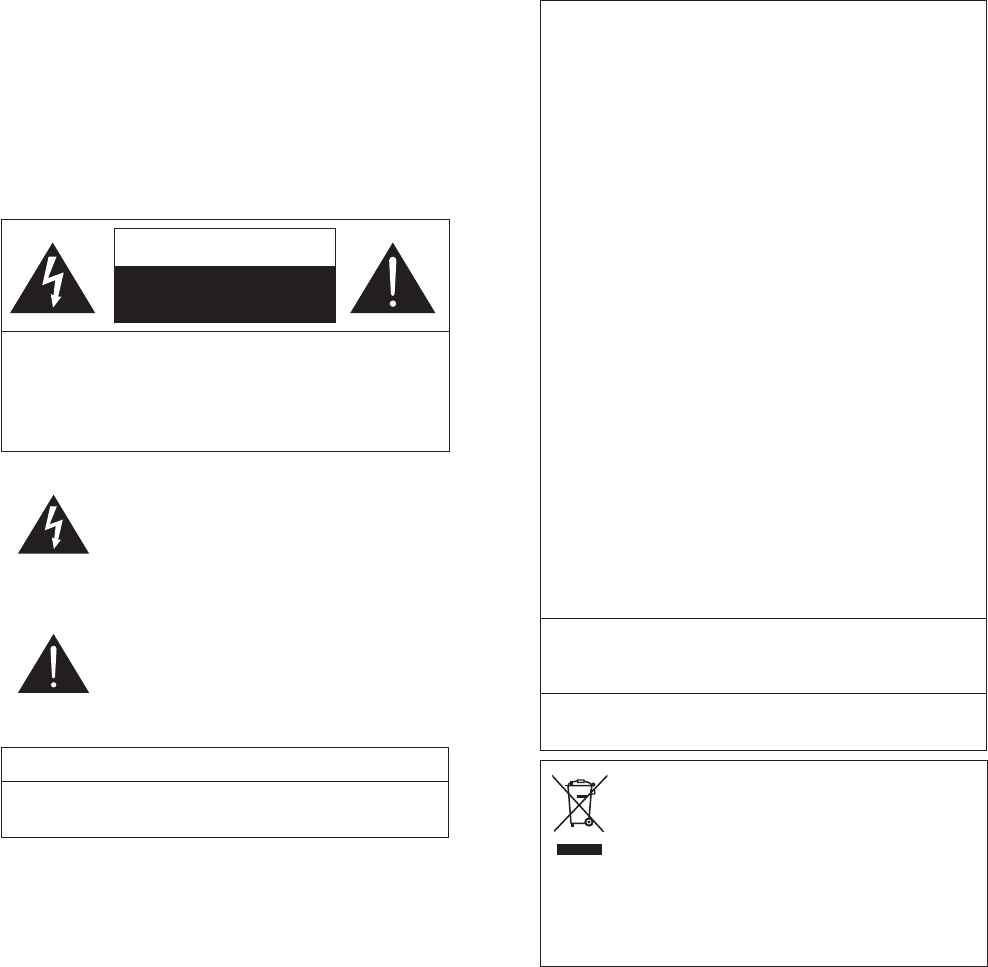
10
IMPORTANTES MISES EN GARDE
(56)
- Ne rechargez pas des piles alcalines ou au
manganèse.
- Ne pas utiliser des piles dont le revêtement a été
enlevé.
- Ne mélangez pas les anciennes piles avec les piles
neuves ou différents types de piles.
• Pour jeter les piles, veuillez contacter les autorités
locales ou votre revendeur afin de connaître la
procédure d’élimination à suivre.
AVIS
RISQUE DE CHOC ÉLECTRIQUE
NE PAS OUVRIR
AVIS : AFIN DE PRÉVENIR LE RISQUE DE
CHOCS ÉLECTRIQUES, NE PAS RETIRER
LES VIS.
CONFIER TOUTE RÉPARATION À UN
TECHNICIEN QUALIFIÉ.
Le symbole de l’éclair dans un triangle
équilatéral indique la présence
d’une tension suffisamment élevée
pour engendrer un risque de chocs
électriques.
Le point d’exclamation dans un
triangle équilatéral indique que
le manuel d’utilisation inclus avec
l’appareil contient d’importantes
recommandations quant au
fonctionnement et à l’entretien de ce
dernier.
Conforme à la norme CAN/CSA C22.2 No.60065.
La marque d’identification du produit est située sur le
panneau arrière de l’appareil.
CE QUI SUIT NE S’APPLICQUE QU’AUX ÉTATS-
UNIS ET AU CANADA.
Cet appareil est conforme à la section 15 de la
réglementation de la FCC et à la section CNR-Gen de
la réglementation IC.
Son utilisation est soumise aux deux conditions
suivantes :
(1) cet appareil ne doit pas provoquer d’interférence
et
(2) cet appareil doit tolérer les différentes
interférences reçues, y compris les interférences
susceptibles de provoquer un dysfonctionnement.
FCC ID : ACJ-SU-G30
IC : 216A-SUG30
Cet émetteur ne doit pas être placé à proximité d’une
autre antenne ou d’un autre émetteur, ni être utilisé
de pair avec de tels autres appareils.
Cet équipement est conforme aux limites
d’exposition aux radiations FCC/IC établies pour un
environnement non contrôlé et se conforme aux
exigences de conformité pour l’exposition aux RF IC,
dans le supplément C, aux normes OET65 et CNR-
102. Cet appareil présente de très faibles niveaux
d’énergie RF jugés conformes sans évaluation de
l’exposition permise maximale (MPE). Mais il est
souhaitable de l’installer et de l’utiliser à une distance
d’au moins 20 cm (7 7/8 po) du corps (extrémités non
comprises : mains, poignets, pieds et chevilles).
Ce dispositif est limité à être utilisé en intérieur en
raison de son fonctionnement dans la plage de
fréquences 5,15 à 5,25 GHz.
CE QUI SUIT NE S’APPLIQUE QU’AU CANADA.
CAN ICES-3(B)/NMB-3(B)
Information sur la mise au rebut dans
les pays n’appartenant pas à l’Union
européenne
Ce symbole est uniquement valide dans
l’Union européenne.
Si vous désirez mettre ce produit au rebut,
contactez l’administration locale ou le
revendeur et informez-vous de la bonne
façon de procéder.

11
Français
IMPORTANTES MISES EN GARDE / Installation
Installation
• Mettre tous les appareils hors tension et lire leur
manuel d’utilisation.
Entretien de l’appareil
• Débrancher le cordon d’alimentation avant de
procéder à l’entretien de l’appareil. Nettoyer cet
appareil avec un chiffon doux.
• Si l’appareil est particulièrement sale, utiliser
un chiffon humide bien essoré pour essuyer la
saleté, puis essuyer l’appareil avec un chiffon
doux.
• Ne pas utiliser de solvants tels que la benzine,
du diluant, de l’alcool, des détergents de
cuisine, etc. Cela pourrait modifier l’apparence
du boîtier externe ou décoller son revêtement.
Installation
(57)
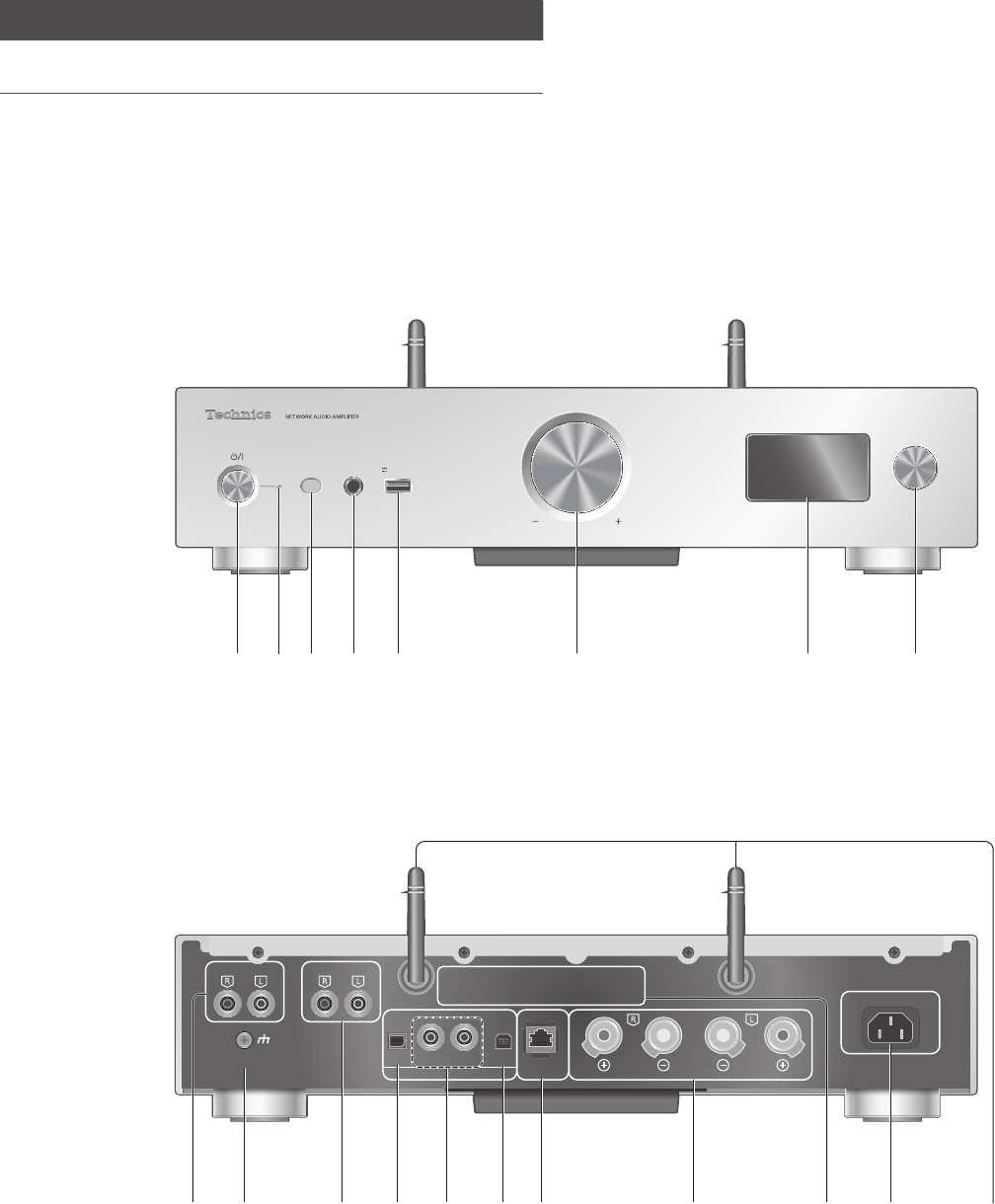
12
Guide de référence
Unité principale
5V 2.1APHONES
VOLUME
INPUT SELECTOR
LAN
DIGITAL IN 10BASE-T /
100BASE-TX
SPEAKERS
(4∼16Ω)
AC IN ∼
OPT COAX1 COAX2 PC
PHONO
PHONO
EARTH
LINE IN
(58)

13
Français
Guide de référence
01 Interrupteur d’attente/marche ( )
• Appuyer sur cet interrupteur pour commuter l’appareil du mode
d’attente au mode de marche et vice versa. En mode d’attente,
l’appareil continue de consommer une petite quantité de courant.
02 Voyant d’alimentation
• Bleu : L’unité est en marche.
• Rouge : L’unité est en veille dans l’état suivant.
- La fonction Veille réseau est disponible. ( 37)
- Chargement d’un iPhone/iPad/iPod ( 29)
• Éteint : L’unité est en veille sans aucune fonction disponible.
03 Capteur de signal de télécommande
• Distance : À l’intérieur d’environ 7 m (23 pi), directement en avant
• Angle : environ 30° vers la gauche ou la droite
04 Prise des écouteurs/casque d’écoute
• Lorsqu’une fiche est branchée, les enceintes n’émettent pas de son.
• Une pression sonore excessive provenant d’écouteurs ou d’un
casque audio peut provoquer une perte auditive.
• L’écoute prolongée à volume élevé peut endommager l’audition de
l’utilisateur.
05 Borne USB-A
• Port pour iPhone/iPad/iPod et les appareils USB ( 28, 29)
06 Molette du volume
• -- dB (min), -99,0 dB à 0 dB (max)
• Si le son de cette unité est coupé, il vous suffit de tourner la
molette pour le rétablir.
07 Afficheur
• Source d’entrée, État de la lecture, etc., sont affichés. Pour plus de
détails, accédez à :
www.technics.com/support/
08 Molette de sélection d’entrée
• Tournez cette molette dans le sens horaire ou antihoraire pour
commuter la source d’entrée.
09 Bornes d’entrée audio analogique (PHONO) ( 34)
• Les cartouches MM sont prises en charge.
10 Borne PHONO EARTH ( 34)
• Connexion du fil de terre d’un tourne-disque.
11 Bornes d’entrée audio analogique (LINE IN) ( 34)
12 Borne d’entrée optique numérique ( 32)
13 Bornes d’entrée numérique coaxiale ( 32)
14 Borne USB-B
• Pour brancher à un PC, etc. ( 33)
15 Borne LAN ( 18)
16 Bornes de sortie d’enceinte ( 16)
17 Plaque signalétique
• Le numéro du modèle est indiqué.
18 Prise d’alimentation c.a. ( 17)
19 Antenne LAN sans fil ( 19)
(59)
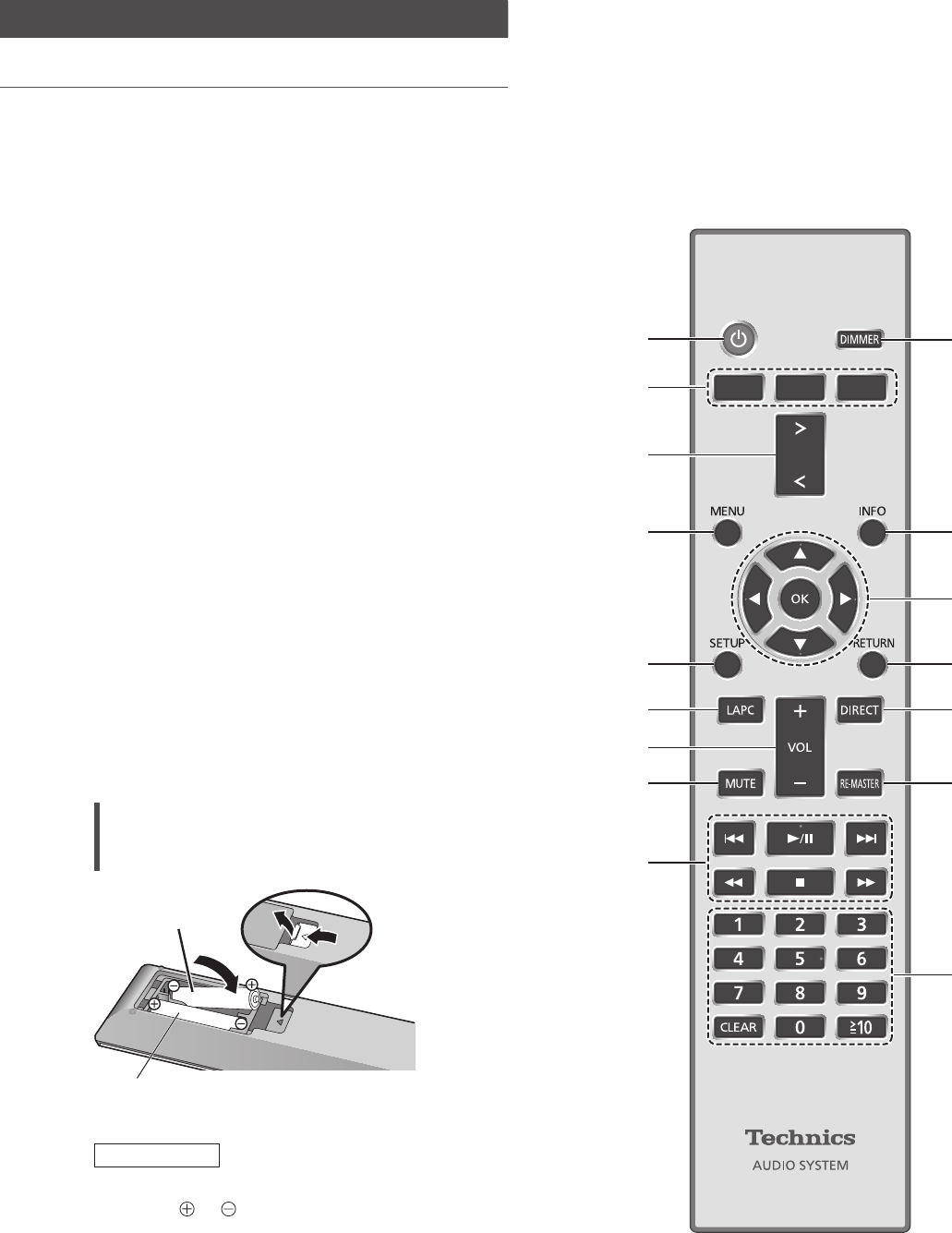
14
Guide de référence
Télécommande
NET
DIGITAL
INPUT
ANALOG
Fonctionnement de la
télécommande
2
1
R03/LR03, AAA
(Utiliser des piles alcalines ou au manganèse)
Remarque
• Placer les piles de manière à respecter la
polarité ( et ).
• Pointer en direction du capteur de signal de la
télécommande de cet appareil. ( 12)
• Conserver les piles hors de portée des enfants
pour éviter qu’ils les avalent.
(60)

15
Français
Guide de référence
Code de télécommande
Si d’autres appareils répondent au signal de la
télécommande fournie, modifier le code de la
télécommande.
• Par défaut, cette fonction est réglée sur “Mode
1”.
1 Appuyer sur [SETUP].
2 Appuyer sur [ ], [ ] pour sélectionner
“Télécommande”, puis appuyer sur
[OK].
• Le code actuel de la télécommande de cette
unité est affiché.
3 Lorsque “Régler mode 1/2” est
affiché, paramétrez le code de la
télécommande.
Pour paramétrer le “Mode 1” :
Maintenez enfoncé [OK] et [1] pendant au
moins 4 secondes.
Pour paramétrer le “Mode 2” :
Maintenez enfoncé [OK] et [2] pendant au
moins 4 secondes.
4 Pointez la télécommande vers cette
unité et maintenez enfoncé [OK]
pendant au moins 4 secondes.
• Lorsque le code de la télécommande est
modifié, le nouveau code s’affichera à l’écran
pendant quelques secondes.
■ Lorsque “Télécom.1” ou “Télécom.2” est
affiché
Lorsque “Télécom.1” ou “Télécom.2” est affiché,
les codes de télécommande de cette unité et
de la télécommande sont différents. Effectuez
l’étape 3 ci-dessus.
(61)
01 [] : Interrupteur d’attente/marche
• Appuyer sur cet interrupteur pour
commuter l’appareil du mode d’attente au
mode de marche et vice versa. En mode
d’attente, l’appareil continue de consommer
une petite quantité de courant.
02 [NET]/[DIGITAL]/[ANALOG] :
Pour sélectionner l’appareil à utiliser
( 24, 28, 29, 30, 31, 32, 33, 34)
03 [>INPUT<] : Pour sélectionner la source
04 [MENU] : Pour accéder au menu
( 24, 25, 27, 28, 30, 31)
05 [SETUP] : Pour accéder au menu de
configuration ( 36)
06 [LAPC] : Mesurer le signal de sortie de
l’amplificateur et corriger sa puissance
( 39)
07 [+VOL-] : Réglage du volume
• -- dB (min), -99,0 dB à 0 dB (max)
08 [MUTE] : Mise en sourdine
•
Appuyez de nouveau sur [MUTE] pour annuler.
“MUET” est également annulé lorsque vous
réglez le volume ou mettez l’unité en veille.
09 Touches de commande des fonctions de
lecture de base
10 [DIMMER] : Réglage de la luminosité de
l’affichage, etc.
• Lorsque l’affichage est éteint, il ne
s’allumera que lorsque vous utilisez cet
appareil. Avant que l’affichage ne s’éteigne
à nouveau, “Affichage éteint” s’affichera
pendant quelques secondes.
• Appuyez plusieurs fois pour changer la
luminosité.
11 [INFO] :
Pour voir les informations du contenu
• Appuyez sur ce bouton pour afficher le nom
de la piste, de l’artiste et de l’album, le type
de fichier, la fréquence d’échantillonnage
et d’autres informations. (Les informations
varient en fonction de la source d’entrée).
12 [], [ ], [ ], [ ]/[OK] : Sélection/OK
13 [RETURN] : Retour à l’affichage précédent
14 [DIRECT] :
Activer/désactiver le mode Direct
15
[RE-MASTER] : Activer/désactiver Re-master
16 Touches numériques, etc.
•
Pour sélectionner un numéro à 2 chiffres
Exemple :
16 : [ 10] > [1] > [6]
•
Pour sélectionner un numéro à 4 chiffres
Exemple :
1234 : [ 10] > [ 10] > [ 10] > [1] > [2] > [3]
> [4]
• [CLEAR] : Pour supprimer la valeur saisie.
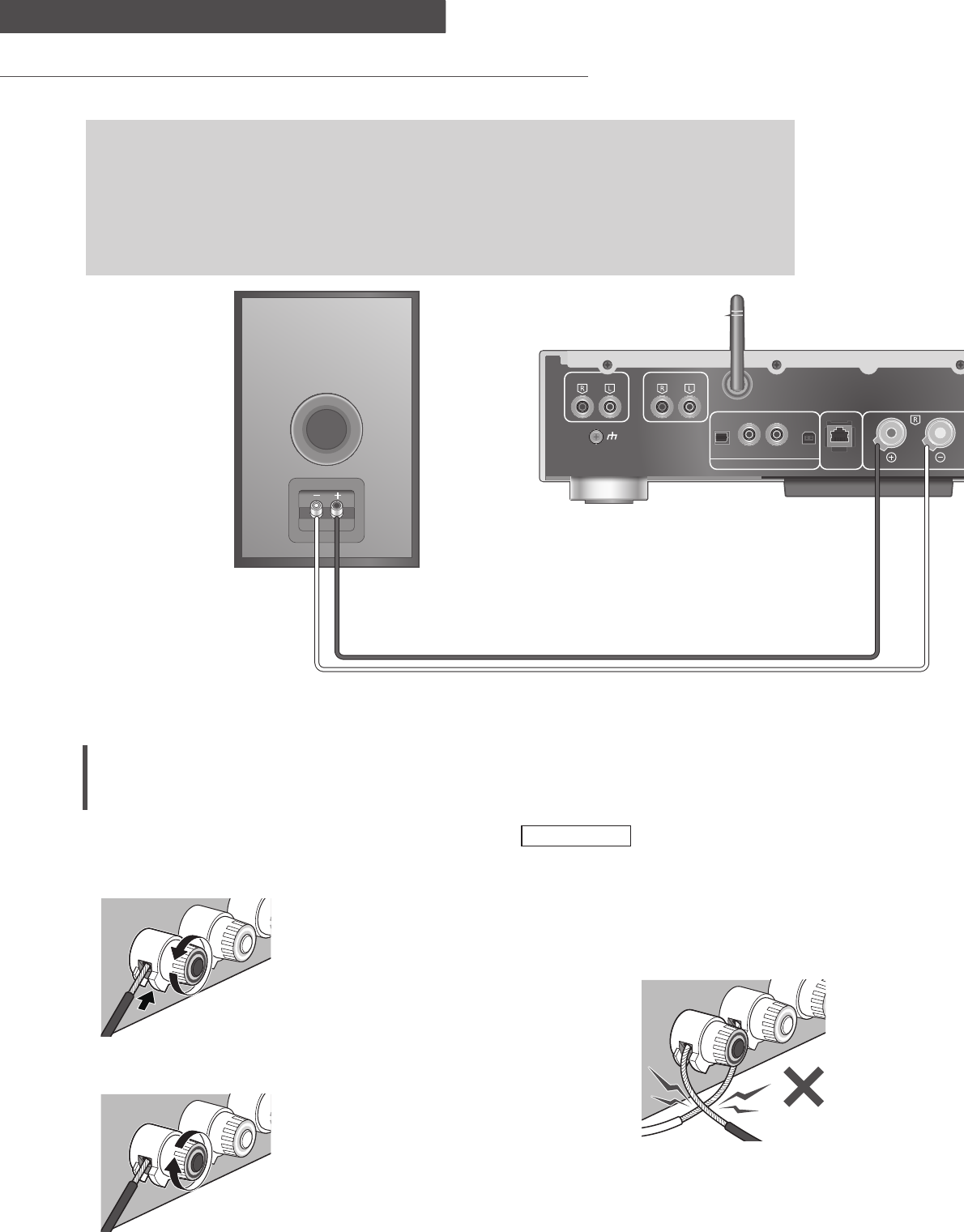
16
Connexions
Enceintes/Cordon d’alimentation secteur
LAN
DIGITAL IN 10BASE-T /
100BASE-TX
SPEA
(4∼
1
OPT COAX1 COAX2 PC
PHONO
PHONO
EARTH
LINE IN
• N’utilisez que le cordon d’alimentation secteur fourni.
• Ne branchez pas le cordon d’alimentation secteur avant d’avoir effectué tous les autres
raccordements.
• Insérez les fiches des câbles à brancher jusqu’au bout.
• Ne tordez pas les câbles.
• Afin d’optimiser la sortie audio, vous pouvez mesurer le signal de sortie de l’amplificateur et
corriger sa puissance lorsqu’il est connecté aux haut-parleurs. ( 39)
(62)
Câble d’enceinte (non fourni)
Connexion des enceintes
1 Tournez les molettes pour les
desserrer et insérez les fils centraux
dans les orifices.
2 Serrez les molettes.
Remarque
• Lorsque les raccordements sont terminés, tirez
légèrement sur les câbles de haut-parleur pour
vérifier qu’ils sont bien branchés.
• Veillez à ne pas croiser (court-circuiter) ou
inverser la polarité des fils de haut-parleur, car
cela risque d’endommager l’amplificateur.
INTERDIT
• Câblez correctement la polarité (+/-) des bornes.
Sinon, cela peut nuire aux effets stéréo ou
causer des dysfonctionnements.
• Pour plus de détails, référez-vous au mode
d’emploi des haut-parleurs.
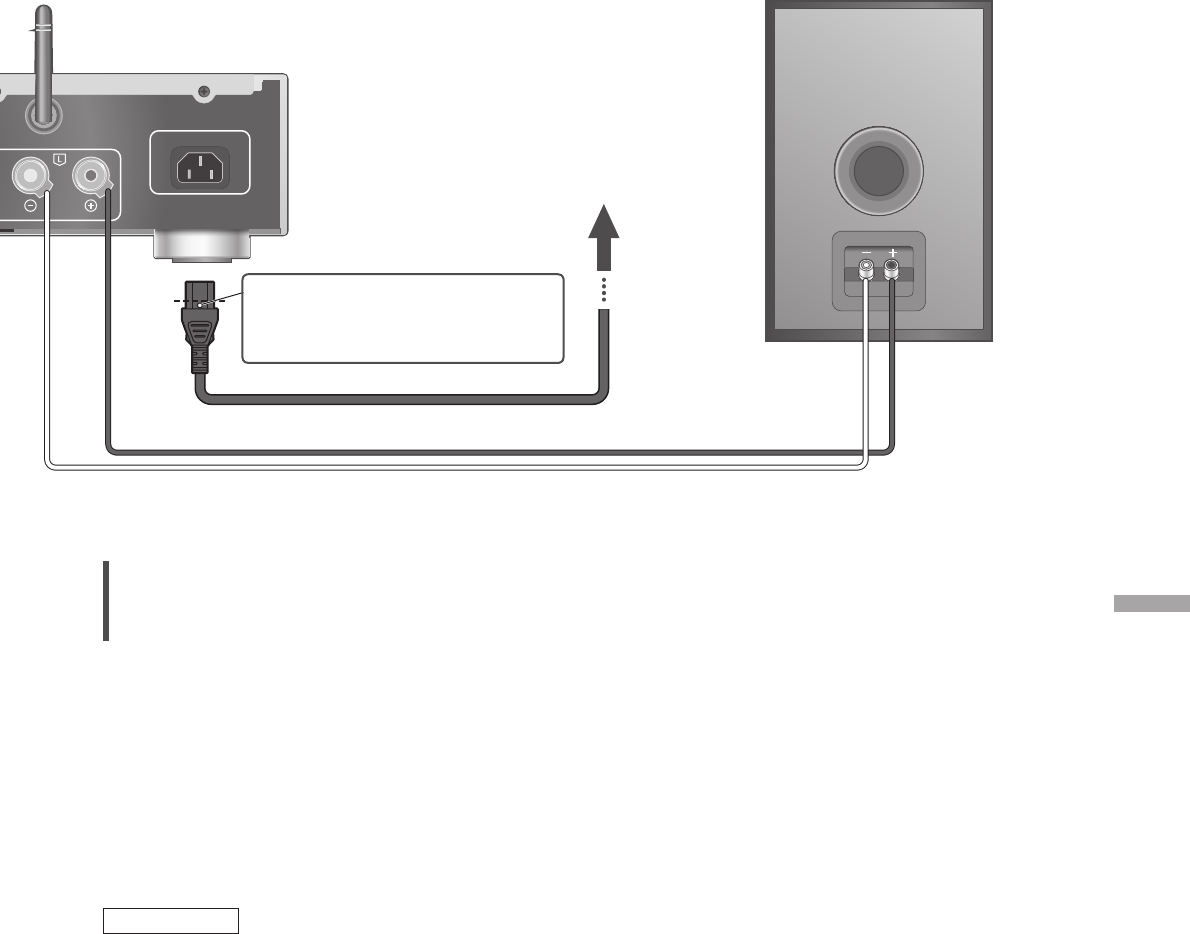
17
Français
Connexions
KERS
1
6Ω)
AC IN ∼
(63)
Connexion du cordon d’alimentation
secteur
Branchez le cordon d’alimentation après
que tous les autres raccordements sont
complétés.
• Le paramétrage LAN sans fil (Wi-Fi®) peut
démarrer lorsque cette unité est mis en
marche. Si vous arrêtez le paramétrage Wi-Fi,
sélectionnez “Désactivé” sur l’écran “Conf. Wi-
Fi”.
Sélectionnez “Activé” pour conserver le
paramétrage Wi-Fi. ( 19)
Remarque
• Cette unité consomme une petite quantité de
courant alternatif ( 47) même lorsqu’elle est
en veille. Retirez la prise du secteur lorsque
vous n’utilisez pas l’unité pendant une longue
période. Positionnez l’unité pour pouvoir
facilement débrancher la prise.
Câble d’enceinte (non fourni)
Cordon d’alimentation secteur (fourni)
Sur une prise secteur
du domicile
Insérez le cordon d’alimentation
secteur au point situé juste
avant le trou rond.

18
Connexions
Configuration réseau
Remarque
• Si vous tentez de modifier les paramètres
réseau immédiatement après avoir mis cette
unité en marche, l’apparition de l’écran de
configuration du réseau peut prendre du temps.
Vous pouvez lire en continu de la musique provenant d’un dispositif iOS (iPhone/iPad/iPod), d’un
Android™ ou d’un ordinateur (Mac/Windows) sur cet appareil grâce aux fonctions AirPlay ou DLNA.
( 24, 26)
Pour utiliser ces fonctions, cet appareil doit être sur le même réseau que l’appareil compatible avec
AirPlay ou que l’appareil compatible avec DLNA.
Ce système peut être connecté à un routeur à
l’aide d’un câble réseau ou du Wi-Fi® intégré.
Pour obtenir une connexion au réseau stable,
une connexion LAN filaire est préférable.
Connexion au réseau local branché
LAN
DIGITAL IN 10BASE-T /
100BASE-TX
SPEAKERS
(4∼16Ω)
AC IN ∼
OPT COAX1 COAX2 PC
Routeur à large
bande, etc.
Câble réseau local
(non fourni)
1 Débranchez le cordon d’alimentation
secteur.
2 Connectez cet appareil à un routeur
à large bande, etc., à l’aide d’un câble
réseau local.
3 Branchez le cordon d’alimentation
secteur de cette unité et appuyez sur
[]. ( 17)
• Une fois la connexion établie, “ ” est
affiché à l’écran.
Remarque
• Tandis que le cordon d’alimentation secteur est
débranché, le câble réseau doit être branché ou
débranché.
• Utilisez des câbles de réseau local droits de
catégorie 7 ou supérieure (STP) lors de leur
connexion à des appareils périphériques.
• Si vous insérez un câble autre qu’un câble
réseau local dans la prise réseau, vous pourriez
endommager l’unité.
• Si le câble LAN est débranché, les paramètres
liés au réseau reviennent aux paramètres par
défaut. Réeffectuez alors le paramétrage.
• La fonction Wi-Fi peut être désactivée lorsque
le câble réseau est raccordé.
(64)
5V 2.1APHONES
VOLUME
INPUT SELECTOR
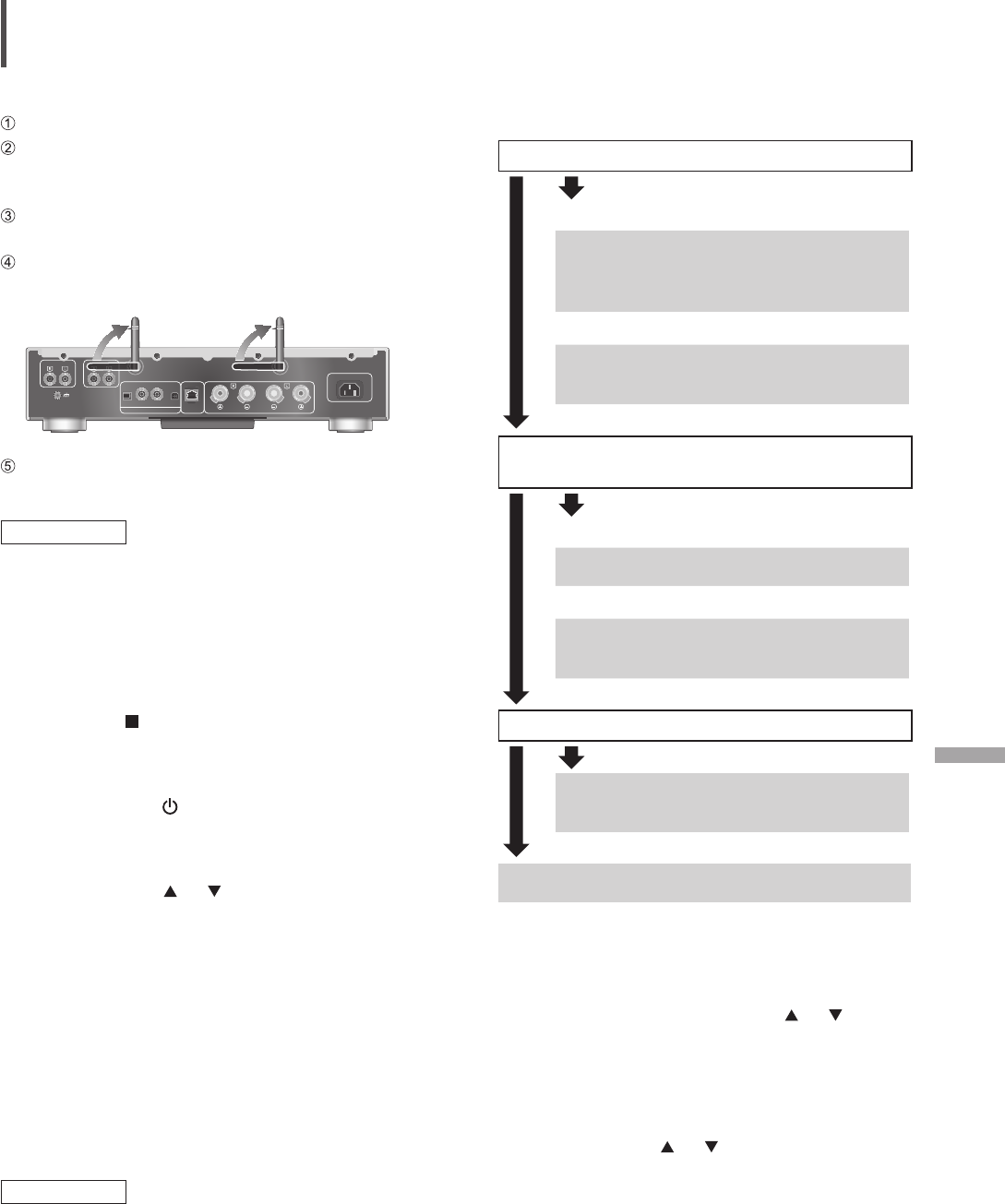
19
Français
Connexions
Connexion LAN sans fil
■ Préparatifs
Débranchez le cordon d’alimentation secteur.
Débranchez le câble réseau. (La fonction Wi-Fi
peut être désactivée lorsque le câble réseau
est raccordé.)
Rapprochez cette unité aussi près que possible
du routeur sans fil.
Faites pointer l’antenne à l’arrière de cette
unité comme indiqué sur la figure.
LAN
DIGITAL IN 10BASE-T /
100BASE-TX
SPEAKERS
(4∼16Ω)
AC IN ∼
OPT COAX1 COAX2 PC
PHONO
PHONO
EARTH
LINE IN
LINE IN
Branchez le cordon d’alimentation secteur de
cette unité. ( 17)
Remarque
• Ne faites jamais ce qui suit :
- Appliquer une forte pression sur l’antenne
- Porter cette unité en la tenant par son antenne
• Le paramétrage est annulé une fois la limite
de temps définie écoulée. Dans ce cas,
recommencez le paramétrage.
• Pour annuler ce paramétrage à mi-chemin,
appuyez sur [ ] ou mettez l’unité en veille.
■ Procéder aux réglages la première fois
1 Appuyez sur [ ] pour mettre cette
unité en marche.
• “Conf. Wi-Fi” s’affiche.
2 Appuyez sur [ ], [ ] pour sélectionner
“Activé”, puis appuyez sur [OK].
•
“Mode WAC pr iOS” démarre automatiquement.
3 (Pour “Mode WAC pr iOS”)
Procédez à l’étape 2 de “Utilisation
de la configuration WAC (Wireless
Accessory Configuration)” ( 20).
(Pour les autres méthodes de paramétrage
réseau)
Choisissez une méthode de
paramétrage réseau.
Remarque
• Lorsque cette unité est mise en veille et en
marche avant que le paramétrage Wi-Fi ne soit
terminé, “Conf. Wi-Fi” s’affiche. Effectuez le
paramétrage Wi-Fi ou choisissez “Désactivé”.
■ Sélection d’une méthode de paramétrage
réseau
Utilisez-vous un iPod touch/iPhone/iPad ?
Oui
(Version iOS 7.0 ou supérieure)
Utilisation de la configuration WAC
(Wireless Accessory Configuration)
( 20)
(Version iOS 5.0 ou supérieure)
Utilisation d’un iPhone/iPad/iPod
( 21)
Non
Votre routeur réseau sans fil prend-il en charge
le WPS (Wi-Fi Protected Setup™) ?
Oui
(Touche WPS)
Utilisation du bouton WPS ( 20)
(Code PIN (NIP) WPS)
Utilisation du code PIN (NIP) WPS
( 21)
Non
Utilisez-vous un appareil Android ?
Oui
Utilisation de l’application “Technics
Music App” ( 22)
Non
Utilisation d’un navigateur Internet ( 22)
■ Paramétrage avec le menu [SETUP]
1 Appuyez sur [SETUP].
2 Appuyez à répétition sur [ ], [ ] pour
sélectionner “Réseau”, puis appuyez
sur [OK].
• Lorsque l’écran “Wi-Fi” s’affiche, appuyez sur
[OK].
3 Appuyez sur [ ], [ ] pour sélectionner
“Activé”, puis appuyez sur [OK]. (La
fonction LAN sans fil est activée.)
4 Choisissez une méthode de
paramétrage réseau.
(65)
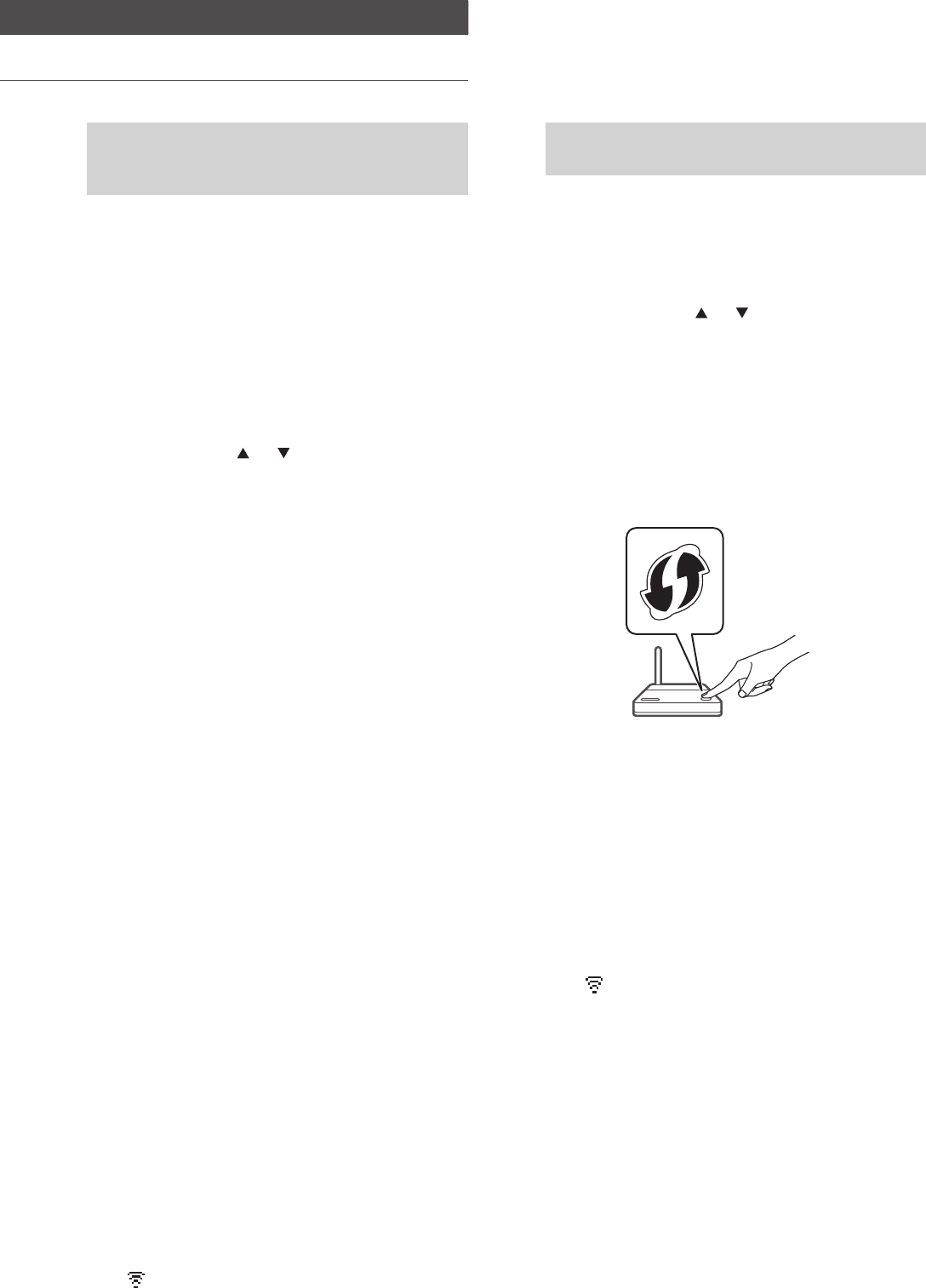
20
Connexions
Configuration réseau (suite)
Utilisation de la configuration WAC
(Wireless Accessory Configuration)
“Mode WAC pr iOS”
Vous pouvez envoyer sa configuration Wi-Fi à ce
système en utilisant un iPhone/iPad/iPod touch.
• Périphériques pris en charge :
iPhone/iPad/iPod touch (iOS version 7.0 ou
supérieure), ou Mac (OS X 10.9 ou supérieur,
avec utilitaire AirPort 6.3.1. ou supérieur)
• Les explications qui suivent concernent un
iPhone.
• Assurez-vous au préalable que votre iPhone est
connecté à votre réseau domestique sans fil.
1 Appuyez sur [ ], [ ] sur la
télécommande pour choisir “Mode
WAC pr iOS” puis appuyez sur [OK].
• “Réglage” s’affiche.
2 Accédez aux paramètres Wi-Fi sur
votre iPhone.
3 Choisissez “Technics SU-G30 ******”
dans “SET UP NEW AIRPLAY
SPEAKER...” sur votre iPhone.
• “******” représente un caractère unique
pour chaque système.
4 L’écran “AirPlay Setup” apparaît sur
votre iPhone.
• Ce système apparaît en tant que “Technics
SU-G30 ******”. Pour changer le nom,
saisissez-le pour remplacer l’existant. Vous
pouvez aussi renommer lorsque la connexion
réseau est configurée. ( 23)
• Vous pouvez définir un mot de passe pour ce
système dans “SPEAKER PASSWORD”. (Vous
aurez besoin de ce mot de passe la prochaine
fois que vous paramétrerez le réseau en
utilisant un navigateur Internet.)
5 Choisissez “Next” pour appliquer les
paramètres.
• “Liaison” s’affiche.
• Une fois la connexion établie, “Réussite” est
affiché à l’écran.
- “Échec” peut s’afficher si la connexion
n’a pas été effectuée. Essayez à nouveau
cette méthode depuis le menu [SETUP].
Si “Échec” s’affiche à nouveau, essayez
d’autres méthodes ( 19).
6 Appuyez sur [OK] sur la
télécommande pour quitter le
paramétrage.
• “ ” s’affiche.
Utilisation du bouton WPS
“Push WPS”
Si votre routeur sans fil prend en charge le
WPS, vous pouvez configurer une connexion en
appuyant sur le bouton WPS.
• Il se peut qu’un routeur sans fil compatible
dispose de l’identifiant WPS.
1 Appuyez sur [ ], [ ] sur la
télécommande pour choisir “Push
WPS” puis appuyez sur [OK].
• “WPS” s’affiche. Terminez l’étape 2 dans les
2 minutes.
2 Une fois que “WPS” est affiché,
appuyez sur le bouton WPS du
routeur sans fil.
Exemple :
• “Liaison” s’affiche.
• Une fois la connexion établie, “Réussite” est
affiché à l’écran.
- “Échec” peut s’afficher si la connexion
n’a pas été effectuée. Essayez à nouveau
cette méthode depuis le menu [SETUP].
Si “Échec” s’affiche à nouveau, essayez
d’autres méthodes ( 19).
3 Appuyez sur [OK] sur la
télécommande pour quitter le
paramétrage.
• “ ” s’affiche.
(66)
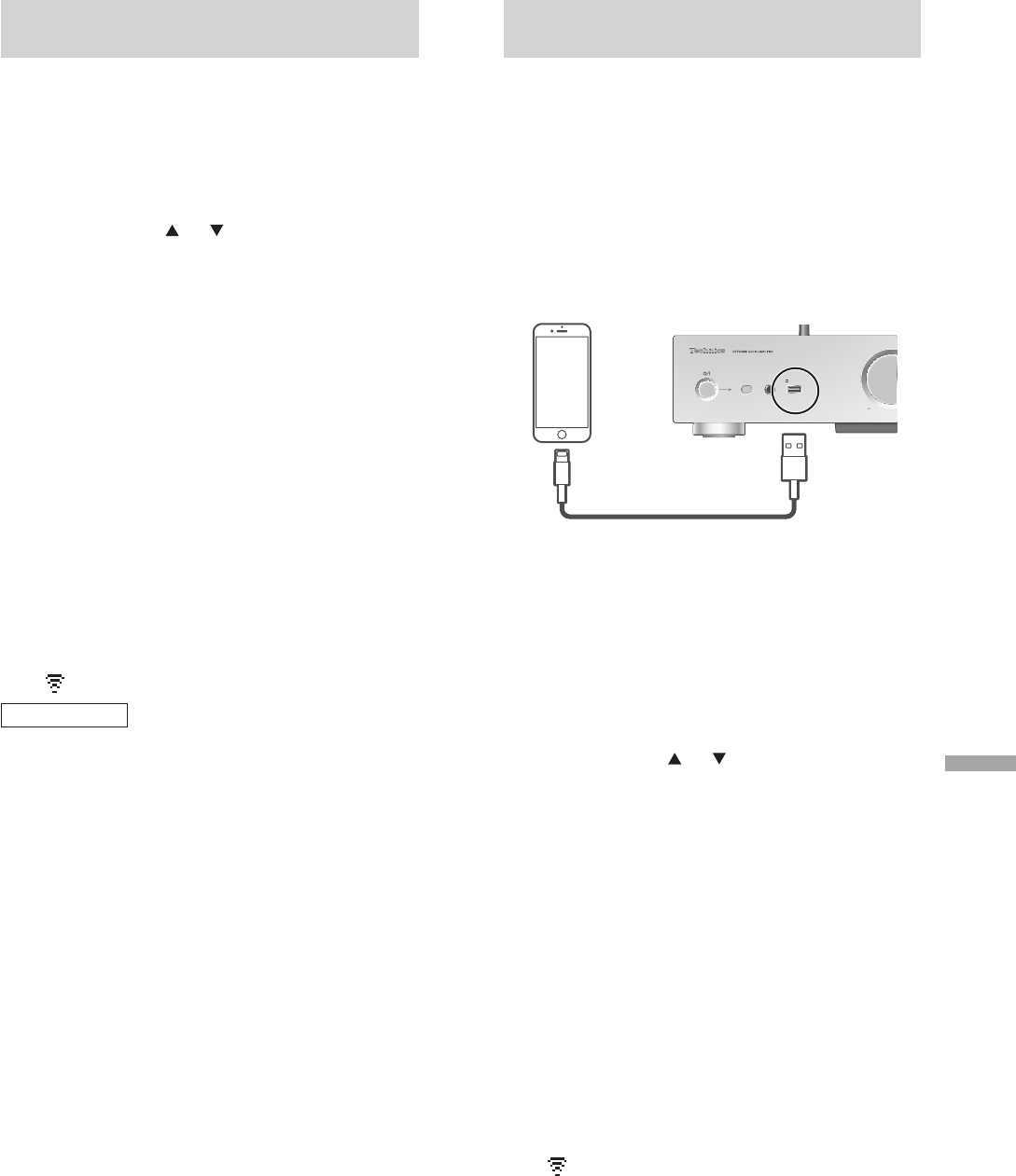
21
Français
Connexions
Utilisation d’un iPhone/iPad/iPod
“Avec iPod”
Grâce à cette méthode vous partagez les
paramètres de réseau sans fil de votre iPod/
iPhone/iPad avec ce système.
• Périphériques pris en charge :
iPhone/iPad/iPod touch (iOS version 5.0 ou
supérieure)
• Les explications qui suivent concernent un
iPhone.
• Assurez-vous au préalable que votre iPhone est
connecté à votre réseau domestique sans fil.
5V 2.1APHONES
VOLU
M
Câble USB
(fourni avec l’iPhone/iPad/iPod)
1 Raccordez l’iPhone à cette unité à
l’aide du câble USB.
• Utilisez le câble USB fourni avec l’iPhone/
iPad/iPod.
• Déverrouillez votre iPhone avant de le
raccorder.
2 Appuyez sur [ ], [ ] sur la
télécommande pour choisir “Avec
iPod” puis appuyez sur [OK].
• “Connexion Wi-Fi” s’affiche.
3 Autorisez l’iPhone à partager les
paramètres de réseau sans fil.
• Une fois la connexion établie, “Réussite” est
affiché à l’écran.
- “Échec” peut s’afficher si la connexion
n’a pas été effectuée. Essayez à nouveau
cette méthode depuis le menu [SETUP].
Si “Échec” s’affiche à nouveau, essayez
d’autres méthodes ( 19).
4 Appuyez sur [OK] sur la
télécommande pour quitter le
paramétrage.
• “ ” s’affiche.
Utilisation du code PIN (NIP) WPS
“PIN WPS”
Si votre routeur sans fil prend en charge le
WPS, vous pouvez configurer une connexion en
saisissant le code PIN (NIP) WPS.
• Pour plus de détails sur la manière dont saisir le
code PIN (NIP), référez-vous au mode d’emploi
du routeur sans fil.
1 Appuyez sur [ ], [ ] sur la
télécommande pour choisir “PIN WPS”
puis appuyez sur [OK].
• Le code PIN (NIP) est affiché. Terminez
l’étape 2 dans les 2 minutes.
2 Entrez le code PIN (NIP) dans le
routeur sans fil depuis le PC, etc.
• “Liaison” s’affiche.
• Une fois la connexion établie, “Réussite” est
affiché à l’écran.
- “Échec” peut s’afficher si la connexion
n’a pas été effectuée. Essayez à nouveau
cette méthode depuis le menu [SETUP].
Si “Échec” s’affiche à nouveau, essayez
d’autres méthodes ( 19).
3 Appuyez sur [OK] sur la
télécommande pour quitter le
paramétrage.
• “ ” s’affiche.
Remarque
• En fonction du routeur, les autres périphériques
connectés peuvent momentanément perdre
leur connexion.
• Pour plus de détails, référez-vous au mode
d’emploi du routeur sans fil.
(67)

22
Connexions
Configuration réseau (suite)
Utilisation d’un navigateur Internet
“Conf. dep. navig.”
Vous pouvez accéder aux paramètres réseau de
cette unité depuis un navigateur Internet sur un
appareil iOS (version iOS 6.1.6 ou antérieure),
Android, PC, etc.
• Les explications qui suivent concernent un
appareil Android.
1 Appuyez sur [ ], [ ] sur la
télécommande pour choisir “Conf.
dep. navig.” puis appuyez sur [OK].
• “Réglage” s’affiche.
2 Accédez aux paramètres Wi-Fi
de votre appareil compatible et
sélectionnez “00 Setup ******” pour
connecter à ce système.
• “******” représente un caractère unique
pour chaque système.
3 Démarrez le navigateur Internet et
saisissez “http://192.168.1.12/” dans la
barre d’adresse et lancez la page.
• Exemples de navigateurs Internet
- Périphérique iOS/Mac : Safari
- Périphérique Android : Google Chrome™
- PC : Windows Internet Explorer
4
Sélectionnez “Search wireless network”.
5
Sélectionnez le nom de votre réseau
domestique sans fil (Nom de réseau
(SSID)) et le mot de passe pour ce réseau.
6 Choisissez “JOIN” pour appliquer les
paramètres.
• “Liaison” s’affiche.
• Une fois la connexion établie, “Réussite” est
affiché à l’écran.
- “Échec” peut s’afficher si la connexion
n’a pas été effectuée. Essayez à nouveau
cette méthode depuis le menu [SETUP].
Si “Échec” s’affiche à nouveau, essayez
d’autres méthodes ( 19).
•
En fonction du périphérique, il se peut que
l’écran de connexion réussie ne soit pas affiché.
7 Assurez-vous de bien reconnecter
votre périphérique compatible à votre
réseau domestique sans fil.
8
Appuyez sur [OK] sur la télécommande
pour quitter le paramétrage.
• “ ” s’affiche.
Remarque
• Activez Java et les cookies dans les paramètres
de votre navigateur.
Utilisation de l’application “Technics Music
App”
“Conf. dep. navig.”
Si vous installez l’application dédiée “Technics
Music App” (gratuite) sur votre appareil Android,
vous pouvez configurer une connexion avec
l’application.
• Si vous utilisez un appareil Android, téléchargez
l’application de la boutique en ligne Google
Play™.
• Vérifiez le mot de passe de votre réseau
domestique sans fil.
• Assurez-vous au préalable que votre appareil
Android est connecté à votre réseau
domestique sans fil.
1 Appuyez sur [ ], [ ] sur la
télécommande pour choisir “Conf.
dep. navig.” puis appuyez sur [OK].
• “Réglage” s’affiche.
2 Lancez “Technics Music App” sur
l’appareil Android.
3 Sélectionnez “ ” et allez dans les
paramètres du Wi-Fi.
4 Saisissez le mot de passe de votre
réseau domestique sans fil.
5 Choisissez “Next” pour appliquer les
paramètres.
• “Liaison” s’affiche.
• Une fois la connexion établie, “Réussite” est
affiché à l’écran.
- “Échec” peut s’afficher si la connexion
n’a pas été effectuée. Essayez à nouveau
cette méthode depuis le menu [SETUP].
Si “Échec” s’affiche à nouveau, essayez
d’autres méthodes ( 19).
• En fonction du périphérique, il se peut que
l’écran de connexion réussie ne soit pas
affiché.
6 Assurez-vous de bien reconnecter
votre périphérique compatible à votre
réseau domestique sans fil.
7 Appuyez sur [OK] sur la
télécommande pour quitter le
paramétrage.
• “ ” s’affiche.
(68)

23
Français
Connexions
Nom de cette unité sur le réseau
“Nom convivial”
Vous pouvez modifier le nom de cette unité sur
le réseau (par exemple, “Chambre 1” ou “Salon”,
etc.).
1 Appuyez sur [SETUP].
2 Appuyez à répétition sur [ ], [ ] pour
sélectionner “Réseau”, puis appuyez
sur [OK].
3 Appuyez à répétition sur [ ], [ ] pour
sélectionner “Nom convivial”, puis
appuyez sur [OK].
• Le nom actuel de cette unité est affiché.
Appuyez sur [OK] pour modifier.
4 Appuyez sur [ ], [ ], [ ], [ ] pour
saisir le nom personnalisé.
• Seuls des caractères ASCII peuvent être
utilisés.
• “A” peut être ajouté lorsque vous appuyez
sur [ ] lorsque la dernière lettre du nom
personnalisé est sélectionnée.
• Appuyez sur [CLEAR] pour supprimer une
lettre.
• Appuyez sur [ 10] pour insérer une lettre “A”.
• Le nom par défaut est “Technics SU-G30
******”. “******” représente un chiffre
unique pour chaque système.
5 Appuyez sur [OK] pour appliquer les
paramètres.
6 Appuyez sur [RETURN] à plusieurs
reprises afin de quitter l’écran des
paramètres.
Pour effectuer des réglages de
réseau
Vous pouvez configurer une adresse IP
spécifique, un masque de sous-réseau, une
passerelle par défaut, un DNS principal, etc.
• Ne pas lire de musique lors de la modification
de ces paramètres.
1 Appuyez sur [SETUP].
2 Appuyez à répétition sur [ ], [ ] pour
sélectionner “Réseau”, puis appuyez
sur [OK].
3 Sélectionnez et saisissez les détails.
4 Appuyez sur [OK] pour appliquer les
paramètres.
5 Appuyez sur [RETURN] à plusieurs
reprises afin de quitter l’écran des
paramètres.
6 Appuyez sur [ ] pour mettre l’unité
en veille.
• Attendez que “Patienter” disparaisse.
7 Paramétrage réseau. ( 18)
(69)
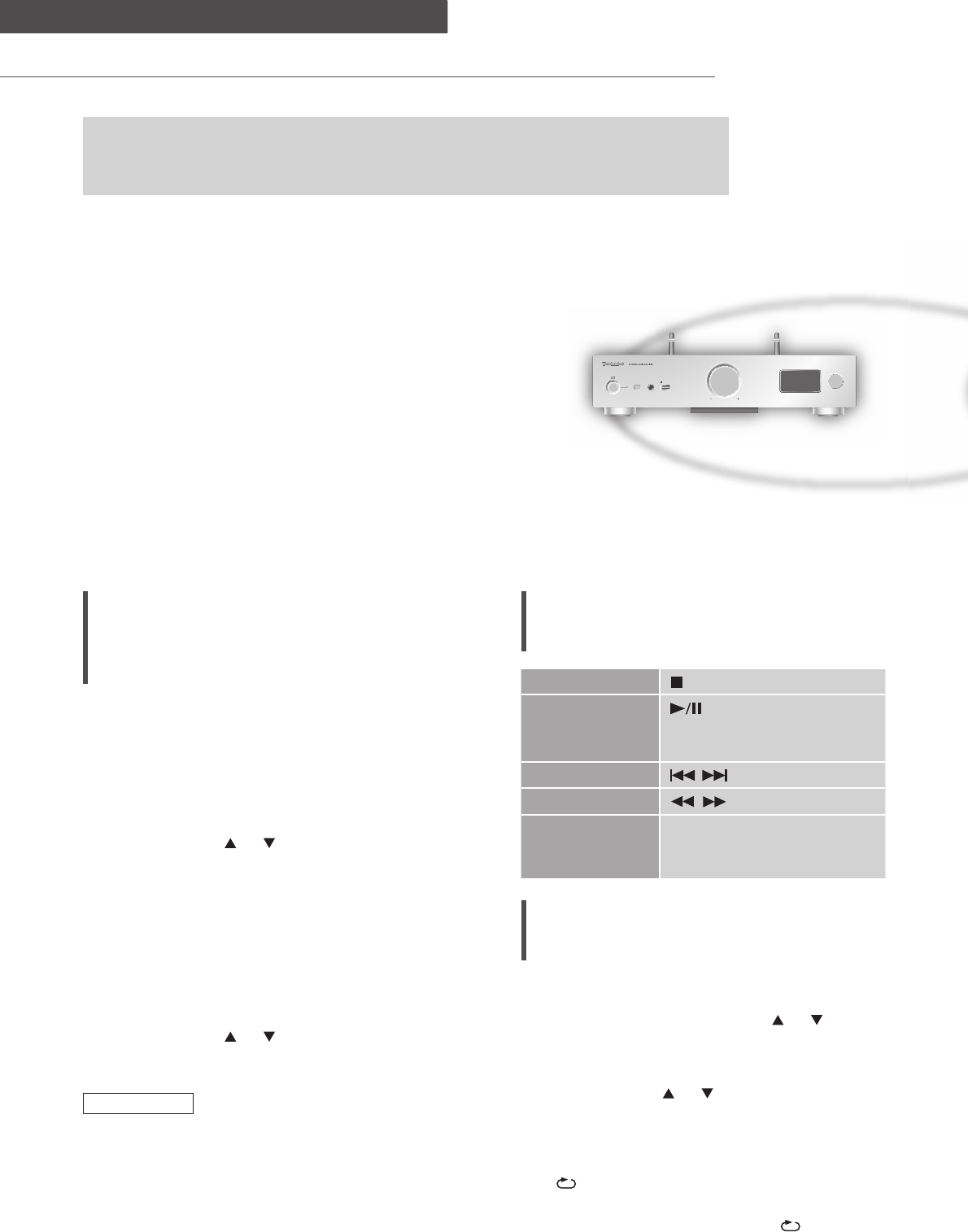
24
Fonctionnement
Lecture de fichiers de musique sur le serveur DLNA
5V 2.1APHONES
VOLUME
INPUT SELECTOR
(70)
Vous pouvez partager les fichiers musicaux stockés sur le serveur de média certifié
DLNA (ordinateur, stockage connecté en réseau, etc.) connecté à votre réseau
domestique et bénéficier du contenu à l’aide de cette unité.
■ Préparatifs
• Effectuer les réglages réseau. ( 18)
• Connecter le dispositif à utiliser au même
réseau que cet appareil.
• Utilisation du lecteur multimédia Windows
Media® Player
- Ajouter le contenu et le fichier aux
bibliothèques du lecteur Windows
Media® 11 ou 12, ou à celles d’un
téléphone intelligent, etc.
- La liste de lecture du lecteur Windows
Media® ne peut lire que le contenu
stocké dans les bibliothèques.
- Afin d’utiliser le lecteur Windows
Media® pour la diffusion en continu,
vous devrez d’abord le configurer.
Lecture du contenu enregistré sur
le serveur DLNA en le contrôlant
depuis cet appareil
1 Appuyer sur [NET] pour sélectionner
“DMP”.
• L’écran de sélection du serveur s’affichera.
• Vous pouvez aussi sélectionner la source
d’entrée en tournant la molette de sélection
d’entrée sur l’unité.
2 Appuyer sur [ ], [ ] pour sélectionner
un serveur DLNA sur le réseau, puis
appuyer sur [OK].
• L’écran de sélection du fichier/contenu
s’affichera. Répéter cette étape pour
effectuer plus de choix.
• Les fichiers/le contenu peuvent s’afficher
dans un ordre différent de celui du serveur,
en fonction de leurs caractéristiques.
3 Appuyer sur [ ], [ ] pour sélectionner
une rubrique, puis appuyer sur [OK].
Remarque
• Selon l’état, le serveur connecté et son contenu
risquent de ne pas s’afficher correctement. (par
exemple, peu de temps après avoir ajouté le
contenu sur le serveur, etc.)
Veuillez réessayer plus tard. Pour plus de détails,
référez-vous au mode d’emploi du périphérique.
Commandes durant la lecture
Arrêt
Pause
• Appuyer de nouveau pour
poursuivre la lecture.
Saut
Recherche
Afficher les
informations
disponibles [INFO]
Lecture en reprise
“Répéter”
1 Appuyer sur [MENU].
2 Appuyer à répétition sur [ ], [ ] pour
sélectionner “Répéter”, puis appuyer
sur [OK].
3 Appuyer sur [ ], [ ] pour sélectionner
une rubrique, puis appuyer sur [OK].
Piste1 :
Lecture de la piste sélectionnée seulement.
(“1 ” s’affiche.)
Tous :
Toutes les pistes sont répétées. (“ ” s’affiche.)
•
Le paramétrage est disponible même lorsque la
source d’entrée est commutée sur “USB” ( 28).
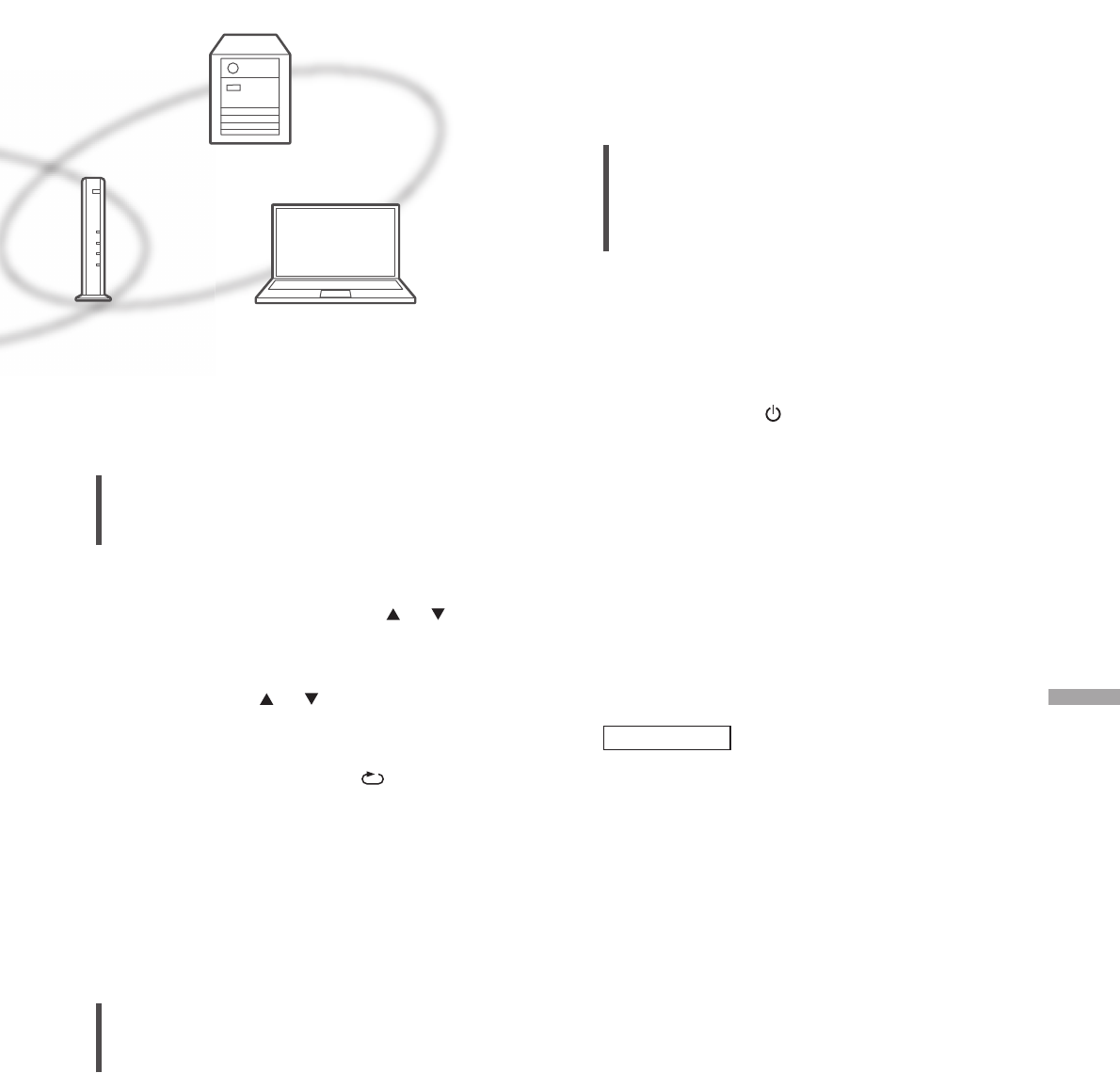
25
Français
Fonctionnement
(71)
Lecture du contenu enregistré sur
le serveur DLNA en le contrôlant
depuis un DMC
En contrôlant un dispositif compatible avec DMC
(Contrôleur de média numérique), vous pouvez
lire de la musique enregistrée sur le serveur
DLNA de cet appareil (DMR-Moteur de rendu
multimédia numérique).
1 Appuyer sur [ ] pour mettre cette
unité en marche.
2 Utiliser le périphérique compatible
avec DMC et se connecter à cet
appareil.
• Le nom de dispositif de cet appareil
s’affichera en tant que “Technics SU-G30
******”*1, 2.
• Pour en savoir plus sur l’utilisation des
périphériques compatibles avec DMC,
se reporter au manuel d’utilisation des
périphériques ou des logiciels concernés.
Remarque
• Vous ne pouvez pas utiliser la lecture en reprise
aléatoire en combinaison avec d’autres modes
de lecture.
• Lorsque vous contrôlez DMC, la lecture d’autres
sources audio s’arrêtera et la lecture de DLNA
aura la priorité.
• Selon le contenu et l’équipement connecté, il
est possible que les opérations ou la lecture
soient impossibles à effectuer.
• Cette unité ne garantit pas la connexion
avec toutes les applications DMC. Utilisez
l’application dédiée “Technics Music App”.
* 1 : “******” représente un chiffre unique à
chaque appareil.
* 2 : Le nom du périphérique peut être modifié à
partir de “Nom de cette unité sur le réseau”.
( 23)
Lecture en reprise aléatoire
“Aléatoire”
1 Appuyer sur [MENU].
2 Appuyer à répétition sur [ ], [ ] pour
sélectionner “Aléatoire”, puis appuyer
sur [OK].
3 Appuyer sur [ ], [ ] pour sélectionner
“Activé”, puis appuyer sur [OK].
• Toutes les pistes du dossier sont répétées de
façon aléatoire. (“ALÉAT.” et “ ” sont affichés
à l’écran).
• Lors de la lecture aléatoire, vous ne pouvez pas
passer directement à la piste précédente.
• Lors de la lecture aléatoire, certaines pistes
peuvent être lues plusieurs fois.
• Le paramétrage est disponible même lorsque la
source d’entrée est commutée sur “USB”
( 28).
Contrôle à l’aide de l’appli dédiée
“Technics Music App”
Si vous installez l’appli dédiée “Technics Music
App” sur votre tablette/téléphone intelligent,
vous pouvez contrôler cet appareil et le SU-G30 à
l’aide d’un grand nombre de fonctions.
Pour plus de détails, consulter :
www.technics.com/support/
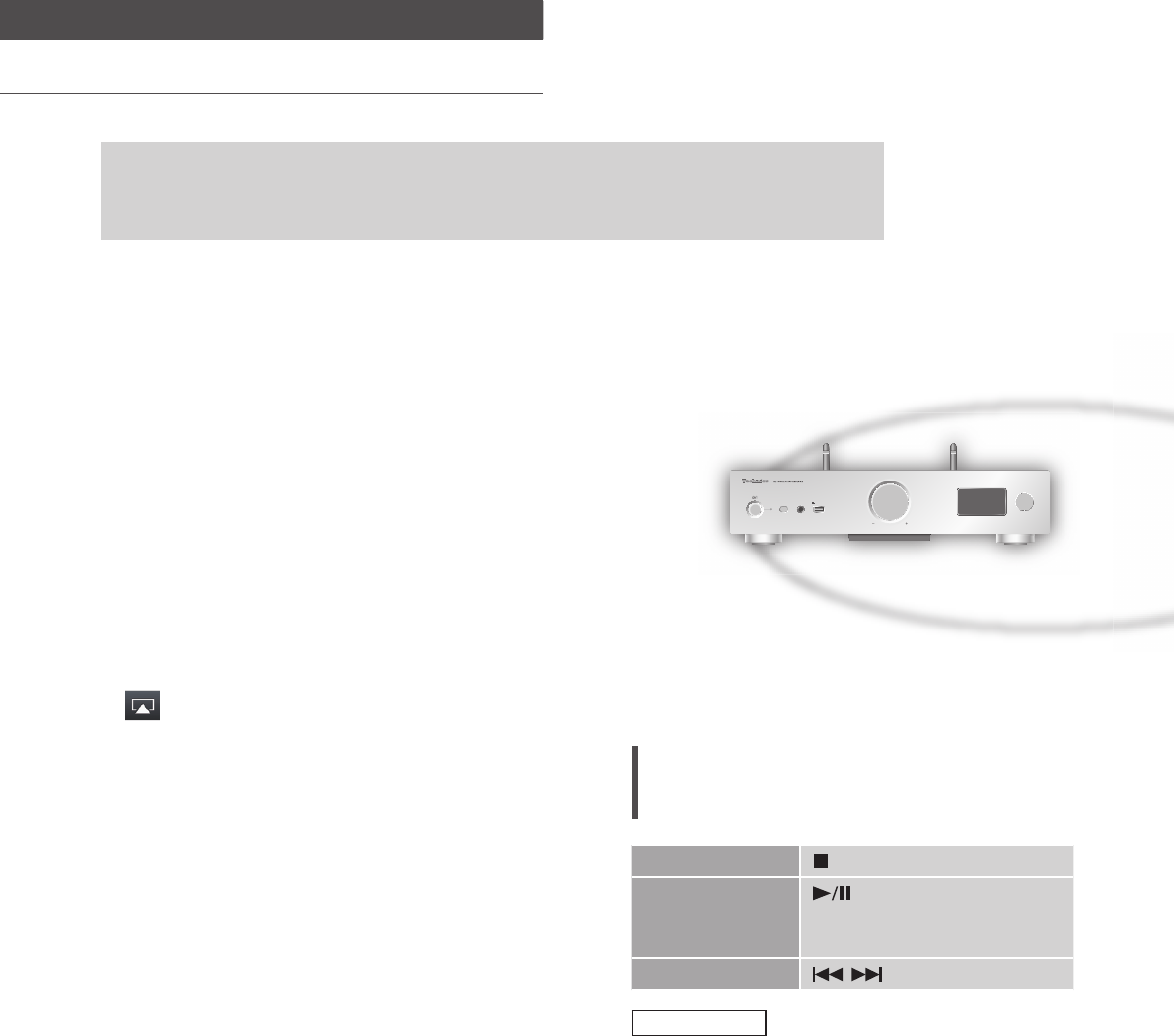
26
Fonctionnement
Utilisation de AirPlay
5V 2.1APHONES
VOLUME
INPUT SELECTOR
Vous pouvez lire de la musique stockée sur un appareil iOS, etc. avec AirPlay.
• AirPlay fonctionne avec iPhone, iPad et iPod touch, version iOS 4.3.3 ou plus, Mac
avec OS X Mountain Lion ou plus et PC avec iTunes 10.2.2 ou plus.
■ Préparatifs
• Effectuer les réglages réseau. ( 18)
• Connecter le dispositif iOS ou PC au
même réseau que cet appareil.
1 (Périphérique iOS)
Démarrer l’application “Music” (ou
iPod).
(PC)
Démarrer “iTunes”.
2 Sélectionner “Technics SU-G30
******”*1, 2 à partir de l’icône AirPlay
.
3 Lancer la lecture.
• Vérifier le réglage du volume avant de lancer
l’écoute.
• Si la fonction AirPlay est utilisée pour la
première fois, il est possible que le volume soit
au niveau maximum.
• L’écoute s’amorce avec un léger retard.
* 1 : “******” représente un chiffre unique à
chaque appareil.
* 2 : Le nom du périphérique peut être modifié à
“Nom de cette unité sur le réseau”. ( 23)
Commandes durant la lecture
Arrêt
Pause
• Appuyer de nouveau pour
poursuivre la lecture.
Saut
Remarque
• La lecture des autres sources audio est
interrompue et le signal de la fonction AirPlay a
la préséance.
• Le volume est changé sur le périphérique iOS
ou iTunes et est appliqué à cette unité. (Référez-
vous à l’aide de iTunes pour connaître les
paramètres nécessaires dans iTunes).
• Avec certaines versions de iOS et de iTunes, il
se peut qu’il ne soit pas possible de redémarrer
la lecture AirPlay si le sélecteur est changé ou
si l’unité est mise en veille pendant la lecture
AirPlay. Dans ce cas, choisissez un périphérique
différent depuis l’icône AirPlay de l’application
Music ou iTunes puis sélectionnez à nouveau
cette unité en tant qu’enceintes de sortie.
• La fonction AirPlay n’a aucun effet lors de la
lecture de vidéos sur iTunes.
(72)
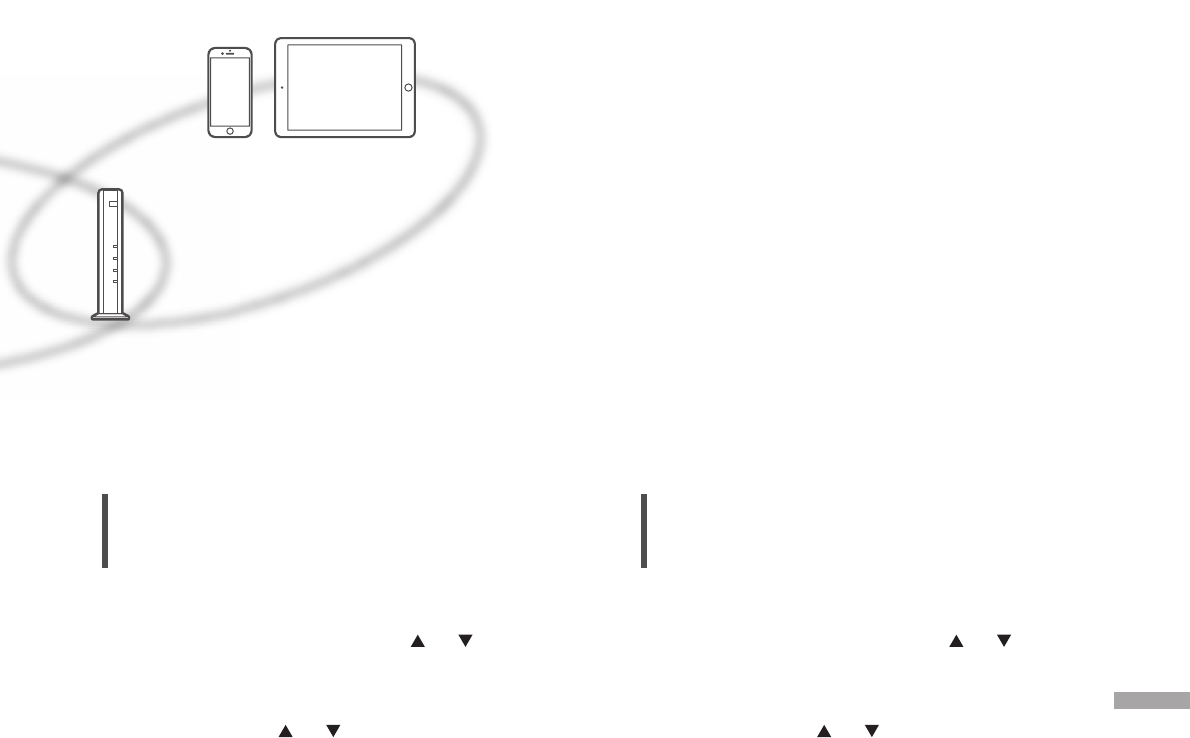
27
Français
Fonctionnement
Lecture en reprise
“Répéter”
1 Appuyer sur [MENU].
2 Appuyer à répétition sur [ ], [ ] pour
sélectionner “Répéter”, puis appuyer
sur [OK].
3 Appuyez sur [ ], [ ] pour configurer
et appuyez sur [OK].
• Référez-vous à l’appareil connecté pour vérifier
le paramètre sélectionné.
• Vous pouvez aussi configurer sur l’appareil iOS/
le PC connecté.
Lecture en reprise aléatoire
“Aléatoire”
1 Appuyer sur [MENU].
2 Appuyer à répétition sur [ ], [ ] pour
sélectionner “Aléatoire”, puis appuyer
sur [OK].
3 Appuyez sur [ ], [ ] pour configurer
et appuyez sur [OK].
• Référez-vous à l’appareil connecté pour vérifier
le paramètre sélectionné.
• Vous pouvez aussi configurer sur l’appareil iOS/
le PC connecté.
(73)
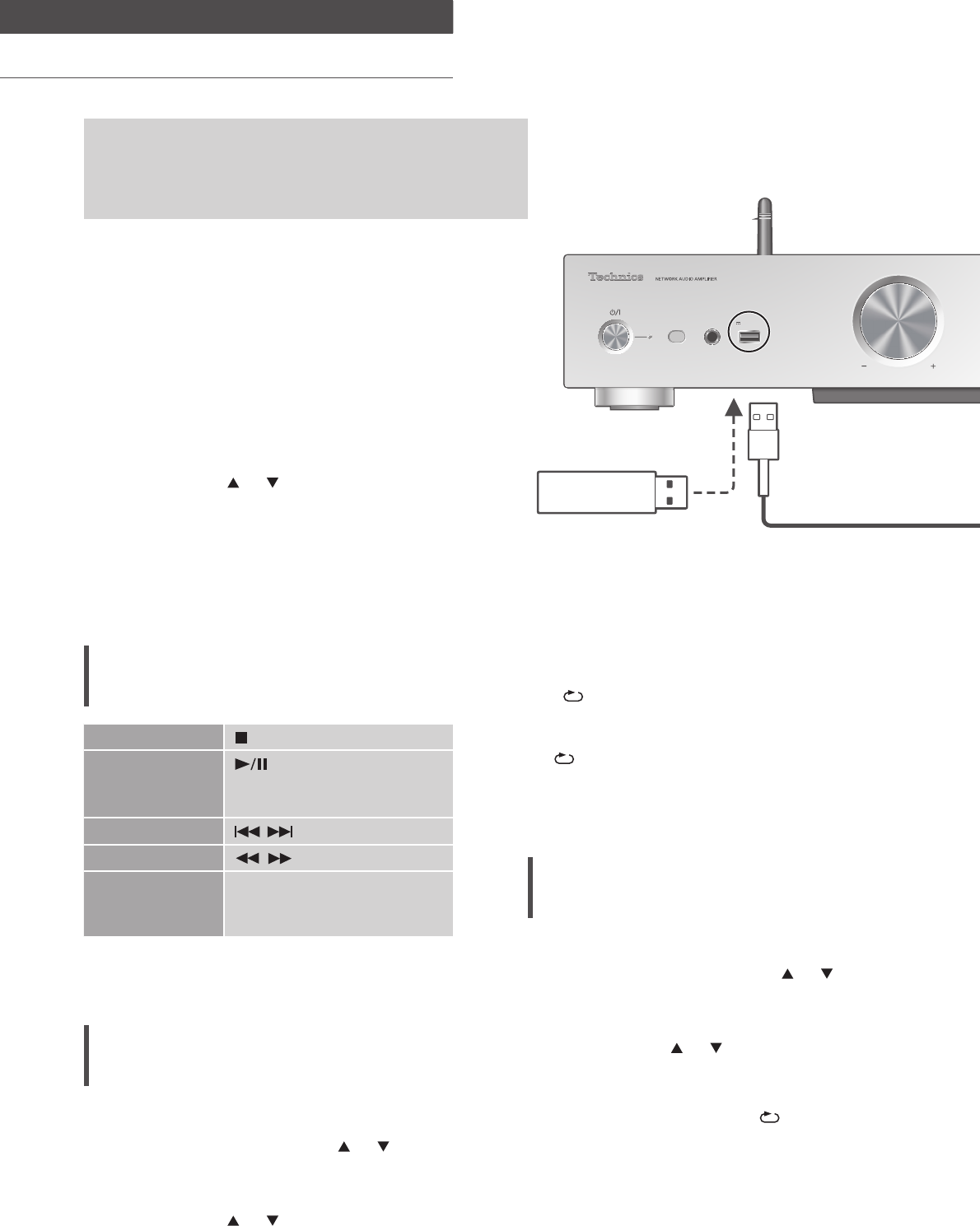
28
Fonctionnement
Avec un dispositif USB
5V 2.1APHONES
VOLUME
(74)
1 Brancher un dispositif USB à l’appareil.
2 Appuyez sur [DIGITAL] plusieurs fois
pour sélectionner “USB”.
•
L’écran de sélection du fichier/contenu s’affichera.
• Vous pouvez aussi sélectionner la source
d’entrée en tournant la molette de sélection
d’entrée sur l’unité.
3 Appuyer sur [ ], [ ] pour sélectionner
une rubrique, puis appuyer sur [OK].
• Répéter cette étape pour effectuer plus de
choix.
• Appuyer sur [RETURN] pour revenir au
dossier précédent.
Commandes durant la lecture
Arrêt
Pause
• Appuyer de nouveau pour
poursuivre la lecture.
Saut
Recherche
Afficher les
informations
disponibles [INFO]
• Il est possible que cette opération ne soit pas
disponible pour certains formats.
Lecture en reprise
“Répéter”
1 Appuyer sur [MENU].
2 Appuyer à répétition sur [ ], [ ] pour
sélectionner “Répéter”, puis appuyer
sur [OK].
3 Appuyer sur [ ], [ ] pour sélectionner
une rubrique, puis appuyer sur [OK].
Piste1 :
Lecture de la piste sélectionnée seulement.
(“1 ” s’affiche.)
Tous :
Toutes les pistes du dossier sont répétées.
(“ ” s’affiche.)
• Le paramétrage est disponible même lorsque la
source d’entrée est commutée sur “DMP”
( 24).
Lecture en reprise aléatoire
“Aléatoire”
1 Appuyer sur [MENU].
2 Appuyer à répétition sur [ ], [ ] pour
sélectionner “Aléatoire”, puis appuyer
sur [OK].
3 Appuyer sur [ ], [ ] pour sélectionner
“Activé”, puis appuyer sur [OK].
• Toutes les pistes du dossier sont répétées de
façon aléatoire. (“ALÉAT.” et “ ” sont affichés
à l’écran).
• Lors de la lecture aléatoire, vous ne pouvez pas
passer directement à la piste précédente.
• Lors de la lecture aléatoire, certaines pistes
peuvent être lues plusieurs fois.
• Le paramétrage est disponible même lorsque la
source d’entrée est commutée sur “DMP”
( 24).
Connectez un périphérique USB à l’unité et vous
pouvez lire la musique stockée sur le périphérique USB.
• Consulter “USB” ( 45) pour avoir des informations
sur les disques que cet appareil peut lire.
L’appareil USB
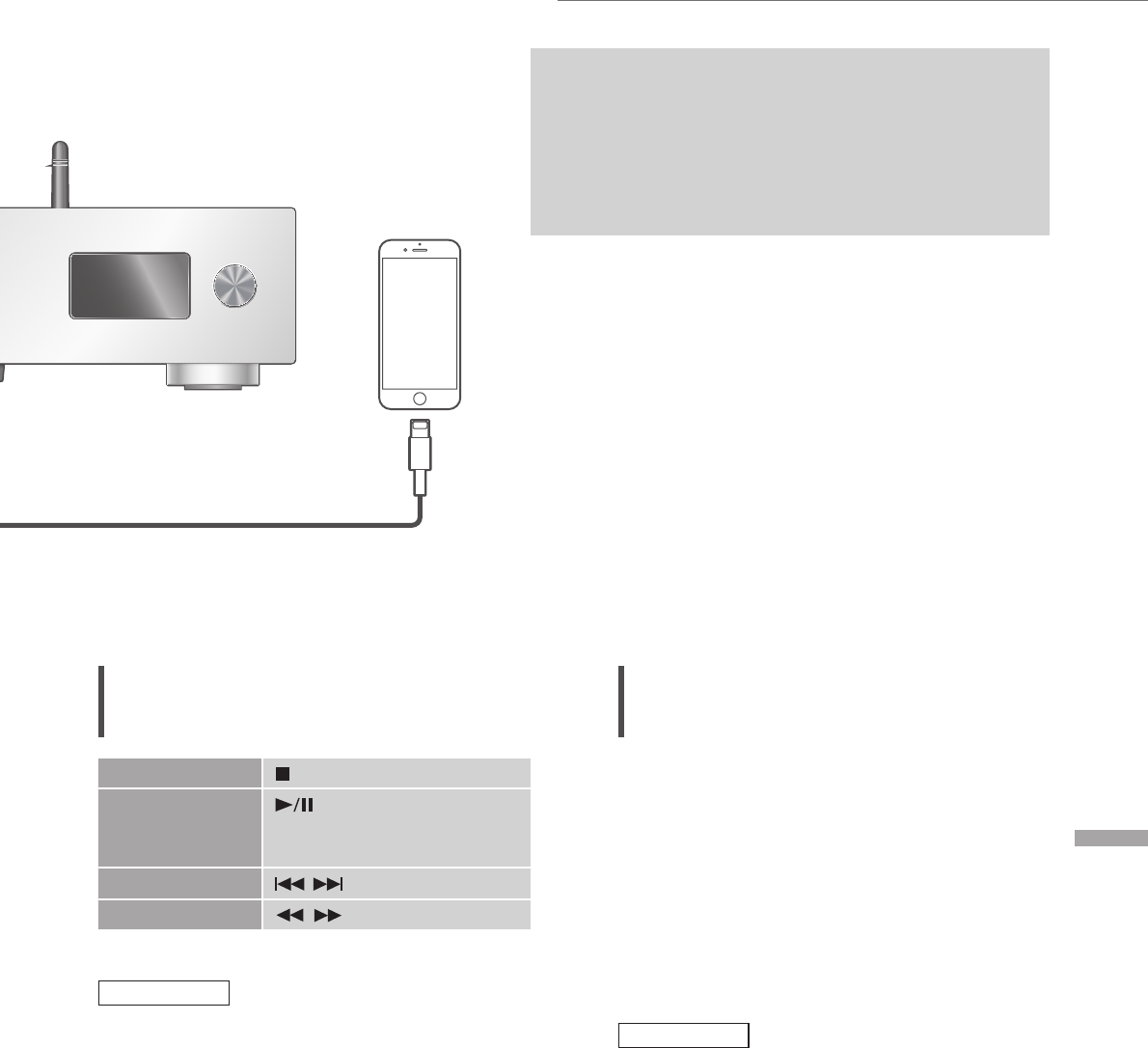
29
Français
Utilisation de l’iPhone/iPad/iPod
Fonctionnement
INPUT SELECTOR
(75)
1 Raccordez un iPhone/iPad/iPod à
l’unité.
2 Appuyez sur [DIGITAL] plusieurs fois
pour sélectionner “USB”.
• L’affichage passe automatiquement sur
“iPod_Port” lorsqu’un iPhone/iPad/iPod
compatible est connecté à la borne USB-A.
• Vous pouvez aussi sélectionner la source
d’entrée en tournant la molette de sélection
d’entrée sur l’unité.
3 Lancez la lecture sur l’iPhone/iPad/
iPod.
Commandes durant la lecture
Arrêt
Pause
• Appuyer de nouveau pour
poursuivre la lecture.
Saut
Recherche
• Pour “Répéter” et “Aléatoire”. ( 27)
Remarque
• La compatibilité dépend de la version du
logiciel. Installez le tout dernier logiciel sur votre
iPhone/iPad/iPod avant de l’utiliser avec cette
unité.
• Les résultats de cet action peuvent varier en
fonction des modèles iPhone/iPad/iPod ou de
la version de l’iOS.
Chargement d’un iPhone/iPad/iPod
Lorsque l’appareil est en marche, le chargement
commence lorsqu’un iPhone/iPad/iPod est
branché à cet appareil.
• Pour poursuivre la charge depuis une connexion
par câble USB en mode veille, assurez-vous que
l’iPhone/iPad/iPod a démarré la charge avant
que l’unité ne soit mise en veille.
• Vérifiez sur l’iPhone/iPad/iPod que la batterie
est entièrement rechargée. Une fois qu’il est
entièrement rechargé, retirez l’iPhone/iPad/
iPod.
Remarque
• Lorsque cette unité est en veille, “Charge iPod”
est affiché à l’écran et le voyant d’alimentation
est allumé en rouge.
• Le chargement s’arrête lorsque la batterie est
entièrement rechargée. La batterie s’épuisera
naturellement.
• Lors du chargement d’un iPhone/iPad/iPod
dont la batterie est épuisée, ne mettez pas cet
appareil en mode veille tant que l’iPhone/iPad/
iPod ne fonctionne pas à nouveau.
Branchez un iPhone/iPad/iPod à l’unité avec le câble
USB* et vous pouvez écouter la musique stockée sur
l’iPhone/iPad/iPod ou charger l’iPhone/iPad/iPod.
• Consultez “iPhone/iPad/iPod” ( 45) pour avoir des
informations sur les appareils iOS que cette unité peut
lire.
* : Utilisez le câble USB fourni avec l’iPhone/iPad/iPod.
Câble USB
(fourni avec l’iPhone/iPad/iPod)
iPhone/iPad/iPod
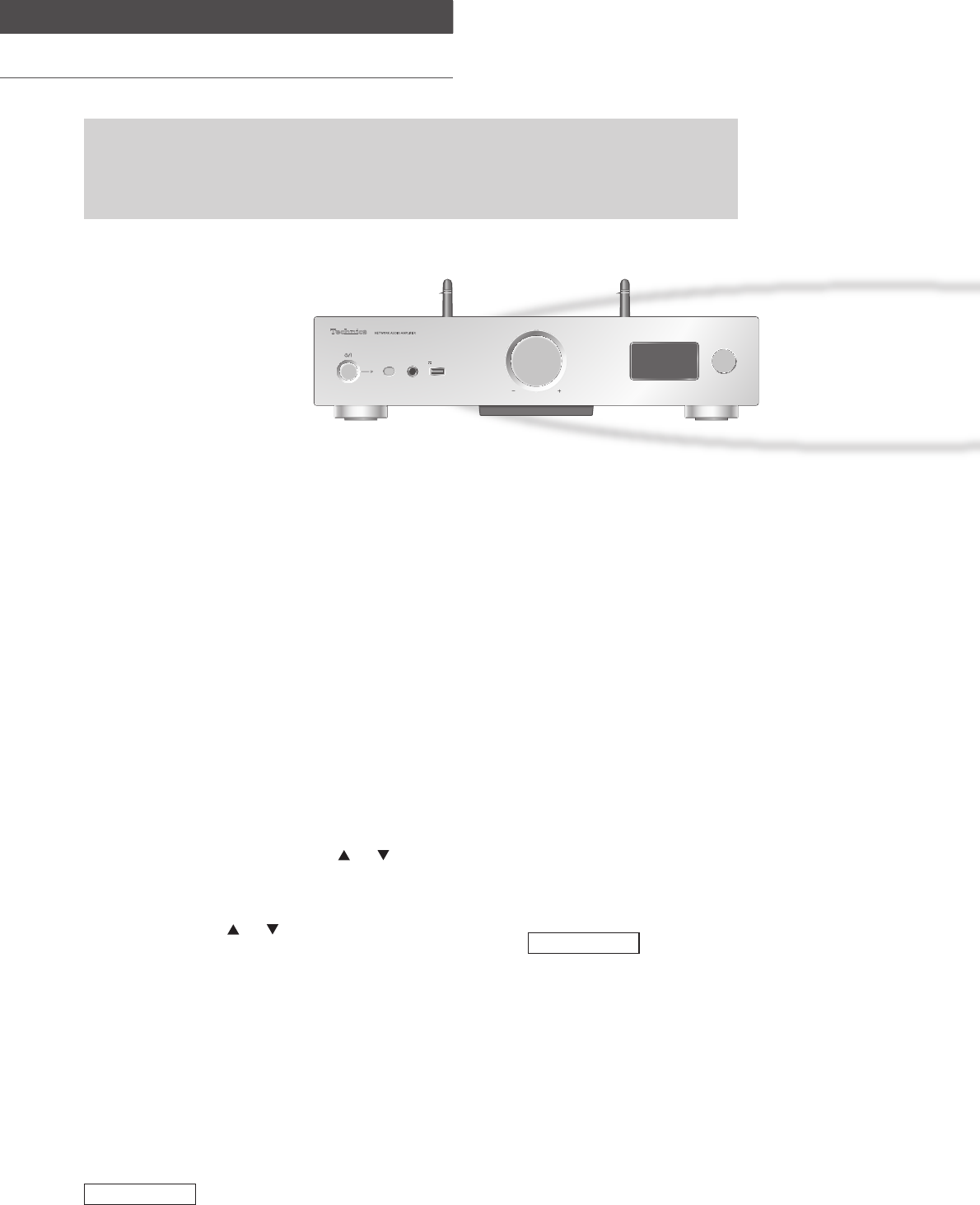
30
Fonctionnement
Utilisation de Bluetooth®
5V 2.1APHONES
VOLUME
INPUT SELECTOR
(76)
Vous pouvez écouter le son provenant du dispositif audio Bluetooth® depuis cet
appareil, et ce sans fil.
• Se reporter au manuel d’utilisation du dispositif Bluetooth® pour de plus amples
instructions sur comment connecter un tel dispositif.
■ Appairage d’un périphérique Bluetooth®
• Activer la fonction Bluetooth® sur le dispositif et
le placer à proximité de l’appareil.
• Si un dispositif Bluetooth® est déjà connecté, le
déconnecter. ( 31)
1 Appuyez sur [DIGITAL] plusieurs fois
pour sélectionner “Bluetooth”.
• Vous pouvez aussi sélectionner la source
d’entrée en tournant la molette de sélection
d’entrée sur l’unité.
2 Appuyer sur [MENU].
3 Appuyer à répétition sur [ ], [ ] pour
sélectionner “Pairage”, puis appuyer
sur [OK].
4 Appuyer sur [ ], [ ] pour sélectionner
“Oui”, puis appuyer sur [OK].
• “Pairage” s’affiche à l’écran et l’unité attend
l’enregistrement.
5 Sélectionner “SU-G30” à partir du
menu de l’appareil Bluetooth®.
• Le nom de l’appareil connecté s’affiche à
l’écran.
• L’adresse MAC s’affiche avant que
“SU-G30” n’apparaisse. (par exemple,
6C:5A:B5:B3:1D:0F)
Remarque
• Sur demande du mot de passe, entrer “0000”.
•
Il est possible d’enregistrer jusqu’à 8 dispositifs auprès de
cet appareil. Si un 9e dispositif est couplé, il remplacera le
dispositif n’ayant pas été utilisé depuis le plus longtemps.
■ Écoute de la musique stockée sur un
périphérique Bluetooth®
1 Appuyez sur [DIGITAL] plusieurs fois
pour sélectionner “Bluetooth”.
• “Prêt” apparaît sur l’afficheur.
• Vous pouvez aussi sélectionner la source
d’entrée en tournant la molette de sélection
d’entrée sur l’unité.
2 Sélectionner “SU-G30” à partir du
menu de l’appareil Bluetooth®.
• Le nom de l’appareil connecté s’affiche à
l’écran.
3 Commencer la lecture sur le dispositif
Bluetooth®.
Remarque
• Cet appareil ne peut être connecté qu’à un
dispositif à la fois.
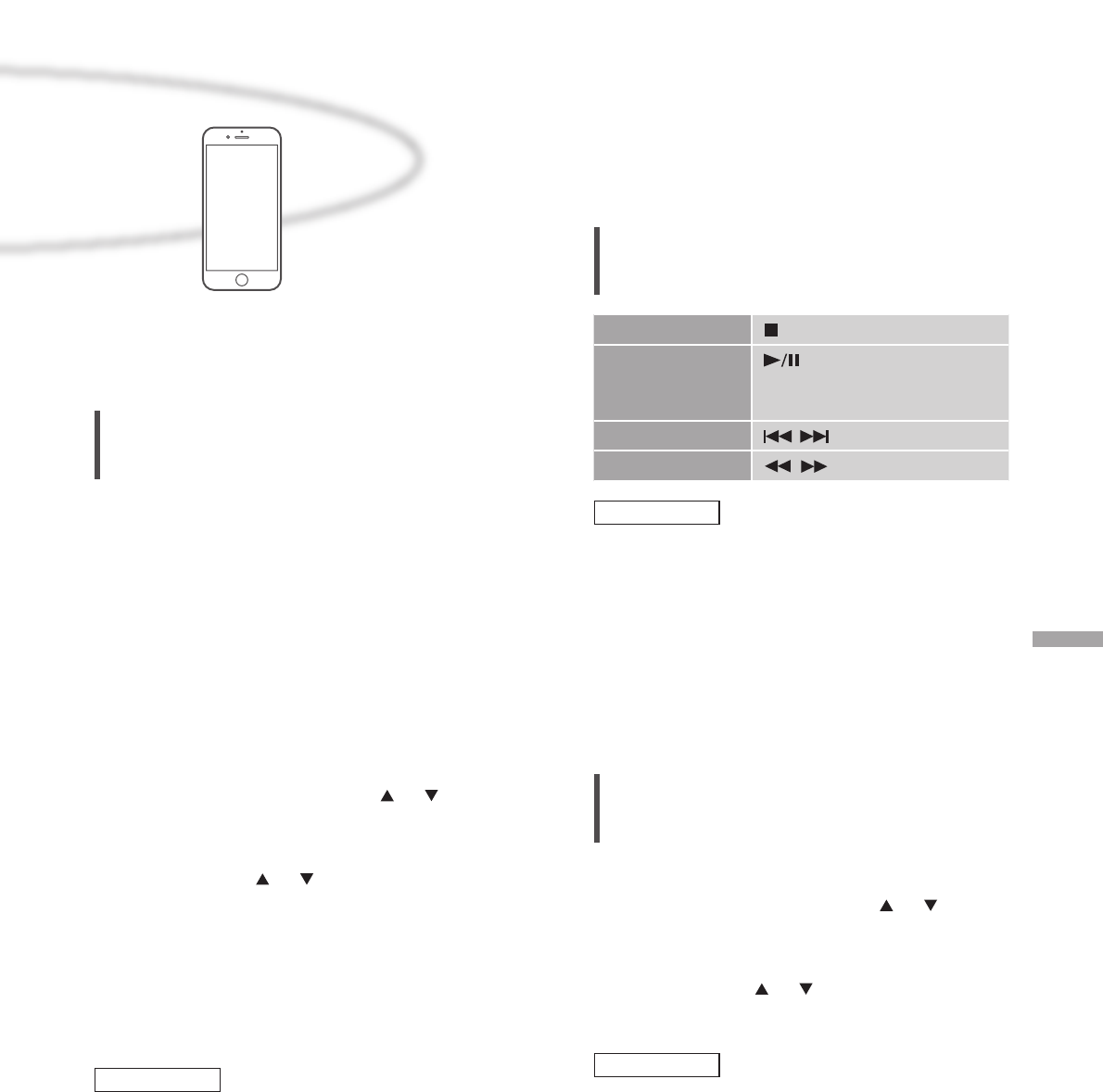
31
Français
Fonctionnement
Commandes durant la lecture
Arrêt
Pause
• Appuyer de nouveau pour
poursuivre la lecture.
Saut
Recherche
Remarque
• Pour utiliser la télécommande de cette unité
avec un périphérique Bluetooth®, il faut que le
périphérique Bluetooth® soit compatible avec
AVRCP (Audio Video Remote Control Profile/
Profil de Commande Audio Vidéo à Distance).
En fonction de l’état du périphérique, il se peut
que certaines commandes ne fonctionnent pas.
• Lorsque vous regardez un contenu vidéo avec
cette fonction, il se peut que la sortie audio de
la vidéo ne soit pas synchronisée.
Déconnexion d’un dispositif
Bluetooth®
1 Appuyer sur [MENU].
2 Appuyer à répétition sur [ ], [ ]
pour sélectionner “Déconnect.?”, puis
appuyer sur [OK].
3 Appuyer sur [ ], [ ] pour sélectionner
“Oui”, puis appuyer sur [OK].
Remarque
• Si une source audio différente est sélectionnée,
le dispositif Bluetooth® se déconnecte.
Mode de transmission Bluetooth®
Vous pouvez changer le mode de transmission
afin de donner la priorité à la qualité de
transmission ou à la qualité sonore.
1 Appuyez sur [DIGITAL] plusieurs fois
pour sélectionner “Bluetooth”.
• Vous pouvez aussi sélectionner la source
d’entrée en tournant la molette de sélection
d’entrée sur l’unité.
• Si un dispositif Bluetooth® est déjà connecté,
le déconnecter.
2 Appuyer sur [MENU].
3 Appuyer à répétition sur [ ], [ ]
pour sélectionner “Mode lien”, puis
appuyer sur [OK].
4 Appuyer sur [ ], [ ] pour sélectionner
le mode, puis appuyer sur [OK].
Mode1 :
Accent sur la connectivité
Mode2 :
Accent sur la qualité audio (paramètre par
défaut)
Remarque
• Sélectionner “Mode1” si le son s’arrête.
(77)
Appareil Bluetooth®
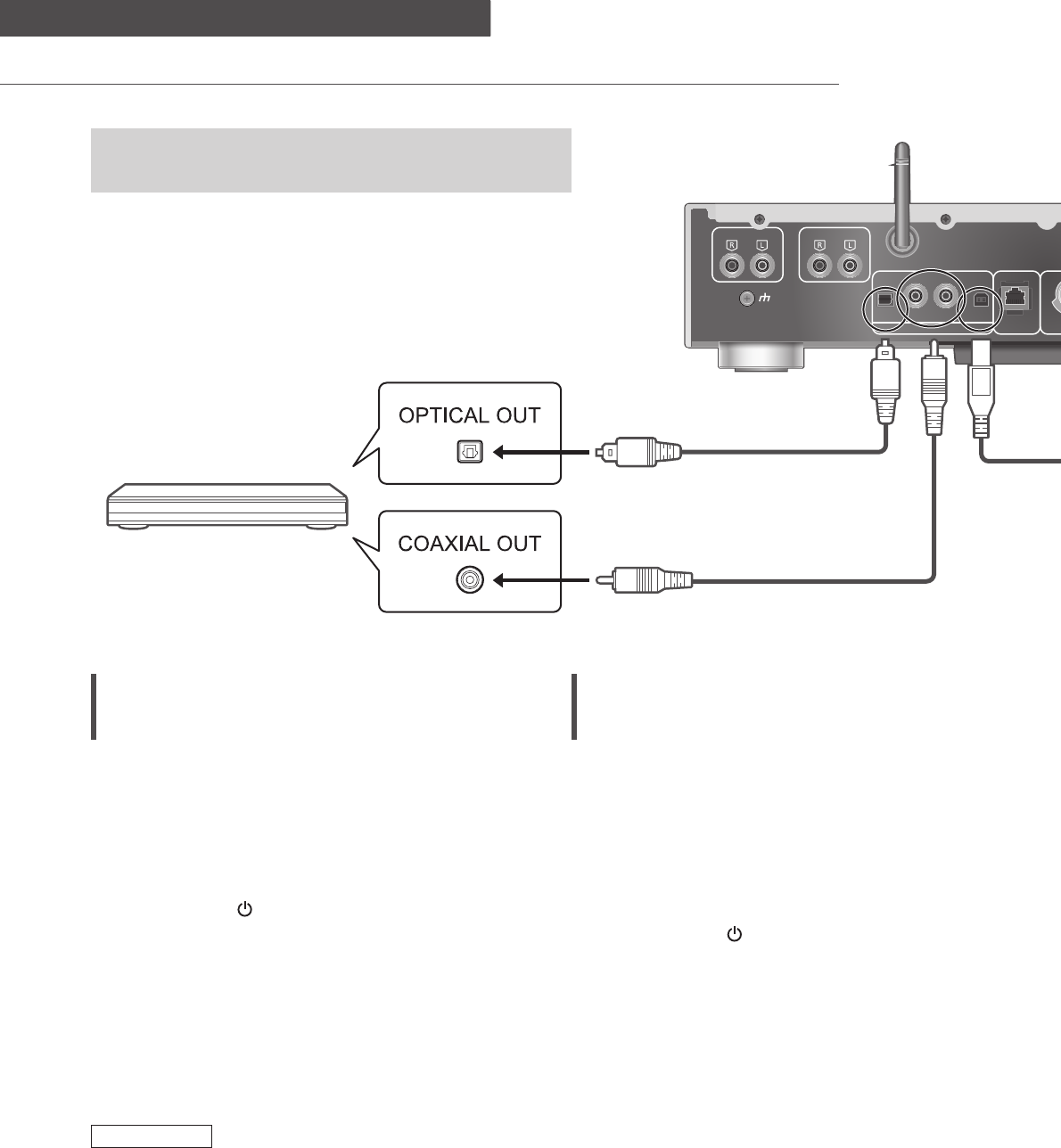
32
Fonctionnement
Utilisation d’un périphérique de sortie audio numérique
LAN
DIGITAL IN
10BASE-T /
100BASE-TX
OPT COAX1 COAX2 PC
PHONO
PHONO
EARTH
LINE IN
(78)
Vous pouvez envoyer des signaux audio numériques à
cet appareil et lire de la musique.
Câble audio numérique optique
(non fourni)
Lecteur CD, etc.
Câble numérique coaxial
(non fourni)
Utilisation d’un câble audio
numérique optique
1 Débranchez le cordon d’alimentation
secteur.
2
Raccordez cette unité et un lecteur CD, etc.
3 Branchez le cordon d’alimentation
secteur de cette unité. ( 17)
4
Appuyez sur [ ] pour mettre cette unité
en marche.
5
Appuyez sur [DIGITAL] plusieurs fois
pour sélectionner “COAX1” ou “COAX2”.
• Vous pouvez aussi sélectionner la source
d’entrée en tournant la molette de sélection
d’entrée sur l’unité.
6
Démarrez la lecture sur l’appareil connecté.
Remarque
• Les bornes d’entrée audio numérique de cette
unité ne peuvent détecter que les signaux PCM
linéaires. Pour plus de détails, référez-vous au
mode d’emploi du périphérique.
- Fréquence d’échantillonnage :
Entrée numérique coaxiale
32/44,1/48/88,2/96/176,4/192 kHz
Entrée numérique optique
32/44,1/48/88,2/96 kHz
- Nombre de bits de quantification :
16/24 bits
Utilisation d’un câble numérique
coaxial
1 Débranchez le cordon d’alimentation
secteur.
2 Raccordez cette unité et un lecteur CD,
etc.
3 Branchez le cordon d’alimentation
secteur de cette unité. ( 17)
4 Appuyez sur [ ] pour mettre cette
unité en marche.
5 Appuyez sur [DIGITAL] plusieurs fois
pour sélectionner “OPT”.
• Vous pouvez aussi sélectionner la source
d’entrée en tournant la molette de sélection
d’entrée sur l’unité.
6 Démarrez la lecture sur l’appareil
connecté.
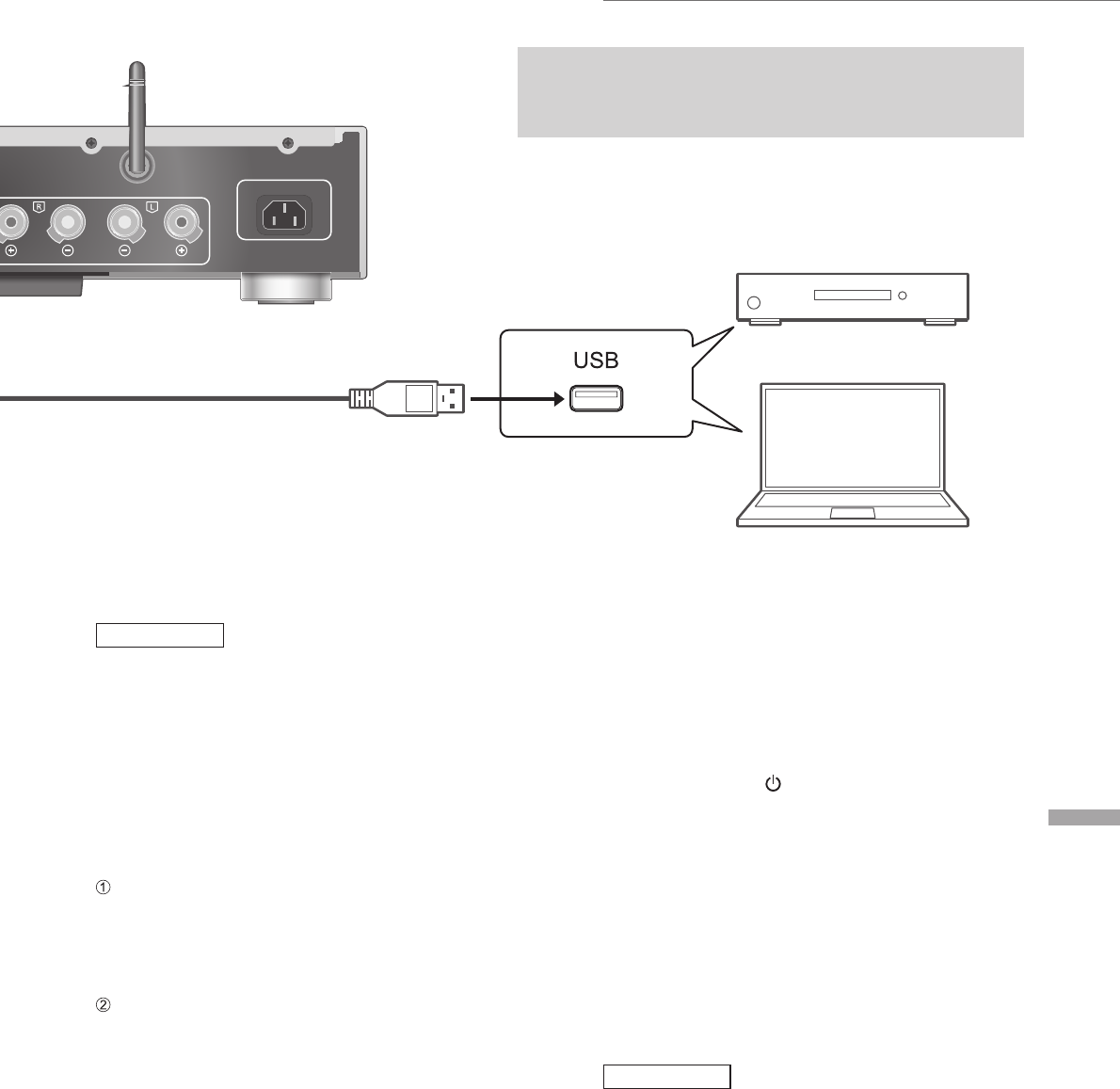
33
Français
Fonctionnement
Avec un PC, etc.
SPEAKERS
(4∼16Ω)
AC IN ∼
Remarque
Branchement à un PC
• Avant de se brancher à un PC, suivre les étapes
ci-dessous.
• Se reporter à ce qui suit concernant les versions
OS recommandées pour votre PC (depuis
décembre 2015) :
- Windows 7, Windows 8, Windows 8.1,
Windows 10
- OS X 10.7, 10.8, 10.9, 10.10, 10.11
Télécharger et installer le pilote dédié sur le
PC. (Seulement pour le SE Windows)
• Télécharger et installer le pilote dédié à partir
du site Internet ci-dessous.
www.technics.com/support/
Télécharger et installer l’appli dédiée “Technics
Audio Player” (sans frais) sur votre PC.
• Télécharger et installer l’appli dédiée à partir
du site Internet ci-dessous.
www.technics.com/support/
1 Débrancher le cordon d’alimentation
secteur.
2 Brancher un PC, etc. à cet appareil.
3 Brancher le cordon d’alimentation
secteur de cette unité. ( 17)
4 Appuyer sur [ ] pour mettre cette
unité en marche.
5 Appuyez sur [DIGITAL] plusieurs fois
pour sélectionner “PC”.
• Vous pouvez aussi sélectionner la source
d’entrée en tournant la molette de sélection
d’entrée sur l’unité.
6 Lancer la lecture en utilisant
l’application dédiée “Technics Audio
Player” sur l’ordinateur connecté.
Remarque
• Pour en savoir plus sur le format pris en charge,
consulter “Format du fichier” ( 49)
(79)
Vous pouvez raccorder la borne USB-B à un PC, etc. à
l’aide d’un câble USB et lire la musique provenant du
PC, etc. avec cette unité.
PC, etc.
Câble USB 2.0
(non fourni)
ST-G30
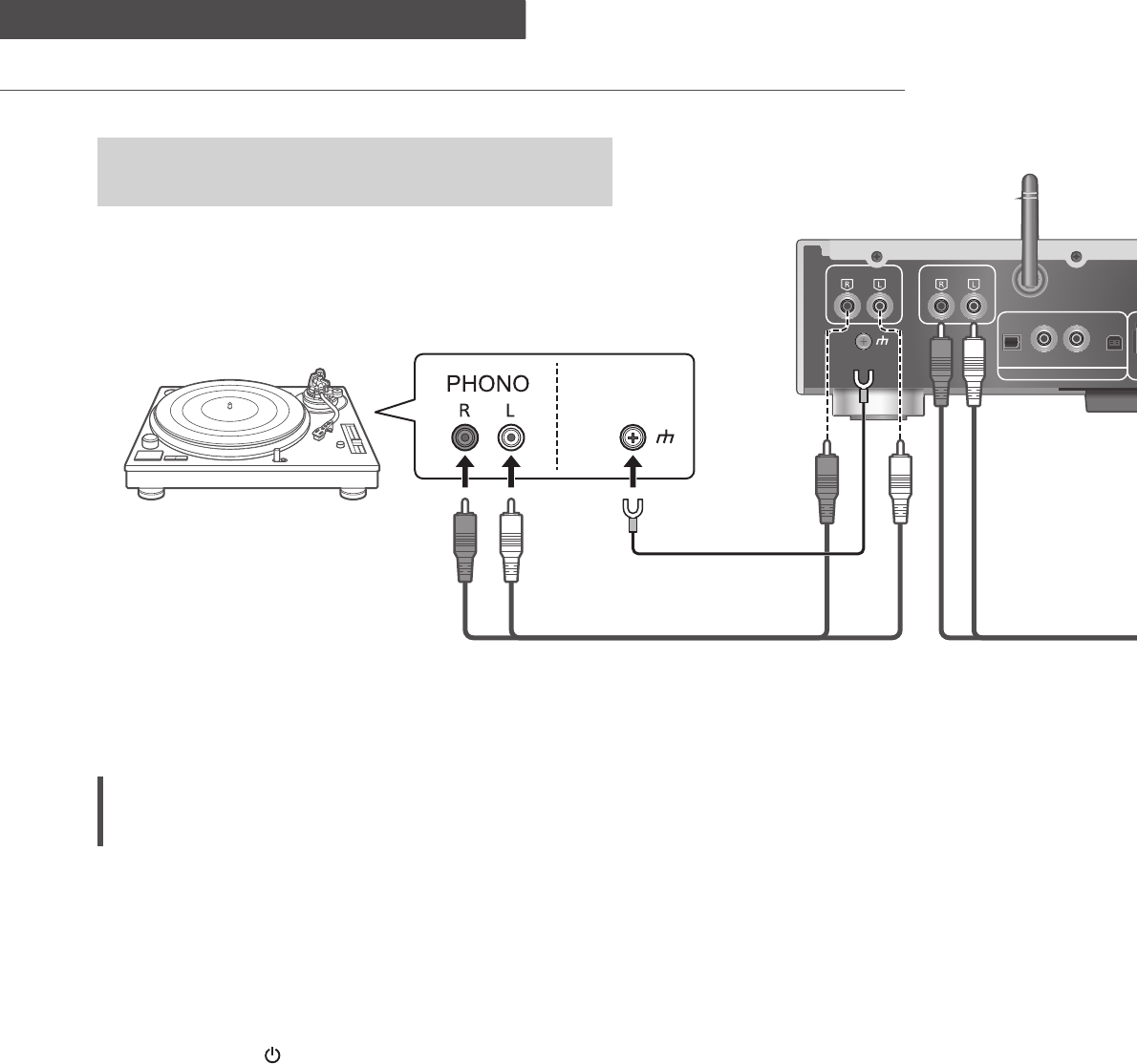
34
Fonctionnement
Utilisation d’un périphérique de sortie audio analogique
DIGITAL IN
1
1
0
OPT COAX1 COAX2 PC
PHONO
PHONO
EARTH
LINE IN
PHONO
EARTH
(80)
Utilisation d’un câble audio
numérique analogique
1 Débranchez le cordon d’alimentation
secteur.
2 Raccordez cette unité et un tourne-
disque, etc.
3 Branchez le cordon d’alimentation
secteur de cette unité. ( 17)
4 Appuyez sur [ ] pour mettre cette
unité en marche.
5 Appuyez sur [ANALOG] plusieurs
fois pour sélectionner “LINE” ou
“PHONO”.
• Vous pouvez aussi sélectionner la source
d’entrée en tournant la molette de sélection
d’entrée sur l’unité.
6 Démarrez la lecture sur l’appareil
connecté.
Vous pouvez envoyer des signaux audio analogiques à
cette unité et écouter de la musique.
Câble audio (non fourni)
Fil de terre*2
Par exemple,
Tourne-disque*1
* 1 : Lors de la connexion à un tourne-disque avec
un égaliseur PHONO intégré, raccordez son
câble aux bornes d’entrée audio analogique
(LINE IN).
* 2 : Lors de la connexion d’un tourne-disque avec
un fil de terre, raccordez le fil de terre à la
borne PHONO EARTH de cette unité.
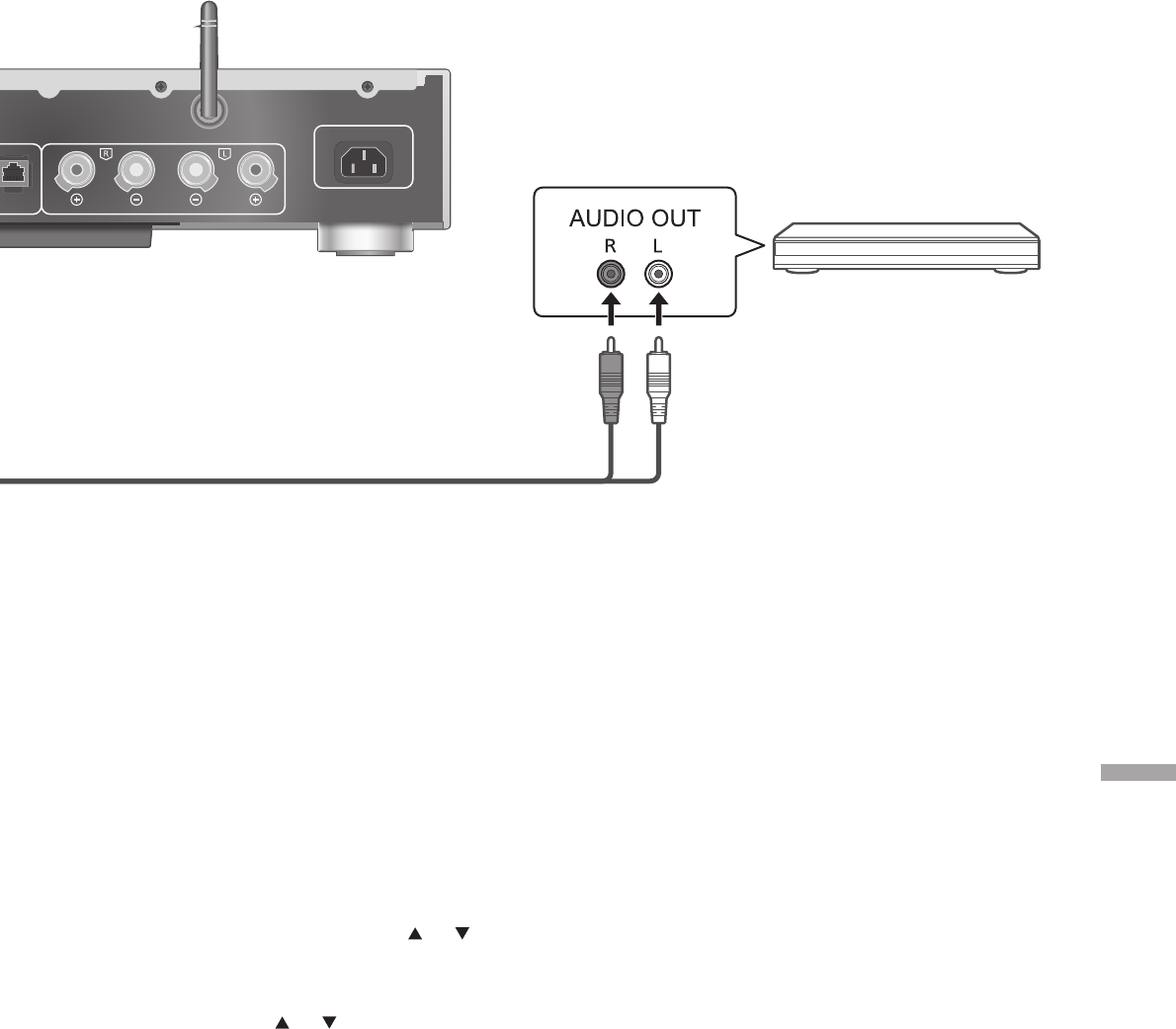
35
Français
Fonctionnement
LAN
0BASE-T /
0
0BASE-TX
SPEAKERS
(4∼16Ω)
AC IN ∼
(81)
Câble audio (non fourni)
Lecteur de disque Blu-ray, etc.
■ Minimiser la distorsion audio
Si une distorsion audio se produit lors de
l’utilisation des bornes d’entrée audio analogique
(LINE IN), régler l’atténuateur sur “Activé” peut
apporter une amélioration.
• Le mode d’usine par défaut est “Désactivé”.
1 Appuyez sur [SETUP].
2 Appuyez à répétition sur [ ], [ ] pour
sélectionner “Attenuator(LINE)” puis
appuyez sur [OK].
3 Appuyez sur [ ], [ ] pour sélectionner
“Activé”, puis appuyez sur [OK].
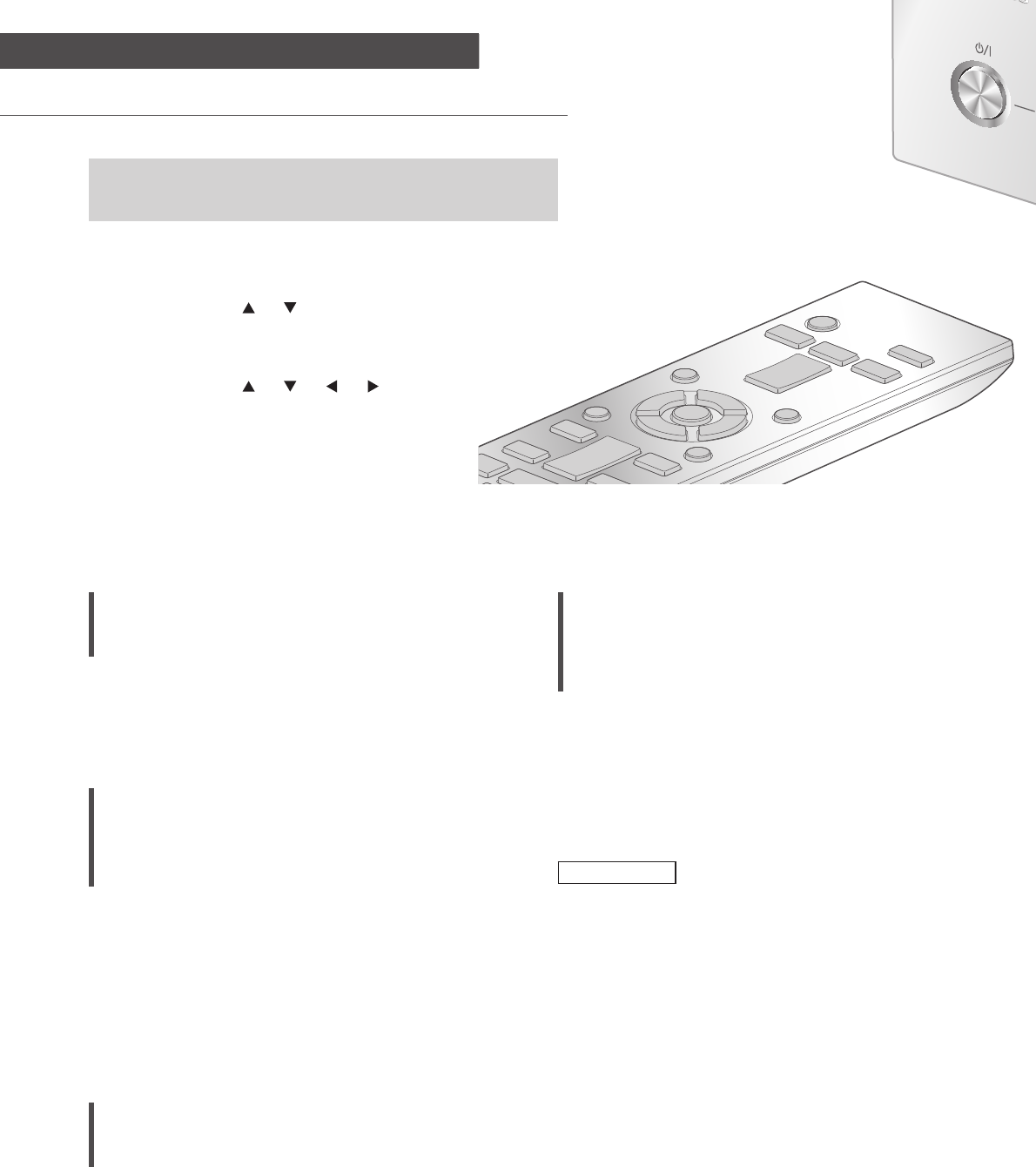
36
Paramètres
Réglage du son, autres paramètres
1 Appuyez sur [SETUP].
2 Appuyez sur [ ], [ ] de façon
répétée pour choisir le menu
puis appuyez sur [OK].
3 Appuyez sur [ ], [ ], [ ], [ ]
pour configurer et appuyez sur
[OK].
Réglage de la langue
“Langue”
Sélectionner “English” ou “Français” pour
l’affichage.
• Par défaut, cette fonction est réglée sur
“English”.
Réglage des graves/des médiums/
des aigus
“Com. tonalité”
Vous pouvez régler la tonalité de cette unité.
Chaque plage de tonalité (Graves/Médiums/
Aigus) peut être réglée.
• Pour activer cette fonction, choisissez
“Activé(réglage)”.
• Chaque niveau peut être réglé entre “- 10” et
“+ 10”.
• “TON.” est affiché après les réglages.
Minuterie-sommeil
“SOMMEIL”
La minuterie de sommeil peut mettre l’unité en
veille après un délai défini. (30 minutes/
60 minutes/90 minutes/120 minutes/Désactivé)
Fonction de mise hors marche
automatique
“H/M AUTO”
Cet appareil est conçu pour minimiser sa
consommation en électricité et ainsi économiser
de l’énergie. Lorsque l’appareil n’est pas utilisé
pendant environ 20 minutes, il passera en mode
veille après une minute. Appuyez sur une touche
pour annuler.
• Le mode d’usine par défaut est “Désactivé”.
Remarque
• La fonction d’arrêt automatique marche sauf si
vous la désactivez, même si vous mettez cette
unité en veille puis en marche.
Les effets sonores et les autres paramètres peuvent
être réglés.
(82)
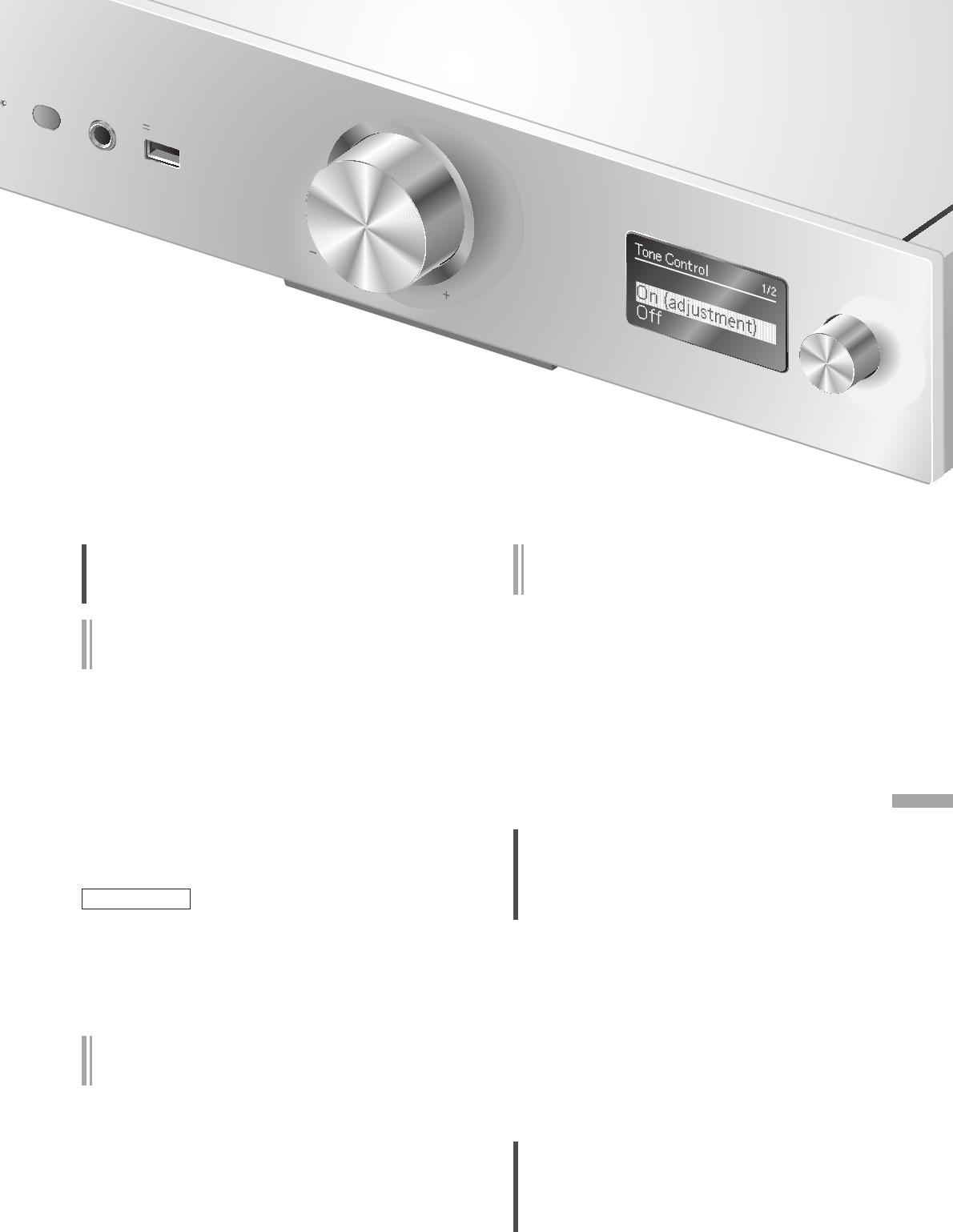
INPUT SELECTOR
VOLUME
5V 2.1A
PHONES
37
Français
Paramètres
Réglages réseau
“Réseau”
Mise en veille réseau
“Veille réseau”
Cette unité peut se mettre en marche en sortant
automatiquement du mode veille lorsqu’elle est
choisie comme enceintes de sortie de l’appareil
réseau.
• Par défaut, cette fonction est réglée sur “Auto”.
Auto :
Active la fonction Veille réseau lorsque la
connexion au réseau est disponible.
Activé :
Active la fonction Veille réseau en permanence.
Remarque
• Si cette fonction est paramétrée sur “Activé”
ou “Auto”, la consommation électrique en veille
augmente.
• Le voyant d’alimentation s’allume rouge lorsque
la fonction Veille réseau est disponible.
Paramétrage LAN sans fil
“Wi-Fi”
La fonction LAN sans fil peut être activée ou
désactivée.
• Par défaut, cette fonction est réglée sur
“Désactivé”.
Puissance du signal Wi-Fi
“Niveau du signal”
Pour contrôler la puissance du signal Wi-Fi là où
ce système se trouve.
• Une puissance de signal à “3” est
recommandée. Modifiez la position ou l’angle
de votre routeur sans fil ou de ce système
si le voyant indique “2” ou “1” et voyez si la
connexion est meilleure.
• Si “0” est affiché, cela indique que le système
ne peut pas établir de lien avec le routeur sans
fil.
Modification du codage de
caractères
“Caract. Asie Est”
Vous pouvez modifier le codage de caractères
des noms de pistes, des noms d’artistes, et
d’autres informations lorsqu’elles ne s’affichent
pas comme elles le devraient.
Type 1(⽇本) :
La priorité est donnée au japonais. (paramètre
par défaut)
Type 2(简体字) :
La priorité est donnée au chinois (simplifié).
Vérification de la version du logiciel
en cours
“Vers. microl.”
La version du micrologiciel installé est affichée.
(83)
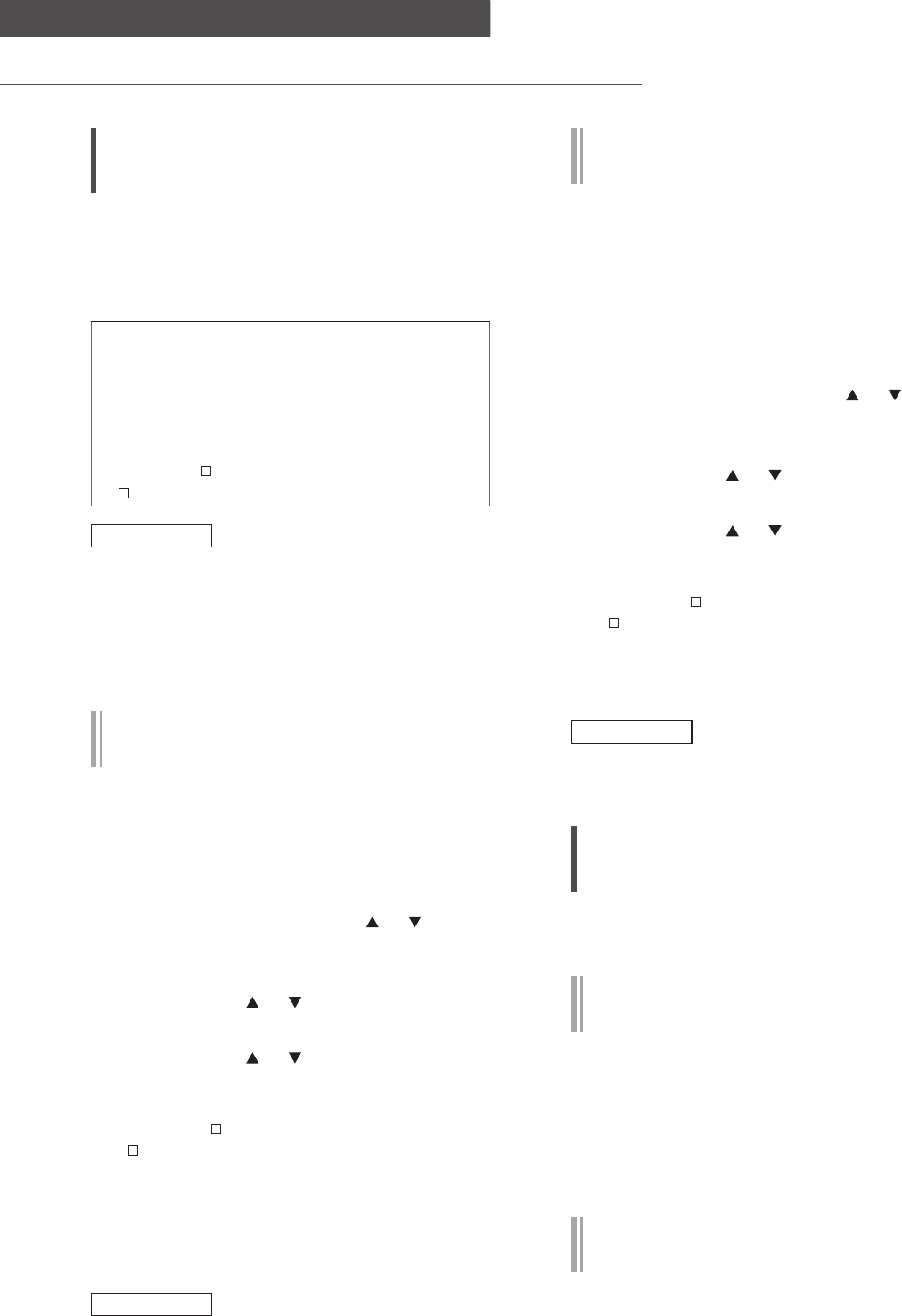
38
Paramètres
Réglage du son, autres paramètres (suite)
Mises à jour du micrologiciel
“MàJ microl.”
Panasonic diffuse à l’occasion des mises à jour du
micrologiciel de cet appareil qui peuvent ajouter
des fonctionnalités ou améliorer celles en place. Ces
mises à jour sont mises à votre disposition sans frais.
Le téléchargement nécessite environ
10 minutes.
Ne débranchez pas le cordon
d’alimentation secteur et ne mettez pas
cette unité en veille pendant la mise à jour.
• La progression est affichée en tant que
“Updating %” pendant la mise à jour.
( représente un chiffre.)
Remarque
• Durant la mise à jour, aucune autre opération
ne peut être effectuée.
• S’il n’y a aucune mise à jour, “Firmware is Up To
Date” s’affiche après l’étape 3.
• La mise à jour du micrologiciel peut réinitialiser
les paramètres.
Mise à jour via Internet
■ Préparatifs
• Connecter cet appareil au réseau. ( 18)
- S’assurer que le réseau sans fil est relié à
Internet.
1 Appuyer sur [SETUP].
2 Appuyer à répétition sur [ ], [ ]
pour sélectionner “MàJ microl.”, puis
appuyer sur [OK].
3 Appuyer sur [ ], [ ] pour sélectionner
“Internet”, puis appuyer sur [OK].
4 Appuyer sur [ ], [ ] pour sélectionner
“Oui”, puis appuyer sur [OK].
• La progression est affichée en tant que
“Updating %” pendant la mise à jour.
( représente un chiffre.)
• Une fois la mise à jour faite, “Success”
s’affiche.
5 Débrancher le cordon d’alimentation
secteur et le rebrancher après
3 minutes.
Remarque
• Le téléchargement peut prendre plus de temps
ou ne pas fonctionner correctement en fonction
de l’état de la connexion.
Mise à jour via mémoire flash USB
■ Préparatifs
•
Téléchargez le micrologiciel le plus récent sur une mémoire
USB. Pour plus de détails, référez-vous au site Internet suivant.
www.technics.com/support/firmware/
1 Connecter la mémoire USB avec le
nouveau micrologiciel.
2 Appuyer sur [SETUP].
3 Appuyer à répétition sur [ ], [ ]
pour sélectionner “MàJ microl.”, puis
appuyer sur [OK].
4 Appuyer sur [ ], [ ] pour sélectionner
“USB”, puis appuyer sur [OK].
5 Appuyer sur [ ], [ ] pour sélectionner
“Oui”, puis appuyer sur [OK].
• La progression est affichée en tant que
“Updating %” pendant la mise à jour.
( représente un chiffre.)
•
Une fois la mise à jour faite, “Success” s’affiche.
6
Débrancher le cordon d’alimentation secteur
et le rebrancher après 3 minutes.
Remarque
• Le téléchargement peut être plus long en
fonction de la mémoire USB.
Réglage du son
Les effets sonores suivants peuvent être ajoutés
à la sortie audio.
Profiter d’un son audio plus naturel
(Re-master)
La remasterisation étend la bande de lecture et permet
d’obtenir une plus grande profondeur de bit pour reproduire
un son naturel et riche proche de la musique d’origine.
• Le mode d’usine par défaut est “Désactivé”.
Appuyez sur [RE-MASTER] pour
sélectionner “Activé”/”Désactivé”.
Mode Direct
Lorsque ce mode est activé, le signal audio est émis
directement sans utiliser divers circuits de traitement.
• Le mode d’usine par défaut est “Désactivé”.
Appuyez sur [DIRECT] pour sélectionner
“Activé”/”Désactivé”.
(84)

39
Français
Paramètres
Utilisation de la fonction de correction de sortie (LAPC)
(85)
Mesurer le signal de sortie de
l’amplificateur et corriger sa
puissance
■ Préparatifs
• Débranchez les écouteurs.
Tonalité de test émise pendant la mesure
Afin de garantir la précision de la mesure, les
haut-parleurs émettent une tonalité de test à
intervalles réguliers. (Pendant environ 2 minutes)
Vous ne pouvez pas changer le volume de l’audio
émis lorsque la mesure est en cours.
1 Appuyez sur [ ] pour mettre cette
unité en marche.
2 Appuyez longuement sur [LAPC]
jusqu’à ce que “Mesure LAPC”
s’affiche.
Cette unité commence à mesurer le signal
émis par l’amplificateur. Vérifiez qu’une
tonalité de test est émise à la fois depuis les
haut-parleurs gauche et droit.
Lorsque la mesure est terminée, la
correction de sortie de l’amplificateur est
automatiquement activée.
• Si vous appuyez sur [LAPC] alors que la
mesure est en cours, cela l’annule.
• Si vous branchez des écouteurs pendant
la mesure du signal de l’amplificateur ou la
correction de la sortie de l’amplificateur, cela
l’annule.
■ Activer/désactiver la fonction de correction
de sortie
Appuyez sur [LAPC] pour sélectionner
“Activé”/”Désactivé”.
• “Activé”/”Désactivé” s’affiche.
Remarque
• En fonction des haut-parleurs connectés,
l’impact de la fonction de correction de sortie
risque d’être minimal.
• La sortie corrigée s’applique jusqu’à ce que vous
mesuriez à nouveau le signal de sortie. Lorsque
vous utilisez d’autres haut-parleurs, mesurez à
nouveau.
Vous pouvez effectuer un réglage optimal en fonction
de vos haut-parleurs.

40
Guide de dépannage
(86)
Accumulation de chaleur de cet
appareil
Cet appareil chauffe lorsque le volume est élevé.
Il ne s’agit pas d’une erreur de fonctionnement.
La plus récente version du
micrologiciel est-elle installée ?
Panasonic améliore sans cesse le micrologiciel de
cet appareil afin que ses clients puissent profiter
des technologies les plus récentes. ( 38)
Rétablissement de tous les
paramètres par défaut
Dans les situations suivantes, réinitialiser la
mémoire :
• Absence de réponse aux pressions sur les
touches.
• Pour vider la mémoire et en réinitialiser le
contenu.
1 Appuyer sur [SETUP].
2 Appuyer à répétition sur [ ], [ ]
pour sélectionner “Initialisation”, puis
appuyer sur [OK].
3 Appuyer sur [ ], [ ] pour sélectionner
“Oui”, puis appuyer sur [OK].
• Tous les paramètres sont à nouveau
réglés sur les paramètres par défaut. Il est
nécessaire de régler à nouveau les mémoires.
4 Appuyer sur [ ], [ ] pour sélectionner
“Oui” puis appuyer à nouveau sur
[OK].
Généralité
L’unité ne fonctionne pas.
Les opérations ne sont pas effectuées
correctement.
• L’un des appareils de sécurité de l’unité est
peut-être désactivé.
Appuyez sur [ ] sur l’unité pour la mettre
en veille.
• Si l’unité ne se met pas en veille, appuyez
sur [ ] sur l’unité pendant au moins
5 secondes. La mise en veille de l’unité est
forcée.
Sinon, déconnectez le cordon d’alimentation
secteur, attendez au moins 3 minutes, puis
rebranchez-le.
Appuyez sur [ ] sur l’unité pour la mettre
en marche. Si l’unité ne fonctionne toujours
pas, consultez votre détaillant.
Un “bourdonnement” se fait entendre à la
lecture.
• Un cordon d’alimentation secteur ou une lampe
fluorescente se trouve près des câbles. Éloignez
les autres appareils et les autres cordons des
câbles de ce système.
• Un fort champ magnétique situé près d’un
téléviseur ou d’un autre dispositif pourrait
réduire la qualité de l’audio. Éloignez cet
appareil de tels dispositifs.
• Il est possible que les enceintes émettent un
son lorsqu’un dispositif proche émet de fortes
ondes radio, comme lorsqu’un téléphone
cellulaire reçoit un appel.
Aucun son.
• Vérifiez le volume de cette unité.
• Vérifiez les branchements des haut-parleurs et
des autres équipements.
Après avoir vérifié les branchements, mesurez le
signal de sortie de l’amplificateur. ( 39)
• Vérifiez que la source entrante correcte est
sélectionnée.
• Insérez les fiches des câbles à brancher jusqu’au
bout.
• La lecture de contenu multicanal n’est pas prise
en charge.
• Les prises d’entrée audio numérique de cet
appareil peuvent seulement détecter les signaux
PCM linéaires. Pour plus de détails, référez-vous
au mode d’emploi du périphérique.
Avant de demander de l’aide, procédez aux vérifications suivantes. Si vous n’êtes pas sûr de certains
points de vérification, ou si les solutions indiquées dans ce guide ne résolvent pas le problème, consulter
votre revendeur.

41
Français
Guide de dépannage
La lecture ne se lance pas.
• Selon votre environnement ou vos dispositifs
branchés, il est possible que cela prenne un
certain temps.
• Vérifiez si le format du fichier est compatible.
Pour en savoir plus sur le format pris en charge,
consulter “Format du fichier”. ( 49)
Cette unité se met automatiquement en
veille.
• La fonction de mise hors contact automatique
est-elle activée ? ( 36)
• Cet appareil contient un circuit de protection
afin d’éviter tout endommagement dû à une
accumulation de chaleur. Lorsque vous utilisez
cet appareil à un niveau de volume élevé
pendant une période prolongée, il est possible
qu’il se mette automatiquement hors marche.
Attendez que cet appareil refroidisse avant de le
mettre à nouveau en marche. (Pendant environ
3 minutes)
Le son est interrompu.
• Selon votre environnement, l’audio peut
se couper pendant la lecture. Vérifiez les
instructions d’utilisation de l’appareil connecté
et la connexion de l’appareil.
Les paramètres sont réinitialisés aux
paramètres par défaut.
• La mise à jour du micrologiciel peut réinitialiser
les paramètres.
USB
L’appareil USB ou son contenu ne peut pas
être lu.
• Le format de l’appareil USB ou de son contenu
n’est pas compatible avec le système. ( 45)
Il ne se passe rien en appuyant sur [ ].
• Débranchez le dispositif USB et le rebrancher.
Sinon, mettez l’unité en veille et rallumez-la.
L’appareil USB fonctionne au ralenti.
• Les fichiers lourds et les appareils USB à grande
mémoire prennent plus de temps à être lus.
• Cela peut prendre du temps s’il y a beaucoup de
pistes ou de dossiers dessus.
iPhone/iPad/iPod
Utilisation impossible.
• Choisir “USB” comme source d’entrée.
( 29)
• Vérifier que l’iPhone/iPad/iPod est bien
connecté. ( 29)
• La batterie de l’iPhone/iPad/iPod est à plat.
Recharger la batterie. ( 29)
• Connecter de nouveau l’iPhone/iPad/iPod ou
essayer de le redémarrer.
L’iPhone/iPad/iPod ne se recharge pas.
• Le chargement commence à partir de la
connexion avec le câble USB uniquement
lorsque l’unité est en marche.
• S’assurer que l’appareil est en marche lorsque le
chargement est lancé.
- Lors du chargement d’un iPhone/iPad/iPod
dont la batterie est épuisée, ne pas mettre
cet appareil en mode veille tant que l’iPhone/
iPad/iPod ne fonctionne pas à nouveau.
Bluetooth®
Le couplage n’est pas possible.
• Vérifier l’état du dispositif Bluetooth®.
La connexion du dispositif n’est pas possible.
• Le couplage a échoué ou l’enregistrement a été
écrasé. Ressayer le couplage.
• Cet appareil pourrait être connecté à un autre
dispositif. Déconnecter l’autre dispositif et
ressayer d’effectuer le couplage.
Le dispositif est connecté mais aucun son
n’est entendu sur l’appareil.
• Dans le cas de certains dispositifs Bluetooth®
intégrés, il est nécessaire de régler
manuellement la sortie audio sur “SU-G30”.
Pour plus de détails, se reporter au manuel
d’utilisation du dispositif.
(87)

42
Guide de dépannage
(88)
Le son est interrompu.
• L’appareil se trouve hors de la plage de
communication de 10 m (33 pi). Approchez
l’appareil Bluetooth® de ce système.
• Retirez tout obstacle entre ce système et
l’appareil.
• Les autres appareils utilisant une bande de
fréquence 2,4 GHz (routeur sans fil, micro-
ondes, téléphones sans fil, etc.) créent des
interférences. Approchez l’appareil Bluetooth®
de ce système et éloignez-le des autres
appareils.
• Sélectionnez “Mode1” pour une communication
stable. ( 31)
PC
Le PC ne reconnaît pas cet appareil.
• Vérifiez que votre environnement d’exploitation
est adapté. ( 33)
• Redémarrez l’ordinateur, mettez en veille puis
en marche cette unité, puis rebranchez le câble
USB.
• Utilisez un autre port USB du PC branché.
• Installez le pilote dédié en cas d’utilisation d’un
PC équipé de Windows.
Impossible de trouver les fichiers musicaux
stockés sur le PC.
• Lorsque vous lisez des fichiers musicaux sur un
réseau, ceux qui ne sont pas enregistrés sur
le serveur du réseau ne s’affichent pas. Pour
plus de détails, consultez les instructions de
fonctionnement de votre serveur.
Réseau
La connexion au réseau ne peut être établie.
• Vérifiez la connexion réseau et ses
paramétrages. ( 18)
• Si le réseau est invisible, rendez-le visible tout en
le configurant pour cette unité ou effectuez une
connexion LAN filaire.
• La sécurité Wi-Fi de ce système prend en charge
le WPA2™. Votre routeur sans fil doit donc être
compatible avec WPA2™. Pour obtenir plus de
détails sur les types de sécurité pris en charge
par votre routeur et la façon de modifier les
paramètres, référez-vous au mode d’emploi ou
contactez votre fournisseur d’accès Internet.
• Assurez-vous que la fonction de multidiffusion
du routeur sans fil est activée.
• En fonction de votre routeur, il se peut que le
bouton WPS ne fonctionne pas. Tentez d’autres
méthodes. ( 18)
• Vérifiez la puissance du signal Wi-Fi avec
“Niveau du signal” et ajustez l’emplacement de
cette unité et du routeur sans fil. ( 37)
• L’environnement LAN sans fil ou des
interférences radio dans votre zone peuvent
engendrer des problèmes de connexion.
Dans ce cas, essayez une autre méthode de
connexion. Si le problème persiste, installez une
connexion LAN filaire. ( 18)
Impossible de choisir ce système comme
enceintes de sortie.
• Assurez-vous que les périphériques sont
connectés au même réseau que ce système.
• Reconnectez les périphériques au réseau.
• Mettez le routeur sans fil hors marche et de
nouveau en marche.
• Mettez cette unité en veille puis en marche
et choisissez à nouveau ce système comme
enceintes de sortie.

43
Français
Guide de dépannage
La lecture ne se lance pas.
Le son est interrompu.
• Éloignez si possible les enceintes de cette unité.
• Si vous utilisez la bande 2,4 GHz sur le
routeur sans fil, en même temps que d’autres
périphériques 2,4 GHz, comme des micro-
ondes, des téléphones sans fil, etc., il est
possible que des interruptions de connexion se
produisent. Augmentez la distance entre cette
unité et les appareils en question.
- Si votre routeur sans fil prend en charge la
bande 5 GHz, essayez d’utiliser la bande
5 GHz.
Pour passer à la bande 5 GHz, paramétrez à
nouveau le réseau en utilisant un navigateur
Internet ( 22). Lors de l’étape 5, assurez-
vous de sélectionner le nom de votre réseau
(SSID) pour la bande 5 GHz.
• Ne placez pas ce système à l’intérieur d’une
armoire métallique, elle pourrait bloquer le
signal Wi-Fi.
• Si la lecture s’arrête, vérifiez l’état de la lecture
sur le périphérique.
• Rapprochez ce système du routeur sans fil.
• Si plusieurs dispositifs sans fil sont utilisés
simultanément sur le même réseau sans fil
que cet appareil, essayez de mettre les autres
dispositifs hors marche ou de réduire leur
utilisation du réseau sans fil.
• Reconnectez les périphériques au réseau.
• Mettez le routeur sans fil hors marche et de
nouveau en marche.
• Avec certaines versions de iOS et de iTunes, il
se peut qu’il ne soit pas possible de redémarrer
la lecture AirPlay si le sélecteur est changé (ex.
“CD”) ou si cette unité est en veille pendant
la lecture AirPlay. Dans ce cas, choisissez un
périphérique différent depuis l’icône AirPlay de
l’application Music ou iTunes puis sélectionnez
à nouveau ce système en tant que enceintes de
sortie. ( 26)
• Si les solutions ci-dessus ne corrigent pas le
problème, installez une connexion LAN filaire
pour tous les appareils compatibles DLNA
ayant une borne LAN (cette unité, le stockage
connecté en réseau, le serveur DLNA, etc.).
Le serveur DLNA et son contenu ne
s’affichent pas.
• Le serveur DLNA connecté et son contenu
risquent de ne pas s’afficher correctement selon
l’état du serveur (par exemple, peu après l’ajout
de contenu sur le serveur, etc.). Réessayez plus
tard. Pour plus de détails, référez-vous au mode
d’emploi du serveur DLNA.
Télécommande
La télécommande ne fonctionne pas
adéquatement.
• Les batteries sont déchargées ou mal insérées.
( 14)
• Afin de prévenir le risque d’interférence, ne pas
placer d’objets devant le capteur de signal de
télécommande. ( 12)
• Modifier le code de la télécommande
lorsque d’autres appareils répondent à cette
télécommande. ( 15)
Messages
• Le fichier sélectionné ne peut pas être lu.
• Choisissez un fichier lisible.
- Pour en savoir plus sur le format pris en
charge, consulter “Format du fichier” ( 49)
H/M AUTO
• Cette unité est restée inactive pendant environ
20 minutes et elle va se mettre hors marche
d’ici une minute. Appuyez sur n’importe quel
bouton pour annuler.
Vérification périph.
• L’appareil est en train de vérifier l’iPhone/iPad/
iPod ou un dispositif USB branchés. Une fois ce
message disparu, commencer l’utilisation.
Échec téléch.
• Le téléchargement du logiciel a échoué.
Appuyer sur n’importe quelle touche pour
sortir. Réessayer à un autre moment.
• Le serveur est introuvable. Appuyer sur
n’importe quelle touche pour quitter. S’assurer
que le réseau sans fil est relié à Internet.
Vide
• Le dossier sélectionné est vide. Déplacez des
pistes dans le dossier, et retentez l’opération.
• Le serveur est introuvable sur le réseau. Vérifiez
que le serveur est bien connecté au même
réseau que cet appareil, puis réessayez d’établir
la connexion à cet appareil. ( 18)
Erreur
• L’opération effectuée était la mauvaise. Se
reporter aux instructions, puis recommencer.
Échec
• La connexion au réseau n’a pas été effectuée.
Recommencez le paramétrage. ( 18)
(89)

44
Guide de dépannage
(90)
Une mise à jour du micrologiciel est
disponible
• Le micrologiciel (gratuit) pour cette unité est
disponible.
Appuyez sur [OK].
Appuyez sur [ ], [ ] pour sélectionnez “Oui”,
puis appuyez sur [OK].
• La progression est affichée en tant que
“Updating %” pendant la mise à jour.
( représente un chiffre.)
•
Ne débranchez pas le cordon d’alimentation
secteur et ne mettez pas cette unité en veille
pendant la mise à jour. ( 38)
• Une fois la mise à jour faite, “Réussite”
s’affiche.
Débranchez le cordon d’alimentation secteur
et rebranchez-le après 3 minutes.
“F ” (“ ” représente un chiffre.)
• Il y a un problème avec cet appareil.
- Le volume est-il extrêmement élevé ?
Si c’est le cas, baissez le volume.
- Cet appareil est-il placé dans un endroit
extrêmement chaud ?
Si c’est le cas, déplacez cet appareil vers un
endroit moins chaud et attendez un moment,
puis essayez à nouveau de le mettre en
marche.
Si le problème persiste, notez le numéro affiché,
débranchez le cordon d’alimentation secteur et
consultez votre vendeur.
Éch chrg.
• Le micrologiciel présent sur la mémoire USB ne
peut pas être trouvé.
• Téléchargez le micrologiciel le plus récent sur la
mémoire USB et essayez à nouveau. ( 38)
Pas périph.
• Aucun appareil USB n’est connecté.
• Branchez l’appareil USB à lire. ( 28)
Pas de réseau disponible
• L’appareil n’est pas connecté au réseau.
• Vérifiez la connexion réseau. ( 18)
Non valide
• La fonction que vous avez essayé d’utiliser n’est
pas disponible avec les paramètres actuels.
Vérifiez les étapes et les paramètres.
Patienter
• Ceci s’affiche, par exemple, lorsque cette unité
est en veille/marche. (Pendant environ 1 minute
et 30 secondes)
“Télécom. ” (“ ” représente un chiffre.)
• La télécommande et l’appareil n’utilisent pas les
mêmes codes de commande.
Modifier le code sur la télécommande. ( 15)
Mode téléc.
• Les boutons de commande de lecture de base
sur la télécommande ne sont pas disponibles.
(Lors de la lecture de musique stockée sur le
serveur DLNA avec cette unité (DMR), etc.)
• Utilisez l’appareil connecté pour la commande
de lecture de base.
Recherche
• L’appareil vérifie le serveur DLNA sur le réseau.
Signal débordmt
• L’audio de la borne d’entrée audio analogique
en cours d’utilisation présente une distorsion.
Sélectionnez “Attenuator(LINE)” et changez le
réglage de la borne d’entrée audio analogique
utilisée sur “Activé”. ( 34)
Déverr.
• “PC”, “COAX1”, “COAX2” ou “OPT” est
sélectionné, mais aucun appareil n’est connecté.
Vérifiez la connexion de l’appareil. ( 32, 33)
• Les signaux audio, tels que les composants de
fréquence d’échantillonnage, ne sont pas saisis
correctement.
- Pour en savoir plus sur le format pris en
charge, consulter “Format du fichier” ( 49)
Erreur de surintensité USB
• L’iPhone/iPad/iPod ou le périphérique USB
consomme trop de courant. Débranchez
l’iPhone/iPad/iPod ou le périphérique USB,
mettez l’unité en veille et de nouveau en
marche.
Conf. Wi-Fi
• Sélectionnez “Activé” et appuyez sur [OK] pour
accéder aux paramètres réseau. ( 19)
- Pour quitter les paramètres réseau,
sélectionnez “Désactivé” et appuyez sur [OK].
Concentrat. non p en ch/
Non pris en charge/
Appareil non reconnu/
Appareil USB non pris en charge
• Vous avez branché un iPhone/iPad/iPod ou un
dispositif USB qui n’est pas pris en charge.
- Si l’iPhone/iPad/iPod est compatible, le
mettre en marche avant de l’insérer dans
l’appareil.
• Le format du fichier sur l’iPhone/iPad/iPod ou
sur le dispositif USB n’est pas pris en charge.
- Pour en savoir plus sur le format pris en
charge, consulter “Format du fichier” ( 49)

45
Français
Guide de dépannage / Autres
USB
• Cet appareil ne garantit pas la connexion avec
tous les dispositifs USB.
• Les systèmes de fichiers FAT16 et FAT32 sont
pris en charge.
• Cet appareil prend en charge le USB 2.0 pleine
vitesse.
• Il est possible que certains dispositifs USB ne
soient pas reconnus par cet appareil lorsqu’ils
sont branchés à l’aide des raccordements
suivants :
- un concentrateur USB
- un câble d’extension USB
• Il est également possible d’utiliser des lecteurs/
graveurs de carte USB.
• Cet appareil ne peut pas enregistrer de la
musique sur un dispositif USB.
• Il est possible que tous les fichiers sur l’appareil
USB ne puissent pas être lus, si certains fichiers
ne sont pas pris en charge.
• Pour en savoir plus sur le format pris en charge,
consulter “Format du fichier” ( 49)
iPhone/iPad/iPod
• Panasonic n’assume aucune responsabilité pour
la perte de données et(ou) d’informations.
• iPhone/iPad/iPod compatibles (à compter de
juin 2015)
iPhone 6 Plus / iPhone 6 / iPhone 5s /
iPhone 5c / iPhone 5 / iPhone 4s /
iPad Air 2 / iPad Air /
iPad (3e et 4e générations) / iPad 2 /
iPad mini 3 / iPad mini 2 / iPad mini /
iPod touch (5e génération) /
iPod nano (7e génération)
Remarque
• Ne branchez pas les modèles suivants :
- iPod classic, iPod [4e (affichage couleur), et
5e (vidéo) générations], iPod nano
(1re génération)
Certains incidents imprévus pourraient se
produire.
(91)
Autres
Supports lisibles

46
Autres
À propos de Bluetooth®
(92)
Panasonic décline toute responsabilité
pour la compromission de données ou
de renseignements qui pourrait survenir
pendant une transmission sans fil.
Bande de fréquence utilisée
• Cet appareil fonctionne sur la bande de
fréquence de 2,4 GHz.
Certification de cet appareil
• Cet appareil satisfait aux restrictions en matière
des bandes de fréquences et a été certifié en
vertu des lois sur l’utilisation des bandes de
fréquences. Par conséquent, l’obtention d’un
permis de transmission sans fil n’est pas requise.
• Les actions décrites ci-dessous sont punissables
en vertu de la loi :
- Démontage ou modification du système.
- Retrait des indications relatives aux
spécifications.
Restrictions à l’utilisation
• La liaison sans fil et(ou) l’utilisation avec tous les
dispositifs compatibles avec Bluetooth® ne sont
pas garanties.
• Tous les dispositifs doivent être conformes aux
normes établies par Bluetooth SIG, Inc.
• Selon les spécifications et les paramétrages
d’un dispositif, la connexion pourrait être
impossible ou certaines opérations pourraient
être différentes.
• Cet appareil prend en charge les fonctionnalités
de sécurité Bluetooth®. Cependant, selon
l’environnement d’exploitation et(ou) les
paramétrages, ces mesures de sécurité
pourraient ne pas être suffisantes. La
transmission de données vers cet appareil doit
se faire avec le plus grand discernement.
• Cet appareil ne peut transmettre de données à
un dispositif Bluetooth®.
Rayon d’action
• Utiliser ce dispositif à un distance maximum de
10 m (33 pi). Le rayon d’action peut être réduit
en raison de l’environnement, d’obstacles ou
d’interférence.
Interférence d’autres appareils
• Cet appareil pourrait ne pas fonctionner
adéquatement et des problèmes tels que des
sauts de son et du bruit pourraient survenir
en raison d’ondes électromagnétiques si cet
appareil est placé trop près d’autres dispositifs
Bluetooth® ou des dispositifs fonctionnant sur
la bande de fréquence de 2,4 GHz.
• Cet appareil pourrait ne pas fonctionner
adéquatement si des ondes électromagnétiques
en provenance d’une station émettrice
avoisinante, etc., sont trop fortes.
Utilisation prévue
• Cet appareil est conçu pour un usage général.
• Ne pas utiliser cet appareil près d’un
équipement ou dans un milieu sensible à
l’interférence radio (exemples : aéroports,
hôpitaux, laboratoires, etc.).

47
Français
Autres
■ DONNÉES GÉNÉRALES
Alimentation 120 V c.a./60 Hz
Consommation 96 W
Consommation
électrique en veille
(Veille réseau hors
marche*)
Environ 0,3 W
Consommation
électrique en veille
(Veille réseau en
marche*)
Environ 2,9 W
Dimensions
(L×H×P)
430 mm (16 15/16 po) ×
98 mm (3 7/8 po) ×
424 mm (16 23/32 po)
Poids Environ 11,5 kg (25,4 lb)
Température de
fonctionnement
0 °C à +40 °C
(+32 °F à +104 °F)
Humidité relative 35 % à 80 %
(sans condensation)
* : Quand l’iPod/iPhone/iPad n’est pas en charge.
■ SECTION AMPLIFICATEUR
Puissance de sortie
50 W + 50 W
(1 kHz, D.H.T. 0,5 %, 8 ,
20 kHz filtre LPF)
100 W + 100 W
(1 kHz, D.H.T. 0,5 %, 4 ,
20 kHz filtre LPF)
Impédance de
charge 4 - 16
Réponse de
fréquence
PHONO (MM)
20 Hz à 20 kHz
(DÉVIATION RIAA ±1 dB,
8 )
LINE 5 Hz à 80 kHz
(-3 dB, 8 )
NUMÉRIQUE 5 Hz à 90 kHz
(-3 dB, 8 )
Sensibilité
d’entrée/
impédance
d’entrée
LINE 200 mV / 22 k
PHONO (MM) 2,5 mV / 47 k
■ SECTION BLUETOOTH®
Spécifications
du système
Bluetooth®
Bluetooth® Ver. 3.0
Classification des
appareils sans fil Classe 2 (2,5 mW)
Profils pris en
charge A2DP, AVRCP
Codec compatibles Latence faible aptX®,
AAC, SBC
Bande de
fréquence bande 2,4 GHz FH-SS
Distance de
fonctionnement Environ 10 m (33 pi) Ligne
de vue*
* : Distance de communication prospective
Environnement de mesure :
Température 25 °C (77 °F)/
Hauteur 1,0 m (3,3 pi)
Mesure en “Mode1”
(93)
Spécifications

48
Autres
Spécifications
(94)
■ SECTION PRISES
Prise écouteurs/
casque Stéréo, 6,3 mm (1/4 po)
USB USB avant
Connecteur de type A
Capacité de
mémoire du
support 2 To (max.)
Nombre maximal
de dossiers
(albums) 800
Nombre maximal
de fichiers
(chansons) 8000
Système de
fichiers FAT16, FAT32
Tension du port
USB DC OUT 5 V 2,1 A (max.)
PC USB arrière
Connecteur de type B
Interface Ethernet LAN
(100BASE-TX/10BASE-T)
Entrée analogique
Entrée de ligne Prise à broche
PHONO (MM) Prise à broche
Entrée numérique
Entrée
numérique
optique Borne optique
Entrée
numérique
coaxiale ×2 Prise à broche
Support de
format LPCM
■ SECTION FORMAT
USB-A
Norme USB USB 2.0 grande vitesse
USB à forte
capacité de
stockage
USB-B
Norme USB USB 2.0 grande vitesse
USB spécification
classe audio USD classe audio 2.0,
mode asynchrone
Mode de contrôle
DSD Mode natif ASIO,
mode DoP
■ SECTION Wi-Fi/AirPlay
Norme WLAN IEEE802.11a / b / g / n
Bande de
fréquence
2,4 GHz (1 - 11 ch) /
5 GHz (36, 38, 40, 44,
46, 48, 149, 151, 153,
157, 159, 161, 165 ch)
Sécurité WPA2™,
Mode mixte WPA2™/WPA™
Type d’encodage TKIP / AES
Type
d’authentification
PSK
WEP (64 bit/128 bit)
Version WPS Version 2.0
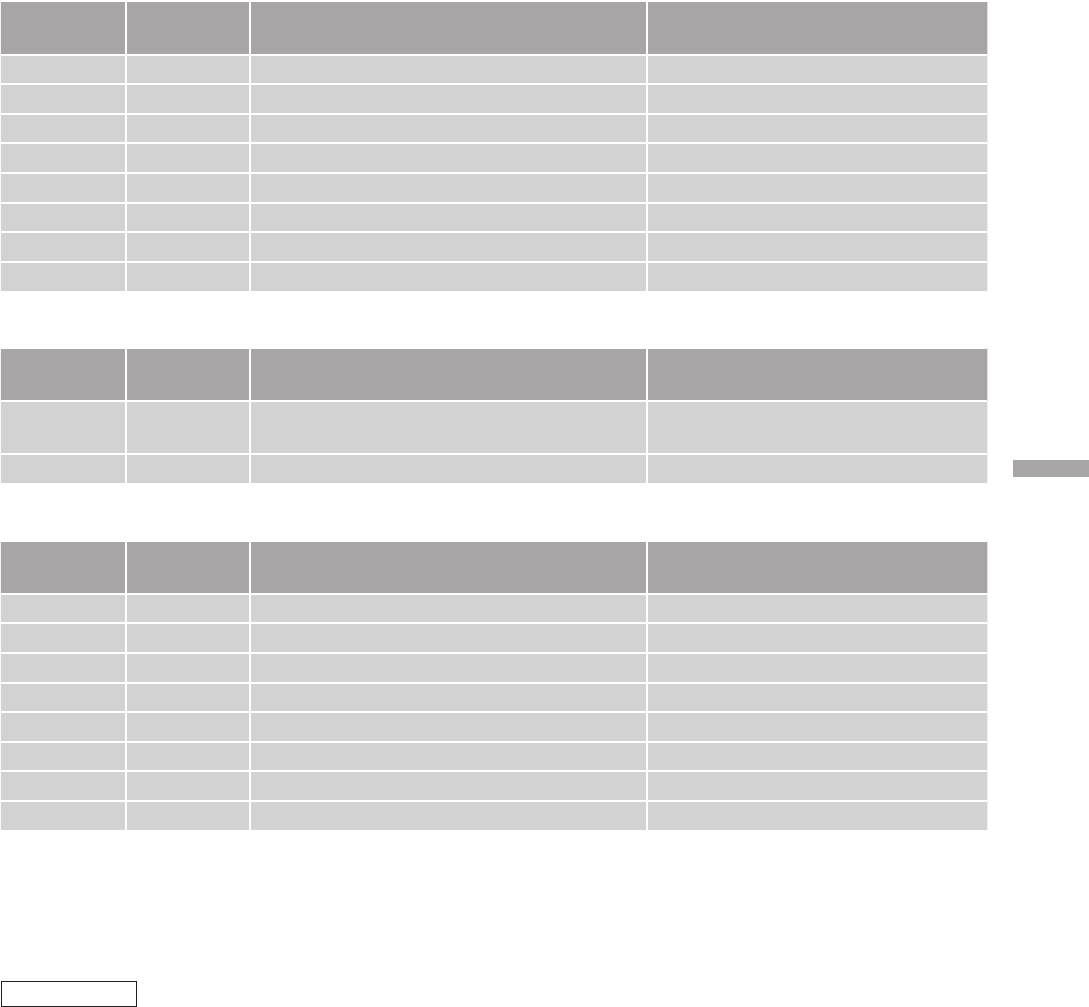
49
Français
Autres
■ Format du fichier
Cet appareil prend en charge les formats de fichiers suivants.
• Cet appareil ne prend pas en charge la lecture de fichiers musicaux interdits de copie.
• La lecture de tous les fichiers dans des formats pris en charge par cet appareil n’est pas garantie.
• La lecture d’un fichier dans un format qui n’est pas pris en charge par cet appareil peut entraîner un son
saccadé ou du bruit. Dans ce cas, vérifier si l’appareil prend en charge le format de fichier.
• Cet appareil ne prend pas en charge la lecture à débit binaire variable (VBR).
• Il est possible que certains des dispositifs connectés (serveurs) soient capables de convertir les fichiers dans
des formats non pris en charge par cet appareil et de les lire. Pour plus de détails, consulter les instructions
de fonctionnement de votre serveur.
• Les informations du fichier (fréquence d’échantillonnage, etc.) affichées par cet appareil et par le logiciel de
lecture peuvent différer.
USB-A
Format du
fichier Extension Fréquence d’échantillonnage Débit binaire /
Nombre de bits de quantification
MP3 .mp3 32/44,1/48 kHz 16 à 320 kbps
AAC .m4a/.aac 32/44,1/48/88,2/96 kHz 16 à 320 kbps
WMA .wma 32/44,1/48 kHz 16 à 320 kbps
WAV .wav 32/44,1/48/88,2/96/176,4/192 kHz 16/24 bits
FLAC .flac 32/44,1/48/88,2/96/176,4/192 kHz 16/24 bits
AIFF .aiff 32/44,1/48/88,2/96/176,4/192 kHz 16/24 bits
ALAC .m4a 32/44,1/48/88,2/96/176,4/192 kHz 16/24 bits
DSD .dff/.dsf 2,8224 MHz/5,6448 MHz
PC (USB-B)*1
Format du
fichier Extension Fréquence d’échantillonnage Débit binaire /
Nombre de bits de quantification
LPCM 32/44,1/48/88,2/96/176,4/192/352,8/
384 kHz 16/24/32 bits
DSD .dff/.dsf 2,8224 MHz/5,6448 MHz/11,2896 MHz
LAN (DLNA)*2
Format du
fichier Extension Fréquence d’échantillonnage Débit binaire /
Nombre de bits de quantification
MP3 .mp3 32/44,1/48 kHz 16 à 320 kbps
AAC .m4a/.aac 32/44,1/48/88,2/96 kHz 16 à 320 kbps
WMA .wma 32/44,1/48 kHz 16 à 320 kbps
WAV .wav 32/44,1/48/88,2/96/176,4/192 kHz 16/24 bits
FLAC .flac 32/44,1/48/88,2/96/176,4/192 kHz 16/24 bits
AIFF .aiff 32/44,1/48/88,2/96/176,4/192 kHz 16/24 bits
ALAC .m4a 32/44,1/48/88,2/96/176,4/192 kHz 16/24 bits
DSD .dff/.dsf 2,8224 MHz/5,6448 MHz
* 1 : Si vous téléchargez et installez l’appli dédiée, vous pourrez lire des fichiers dans de nombreux formats. ( 33)
Pour plus de détails, consulter les instructions de fonctionnement de l’appli.
* 2 : La possibilité de lire chaque fichier musical sur votre réseau dépend du serveur du réseau même si le format du fichier
est indiqué ci-dessus. Par exemple, si vous utilisez le lecteur Windows Media 11, il ne sera pas possible de lire tous les
fichiers musicaux présents sur le PC. Vous pouvez uniquement lire ceux ajoutés à la bibliothèque du lecteur Windows
Media 11.
Remarque
• Spécifications sous réserve de modifications.
• Le poids et les dimensions sont approximatifs.
(95)

50
Autres
Certificat de garantie limitée
Panasonic Canada Inc.
5770, Ambler Drive, Mississauga (Ontario) L4W 2T3
PRODUIT TECHNICS – GARANTIE LIMITÉE
Panasonic Canada Inc. garantit que ce produit est exempt de défauts de matériaux et de main-d’oeuvre dans un contexte
d’utilisation normale pendant la période indiquée ci-après à compter de la date d’achat original et, dans l’éventualité
d’une défectuosité, accepte, à sa discrétion, de (a) réparer le produit avec des pièces neuves ou remises à neuf, (b)
remplacer le produit par un produit neuf ou remis à neuf d’une valeur équivalente ou (c) rembourser le prix d’achat. La
décision de réparer, remplacer ou rembourser appartient à Panasonic Canada Inc.
Lecteur réseau audio avec amplificateur Technics Trois (3) ans, pièces et main-d’oeuvre
Serveur de musique Technics Trois (3) ans, pièces et main-d’oeuvre
Chaîne stéréo avec lecteur CD Technics Trois (3) ans, pièces et main-d’oeuvre
Tourne-disque Technics Trois (3) ans, pièces et main-d’oeuvre
La présente garantie n’est fournie qu’à l’acheteur original d’un des produits de marque Technics indiqués plus haut, ou à
la personne l’ayant reçu en cadeau, vendu par un détaillant Panasonic agréé au Canada et utilisé au Canada. Le produit
ne doit pas avoir été « vendu tel quel » et doit avoir été livré à l’état neuf dans son emballage d’origine.
POUR ÊTRE ADMISSIBLE AUX SERVICES AU TITRE DE LA PRÉSENTE GARANTIE, LA PRÉSENTATION D’UN
REÇU D’ACHAT OU DE TOUTE AUTRE PIÈCE JUSTIFICATIVE DE LA DATE D’ACHAT ORIGINAL, INDIQUANT LE
MONTANT PAYÉ ET LE LIEU DE L’ACHAT, EST REQUISE.
RESTRICTIONS ET EXCLUSIONS
La présente garantie COUVRE SEULEMENT les défaillances attribuables à un défaut des matériaux ou à un vice de
fabrication et NE COUVRE PAS l’usure normale ni les dommages esthétiques. La présente garantie NE COUVRE PAS
NON PLUS les dommages subis pendant le transport, les défaillances causées par des produits non fournis par Panasonic
Canada Inc. ni celles résultant d’un accident, d’un usage abusif ou impropre, de négligence, d’une manutention
inadéquate, d’une mauvaise application, d’une altération, d’une installation ou de réglages impropres, d’un mauvais
réglage des contrôles de l’utilisateur, d’un mauvais entretien, d’une surtension temporaire, de la foudre, d’une
modification, de la pénétration de sable, de liquides ou d’humidité, d’une utilisation commerciale (dans un hôtel, un
bureau, un restaurant ou tout autre usage par affaires ou en location), d’une réparation effectuée par une entité autre
qu’un centre de service Panasonic agréé ou encore d’une catastrophe naturelle.
Les piles sèches sont également exclues de la présente garantie.
CETTE GARANTIE LIMITÉE ET EXPRESSE REMPLACE TOUTE AUTRE GARANTIE, EXPRESSE OU IMPLICITE, INCLUANT
LES GARANTIES IMPLICITES DU CARACTÈRE ADÉQUAT POUR LA COMMERCIALISATION ET UN USAGE PARTICULIER.
PANASONIC CANADA INC. N’AURA D’OBLIGATION EN AUCUNE CIRCONSTANCE POUR TOUT DOMMAGE DIRECT,
INDIRECT OU CONSÉCUTIF RÉSULTANT DE L’UTILISATION DE CE PRODUIT OU DÉCOULANT DE TOUTE DÉROGATION À
UNE GARANTIE EXPRESSE OU IMPLICITE. (À titre d’exemples, cette garantie exclut les dommages relatifs à une perte de
temps, le transport jusqu’à et depuis un centre de service agréé, la perte ou la détérioration de supports ou d’images, de
données ou de tout autre contenu en mémoire ou enregistré. Cette liste n’est pas exhaustive et n’est fournie qu’à des fins
explicatives.)
Certaines juridictions ne reconnaissent pas les exclusions ou limitations de dommages indirects ou consécutifs, ou les
exclusions de garanties implicites. Dans de tels cas, les limitations stipulées ci-dessus peuvent ne pas être applicables.
La présente garantie vous confère des droits précis; vous pourriez aussi avoir d’autres droits pouvant varier selon votre
province ou territoire de résidence.
SERVICE SOUS GARANTIE
Pour tout renseignement sur les produits, réparation ou assistance technique, veuillez visiter notre page Soutien :
www.panasonic.ca/french/support
EXPÉDITION D’UN PRODUIT À UN CENTRE DE SERVICE
Emballez soigneusement, de préférence dans son carton d’origine, et expédiez, franco de port, suffisamment assuré.
Accompagnez le tout d’une description de la défectuosité présumée et d’une pièce justificative de la date d’achat original.
Il est recommandé de noter, dans l’espace prévu ci-
dessous, le numéro de modèle et le numéro de série
inscrits à l’arrière, ou sous le fond de l’appareil, et de
conserver ce manuel pour référence ultérieure.
NUMÉRO DE MODÈLE SU-G30
NUMÉRO DE SÉRIE
Homologation :
DATE D’ACHAT
DÉTAILLANT
ADRESSE DU DÉTAILLANT
N° DE TÉLÉPHONE
(96)

51
Français
Autres
(97)

Panasonic Corporation of North America Panasonic Canada Inc.
Two Riverfront Plaza, Newark, NJ 07102-5490
http://www.panasonic.com
5770 Ambler Drive,
Mississauga, Ontario,
L4W 2T3
www.panasonic.com
©Panasonic Corporation 2015
Printed in Malaysia
Imprimé en Malaisie
En Cf
SQT1063
M1215KZ0